Team Group T-FORCE M200 4TB USB 3.2 Gen2x2 Type-C Portable SSD – Suitable for Gamers & as a Win 11 Boot drive
SSD (Solid State Drive) technology is continually improving and pricing remains reasonable as speeds and capacities increase. SSD technology has become very accessible, and gamers need significantly more capacity as games are getting larger. We received a 4TB T-FORCE M200 Portable SSD from TeamGroup which is a rugged and very fast 2,000MBps Read / 2,000 MBps Write USB Gen 2×2 Type-C SSD.
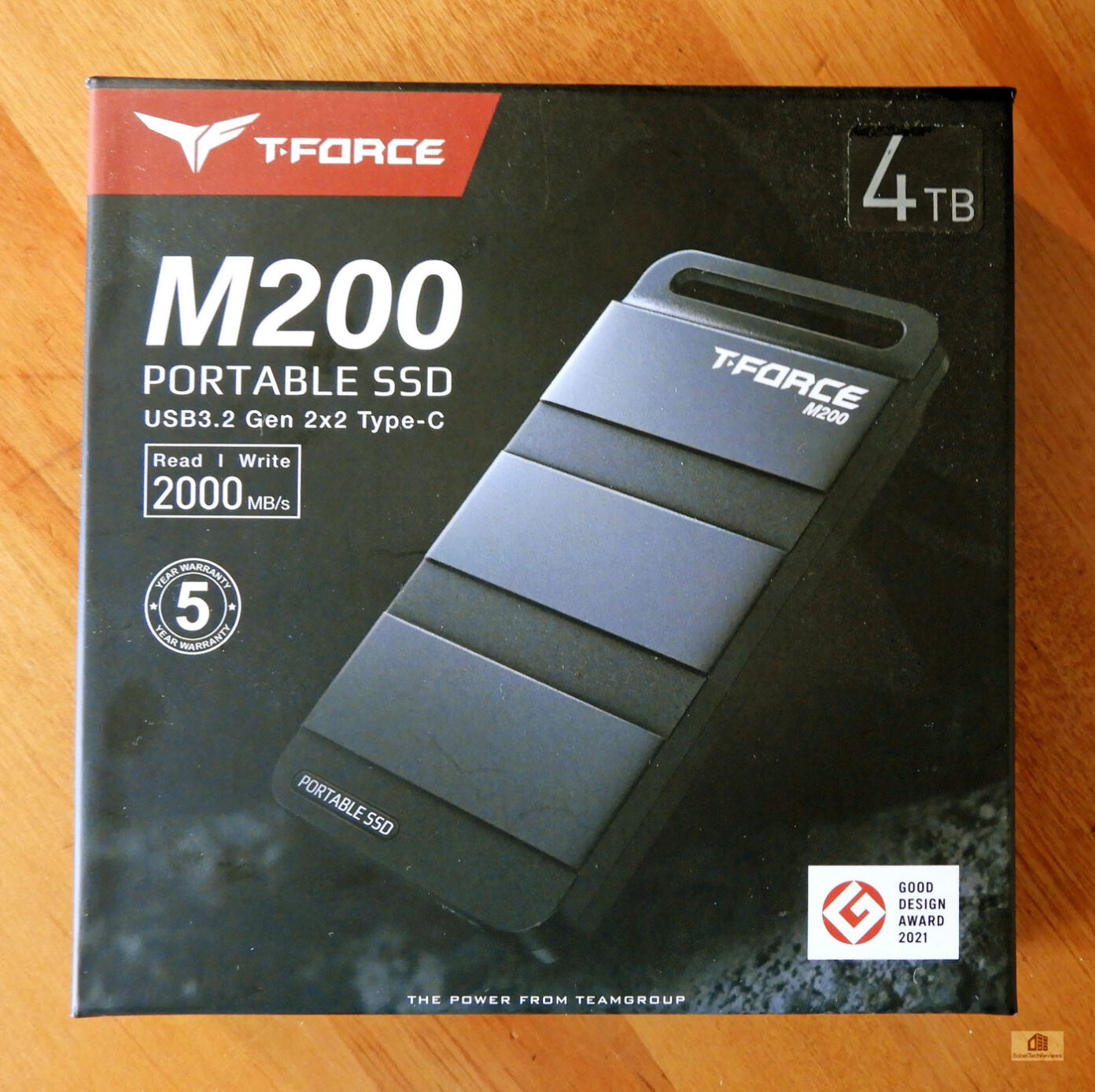
We put the M200 Portable through its paces against five other SSDs to see if it can compete with internal SATA and PCIe NVMe drives. The T-FORCE M200 Portable SSD is available in 2TB, 4TB, and 8TB capacities, and the 4TB version we tested is at Amazon for $593.99 that puts it in a similar price range as other similar portable 4TB SSDs currently available. We will see if 2,000MBps Read / 2,000MBps Write speeds make an external drive practical for gamers as a boot SSD with Windows 11 installed on it besides for game storage.
We will focus on the M200’s performance by comparing it with four other NVMe/PCIe SSDs and a fast SATA III SSD: (1) a fast 7,000MBps/6000MBps 2TB CARDEA A440 NVMe Gen 4×4 drive, (2) a 2TB CARDEA Ceramic C440 (5,000/4400MBps Gen 4 x4), (3) the Gen 4 x3 1TB CARDEA IOPS SSD (3,400/3000MBps), (4) a now midrange TeamGroup 1TB MP33 (1,800/1,500MBps) Gen 3 x4 SSD, and (5) a fast 1TB Delta MAX White RGB (560MBps/510MBps) SATA III SSD.
For comparison, the 1TB SATA III Delta MAX is $129.99 at Amazon and it offers RGB lighting. The TeamGroup 1TB MP33 SSD is $79.97, the T-FORCE CARDEA IOPS is $119.99, the CARDEA Ceramic C440 2TB version is priced at $259, and the CARDEA A440 2TB drive is $328.48. However, once you get into 4TB pricing, the prices increase significantly – the CARDEA A440 priced at $328 for the 2TB version becomes $900 for the 4TB version, and similar competing 4TB portable drives usually sell for over $600.
Here are the features and specifications of the T-FORCE M200 Portable SSD which are taken directly from TeamGroup’s website.
FEATURES
- Tactical, military-style hanging hole. Ultra-light and portable
- Lightning fast speeds of USB 3.2 Gen 2×2 20Gbps transmissions
- Massive 8TB storage for any large audio or video files
- Designs inspired by the M200 sniper rifle
- Dual structure for ultimate cooling
- 2-Meter drop resistant
- Wide compatibility with gaming consoles
Specifications
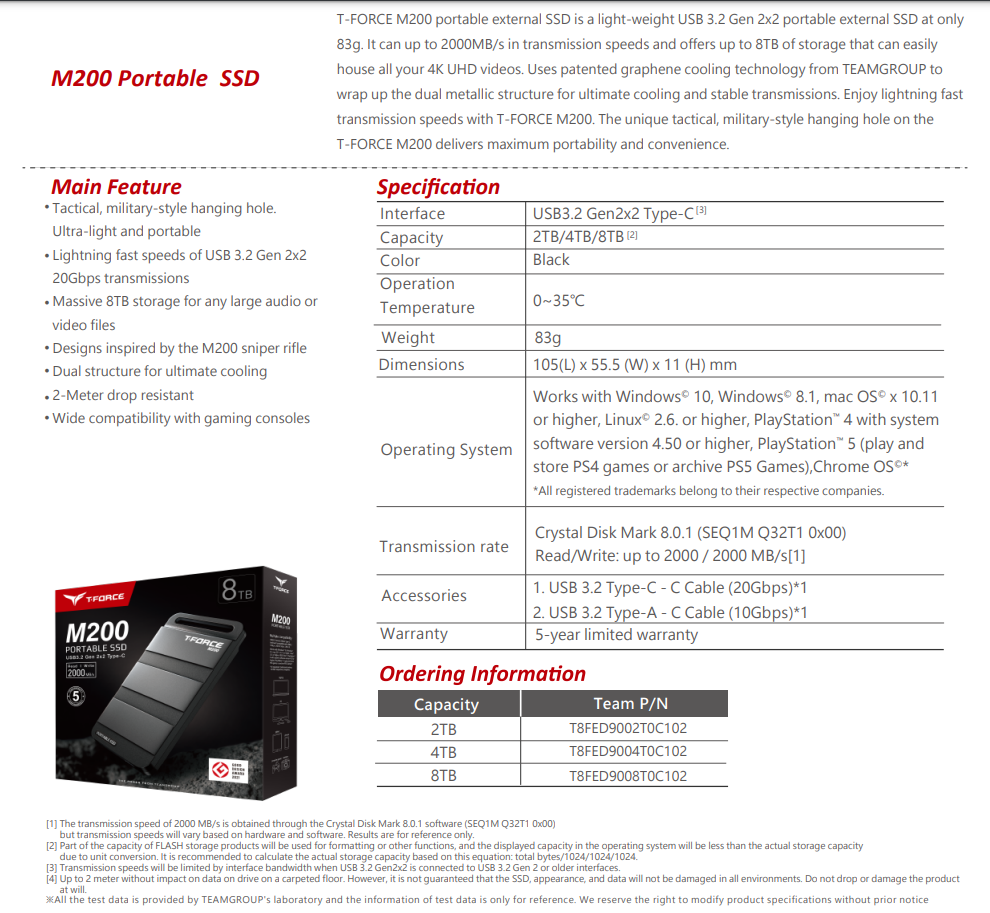
The specifications, based on CrystalDiskMark, boast up to 2,000 Read / 2,000 MB/s Write for all versions which indicate that the speeds are being held back by the USB 3.2 Gen 2×2 specification. Of course, if you have a USB 3.1 or USB 3.2 Type-A interface, your speeds will be much more limited. Unfortunately, the M200 doesn’t have an IP-rating to be water resistant, but it has been tested to withstand falls of 2m on a carpeted floor without impacting stored data.

Source: CheyTac USA
The M200 design appears to be inspired by the M200 Sniper rifle’s detachable box magazine with Picatinny rail motifs designed for the T-FORCE M200 giving it a unique look together with increased surface area for cooling. It uses TeamGroup’s graphene cooling technology inside its dual metallic structure for passive internal SSD cooling and stable data transmission.

The M200 specifications are based on CrystalDiskMark and boast up to 2,000 Read MBps / 2,000 MBps Write for all versions which indicate that its speeds are being held back by the USB 3.2 Gen 2×2 specification as it houses a NVMe SSD inside. According to CrystalDiskInfo, it uses S.M.A.R.T., TRIM, and a VolatileWriteCache that will probably degrade beyond its capacity threshold and isn’t capable of sustaining its write performance until full, but it should still be exceptional for gaming and most applications.
Next we unbox the T-FORCE M200 Portable SSD and take a closer look at it.
Unboxing, Temperatures Under Load, and Installing as C: Drive on Win 11
The TeamGroup T-FORCE M200 Portable SSD comes in a small box that advertises USB 3.2 Gen 2×2 Type-C. Read/Write speeds of 2000MB/s and a 5 year warranty are featured on the front cover. 
Here is the back of the box which advertises its features and warns the buyer that the up to 2,000MB/s transfer speeds can vary according to the interface and are only to be used for basic reference.
Below is a closer look at the M200 SSD in its packaging.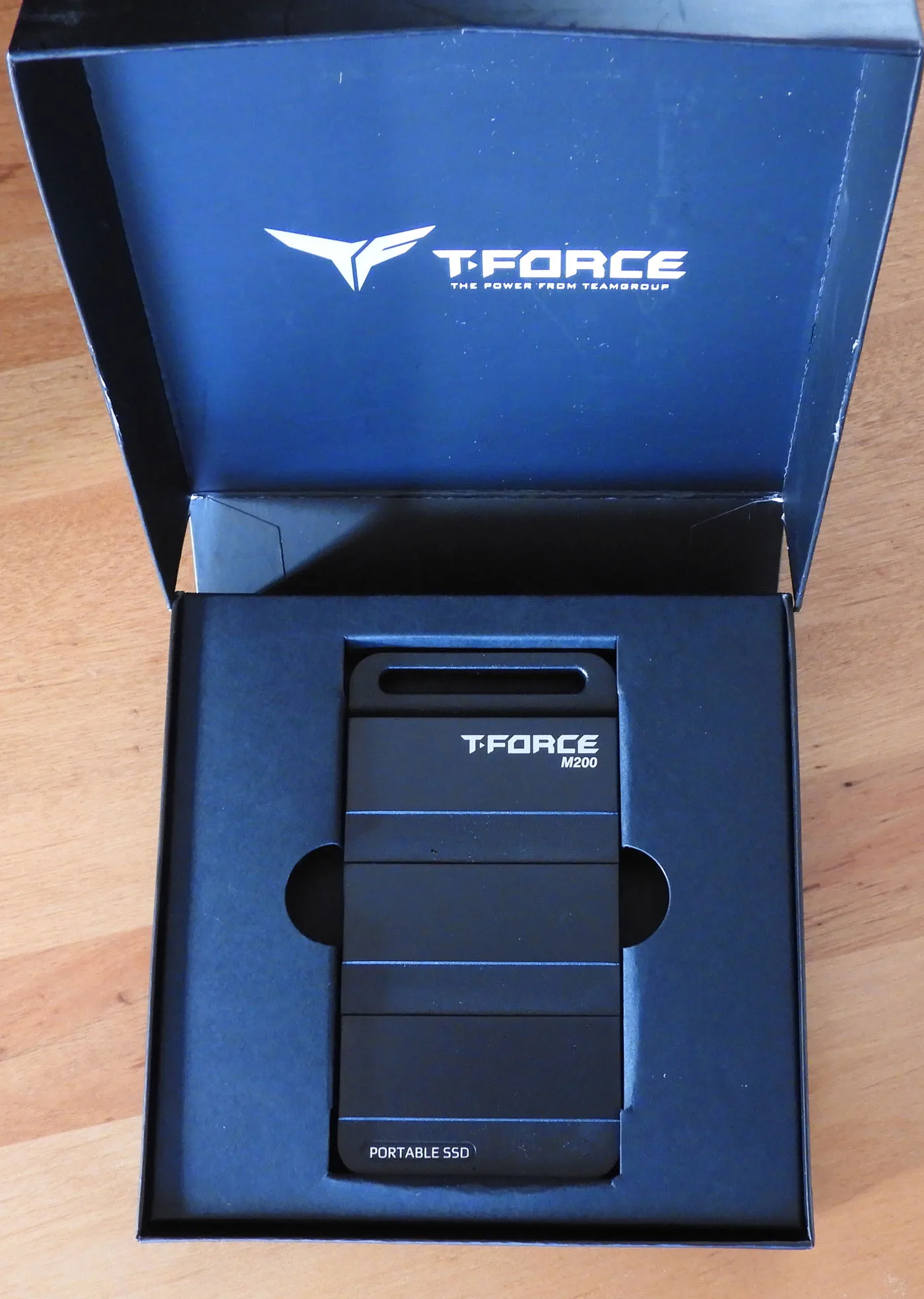 Here is the M200.
Here is the M200. 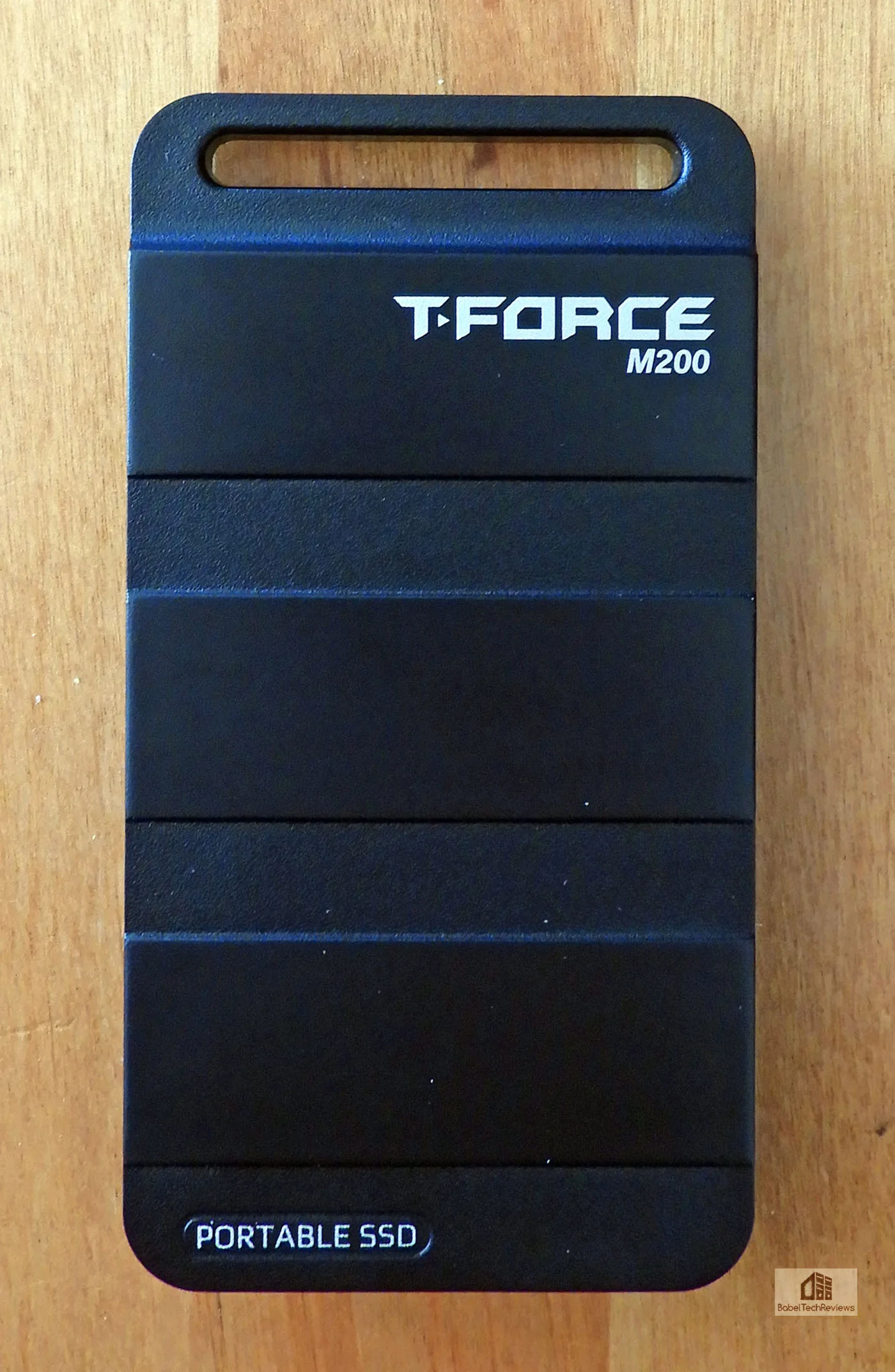
The M200 is ruggedly good-looking and easily attaches to whatever you choose to hang it on. 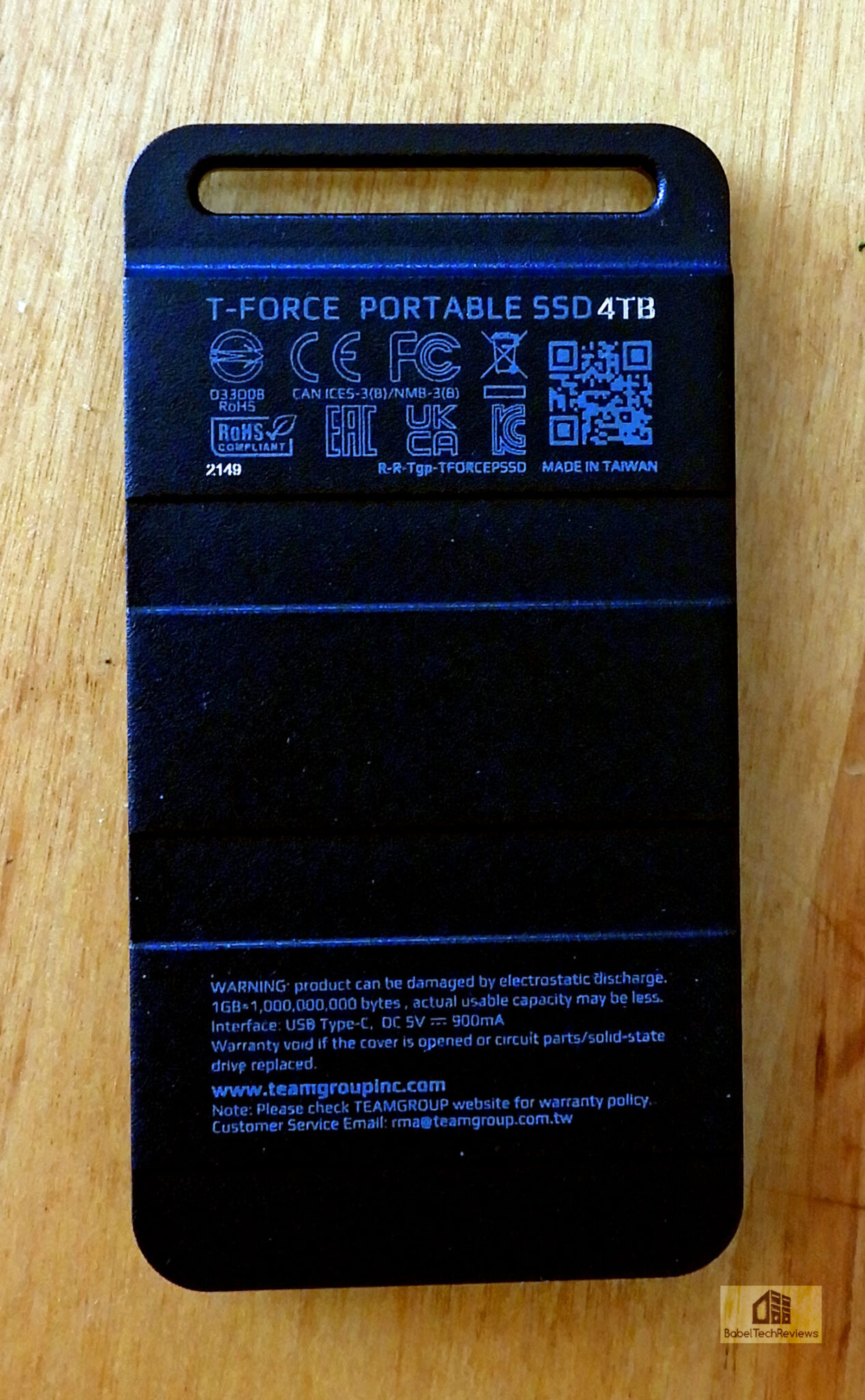
Above, the back of the SSD case warns that it may be damaged by electrostatic discharge and warns against opening the cover. Below, the M200 comes with a Type-C USB cable capable of transmitting 2,000MB/s of data in both directions simultaneously. The other Type-A USB cable is limited to 1,000MB/s.

The M200 is approximately the same size as a SATA III drive, but the 4TB version weighs more at 87g or just over 3 ounces.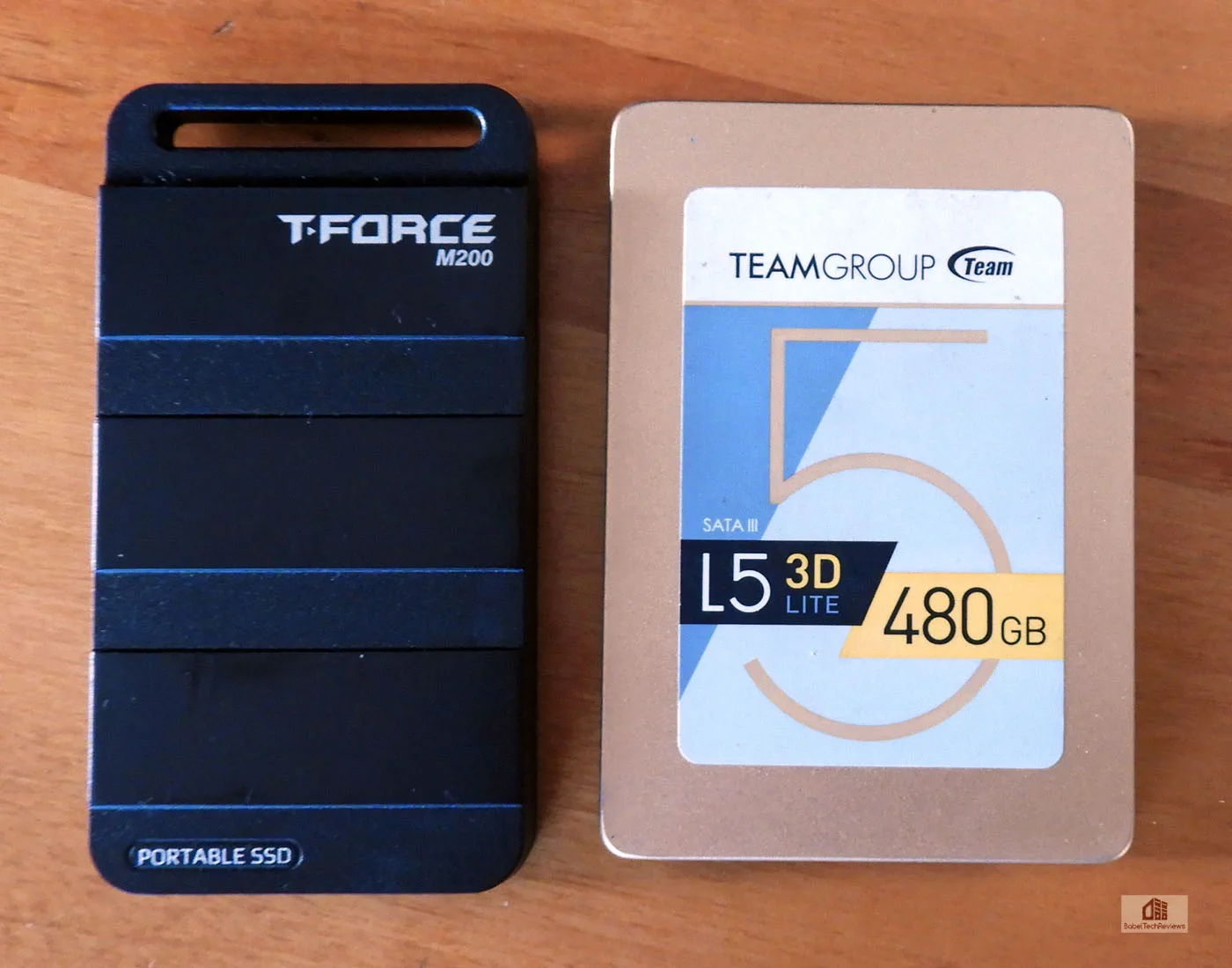
 The M200 is slightly thicker than a SATA III internal drive.
The M200 is slightly thicker than a SATA III internal drive.
Temperatures
We measured the temperatures using Crystal Disk Info and Hardware Info 64 which were in agreement. The highest temperature we saw under the most stressful (cloning or stress test benchmarking) conditions reached 69C internally and 70C externally which indicate that the external body of the M200 works to cool the SSD inside it. Most of the time, the temperatures remained low in the 40s-50s C.
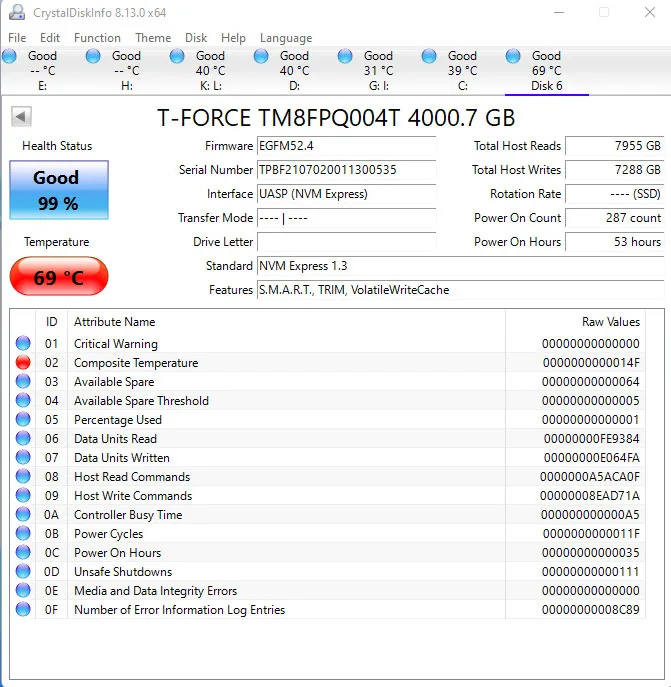 After installing the M200, the user may need to format it before use. If you are planning to clone it, make sure both disks are GUID or convert one of them first. However, you may have issues using the M200 as a boot or C: Drive for Windows 11, either if you clone it from another drive or attempt to install Win on it directly.
After installing the M200, the user may need to format it before use. If you are planning to clone it, make sure both disks are GUID or convert one of them first. However, you may have issues using the M200 as a boot or C: Drive for Windows 11, either if you clone it from another drive or attempt to install Win on it directly.
Using the M200 USB drive as a Windows 11 C: drive
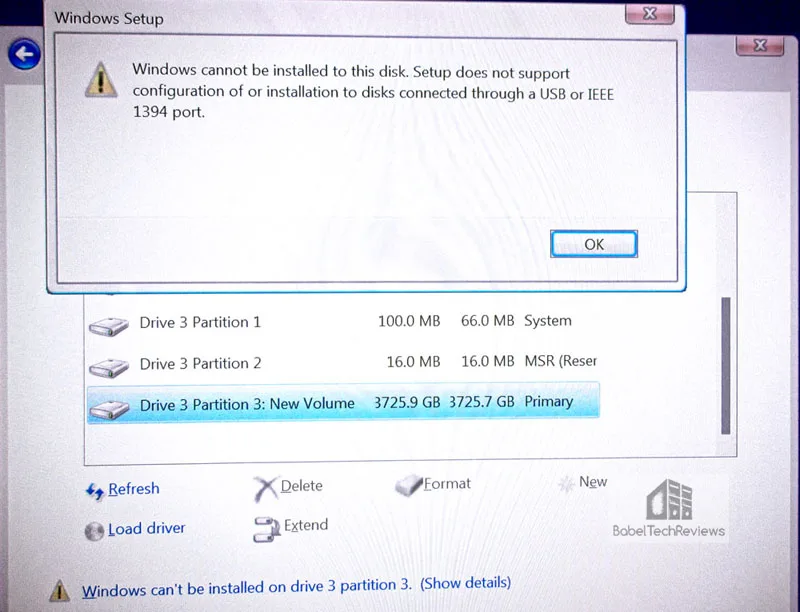
Fortunately, there is a workaround, Rufus.
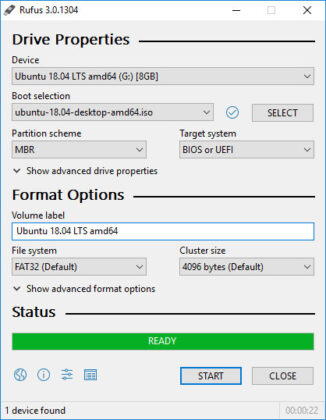
Rufus is on Github which allows a user to easily and automatically create a bootable Windows 11 USB drive. We used the M200 both as a C: Drive as well as for game storage to load games to our fastest 7,000MBps CARDEA A440 drive. All of the benchmarks were tested with the M200 as a boot drive as well as for storage and the speeds were consistent.
Lets look at our test configuration next.
Test Configuration – Hardware
- Intel Core i9-12900KF (HyperThreading and Turbo boost at stock settings).
- ASUS ROG Maximus Apex motherboard (Intel Z690 chipset, latest BIOS with Resizable BAR enabled, PCIe 5.0/4.0/3.1/3.1 – USB 4.0 Type-C specification)
- T-FORCE DELTA 2x16GB DDR5 6400MHz CL40, supplied by TeamGroup
- GeForce RTX 3080 Ti, supplied by NVIDIA
- T-FORCE M200 Portable USB 3.2 Gen 2×2 Type-C 4TB SSD, supplied by TeamGroup
- T-FORCE CARDEA A440 1TB M.2 NVMe PCIe 4.0 SSD, supplied by TeamGroup
- T-FORCE CARDEA Ceramic C440 2TB PCIe Gen 4 x4 NVMe SSD
- T-FORCE CARDEA IOPS 1TB PCIe Gen 4 x3 NVMe SSD, supplied by TeamGroup
- TeamGroup MP33 1TB NVMe Gen 3 x4 PCIe SSD
- T-FORCE DELTA MAX White 1TB SATA III SSD, supplied by TeamGroup
- Super Flower LedEx, 1200W Platinum 80+ power supply unit
- MSI MAG Series CORELIQUID 360R (AIO) 360mm liquid CPU cooler
- Corsair 5000D ATX mid-tower (plus 1 x 140mm fan; 2 x 120mm Noctua fans)
- BenQ EW3270U 32? 4K HDR 60Hz FreeSync monitor
- LaserGrip 774 Infrared thermometer by Etekcity
Test Configuration – Software
- Nvidia’s GeForce 496.98 WHQL drivers. High Quality, prefer maximum performance, single display
- Gaming results show loading time in seconds and lower is better
- Windows 11 Professional edition; latest updates/build
- Latest DirectX
- All benchmarking programs are updated to their latest versions
- IOmeter
- S.M.A.R.T. Tool (TeamGroup)
- Rufus
PC Game & Level Loading Suite
- PCMark 8 (World of Warcraft & Battlefield 3)
- Final Fantasy XIV: Shadowbringers Benchmark – loading times of five different levels
- Final Fantasy XIV: Endwalker Benchmark – loading times of five different levels
- 3DMark Storage Benchmark (Battlefield V, Call of Duty, Overwatch)
Synthetic Benching Tests & Suites
- SiSoft Sandra 2020/2021
- AIDA64
- PCMark 10 Pro version courtesy of UL (Full Storage Benchmark, Express, Extended)
- PCMark 8
- SPECworkstation3 (3.0.4) Benchmarks
- Anvil’s Storage Utilities
- CrystalDiskMark
- TxBENCH Basic
- HD Tune
- AS SSD
- ATTO
- HD Tach
- 100GB File Copy Timed Test
Let’s head to our benching results.
Benchmarking the M200 Portable SSD
Benchmarking SSDs are not an exact science as there is variability between runs, and different benchmarks may show different results depending on how they run their tests and how up-to-date the benchmarks are. However, by using enough real world and synthetic tests, it may be possible to get a good idea of the relative performance across all six tested drives. For benchmark results, the drives are listed in the following order on the charts:
- T-FORCE M200 M.2 Portable Type C USB 3.2 Gen 2×2 SSD
- T-FORCE CARDEA A440 M.2 NVMe PCIe 4.0 Gen 4 x4 SSD
- T-FORCE CARDEA Ceramic C440 1TB PCIe 4.0 Gen 4 x4 NVMe SSD
- T-FORCE CARDEA IOPS 1TB PCIe Gen 3 x4 NVMe SSD
- TeamGroup MP33 1TB NVMe Gen 3 x4 PCIe SSD
- T-FORCE Delta MAX SATA III 1TB SSD
We did not set up Windows on the DELTA MAX SSD, so not all of the benchmarks could be run on it. All of the drives will have their results summarized in multiple charts. Let’s start first with TeamGroup’s own S.M.A.R.T. utility to get information on each tested SSD.
S.M.A.R.T.
This TeamGroup S.M.A.R.T. utility tests each drive using two different sets of tests.
First up, the T-FORCE M200 Portable dual performance tests starting with MB/s.

Next the M200 performance dual test results given in IOPS.
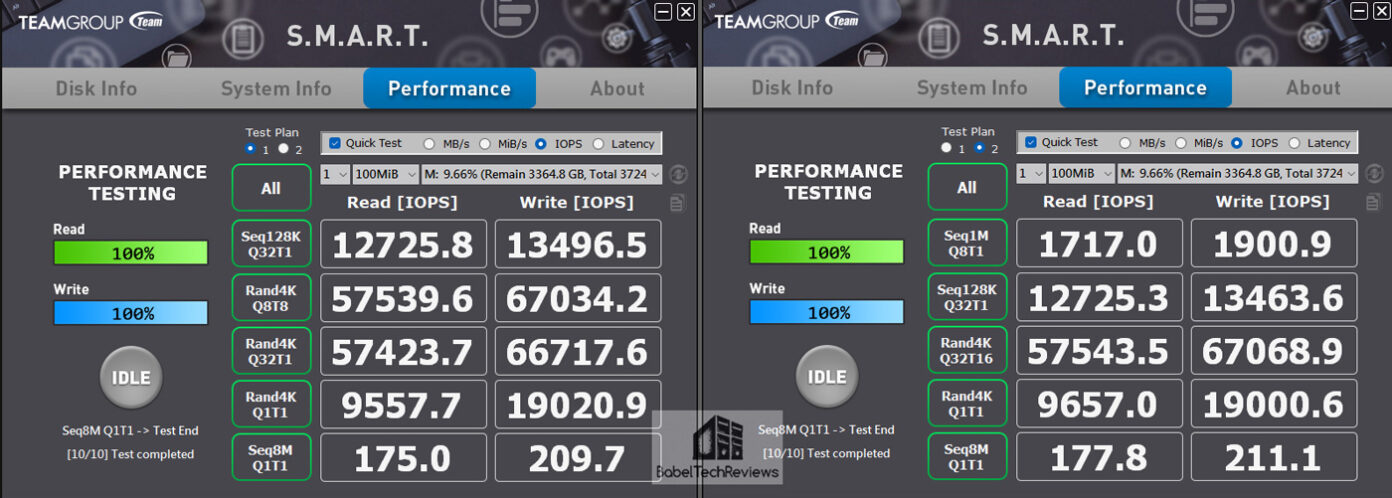
S.M.A.R.T. also measures the M200’s latency.

Now the CARDEA A440 dual performance tests starting with MB/s.  Next, the CARDEA A440 performance dual test results given in IOPS.
Next, the CARDEA A440 performance dual test results given in IOPS. 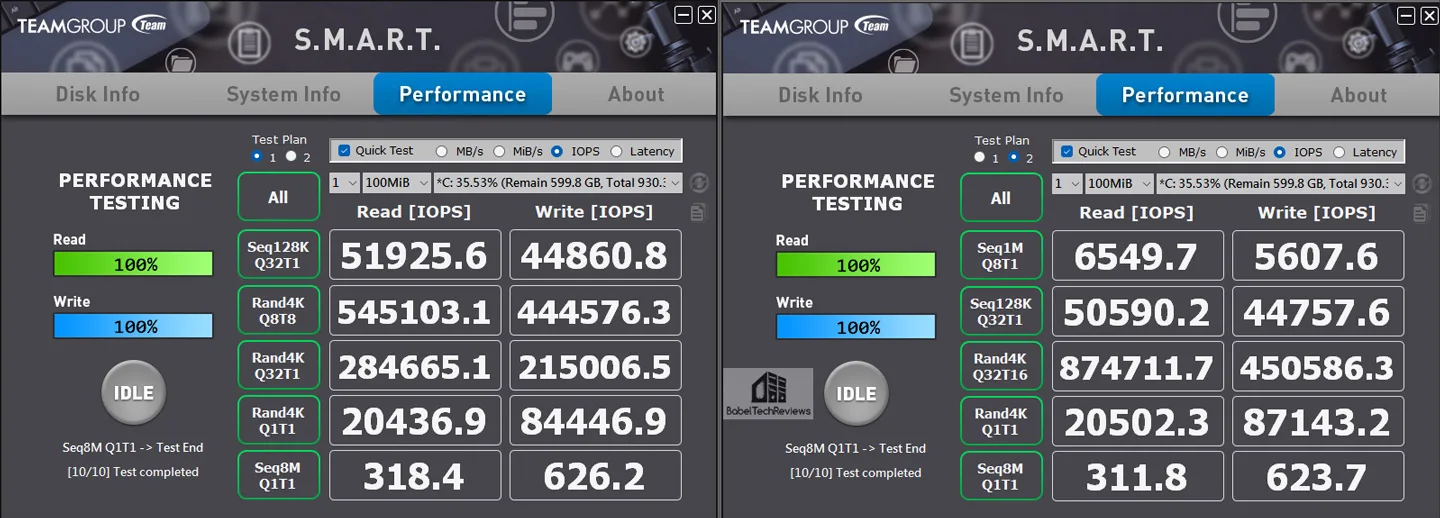 S.M.A.R.T. also measures the CARDEA A440 latency.
S.M.A.R.T. also measures the CARDEA A440 latency. 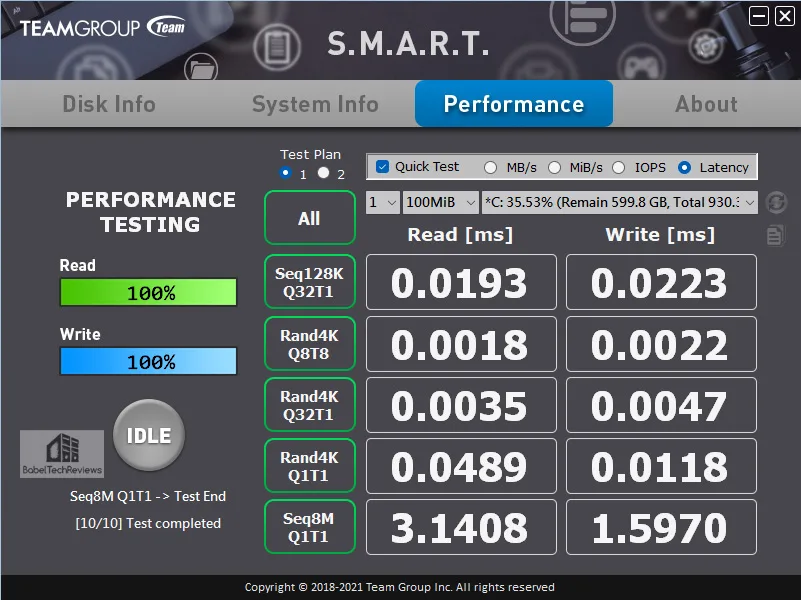 Below are the performance tests in MB/s for the T-FORCE CARDEA Ceramic C440.
Below are the performance tests in MB/s for the T-FORCE CARDEA Ceramic C440. 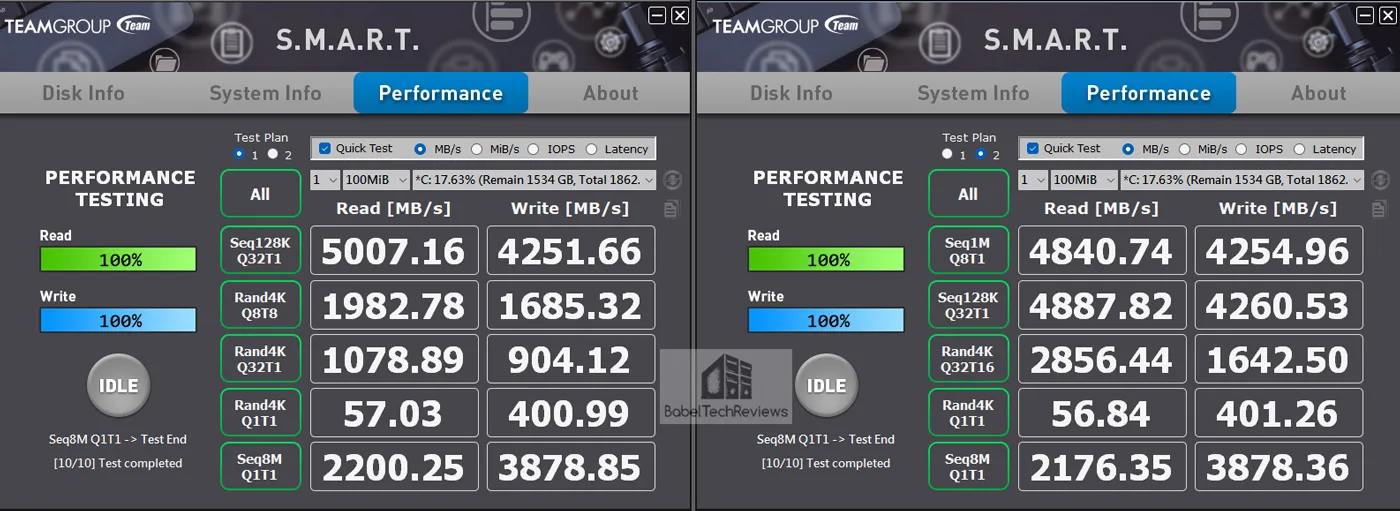 Next the CARDEA Ceramic performance dual test results given in IOPS
Next the CARDEA Ceramic performance dual test results given in IOPS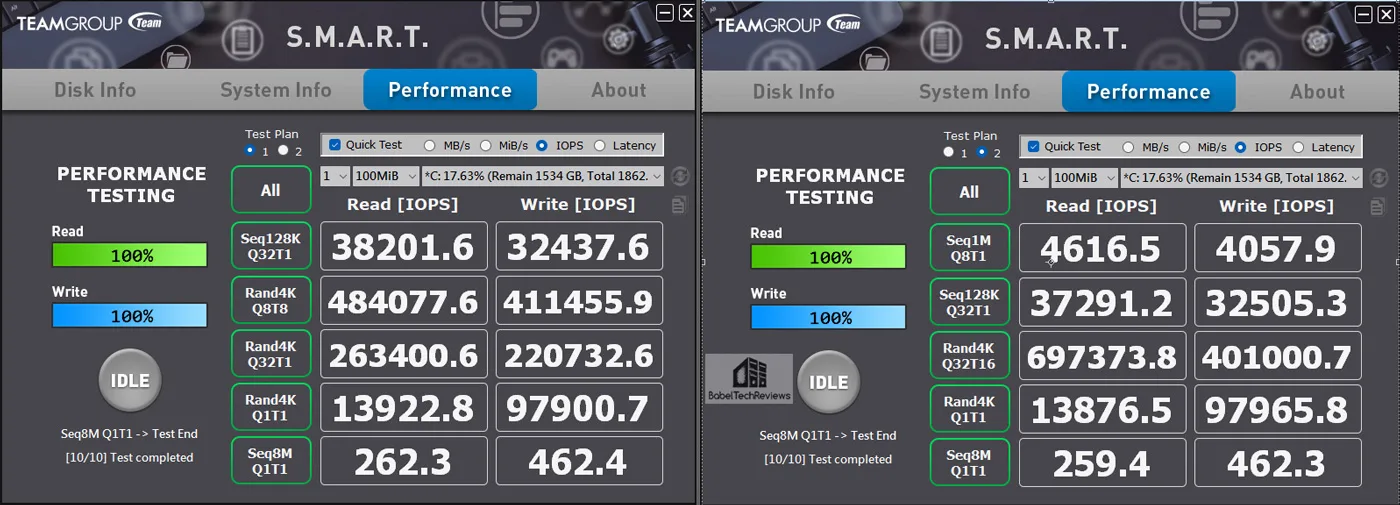 Finally, the S.M.A.R.T. tool measures latency for the CARDEA Ceramic C440.
Finally, the S.M.A.R.T. tool measures latency for the CARDEA Ceramic C440. 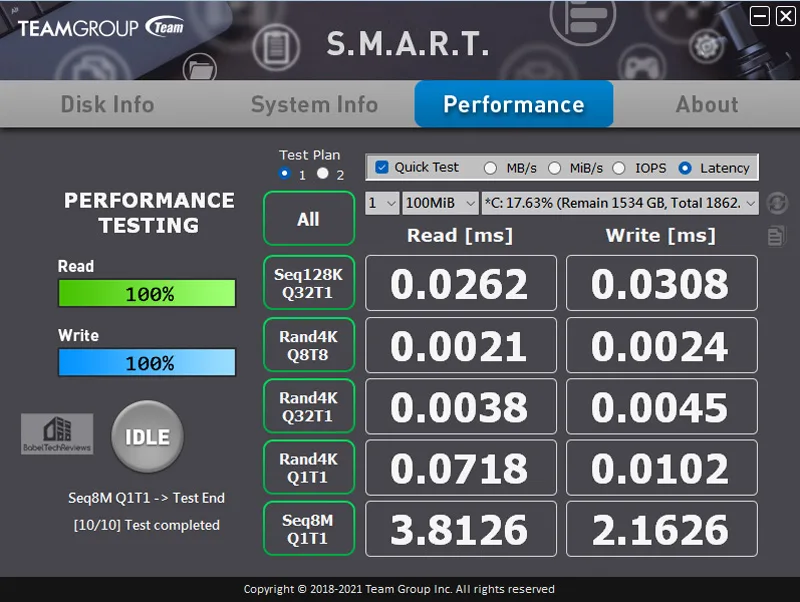 Here are the dual performance tests in MB/s for the T-FORCE CARDEA IOPS.
Here are the dual performance tests in MB/s for the T-FORCE CARDEA IOPS.  Next we look at the performance tests in IOPS for the CARDEA IOPS
Next we look at the performance tests in IOPS for the CARDEA IOPS 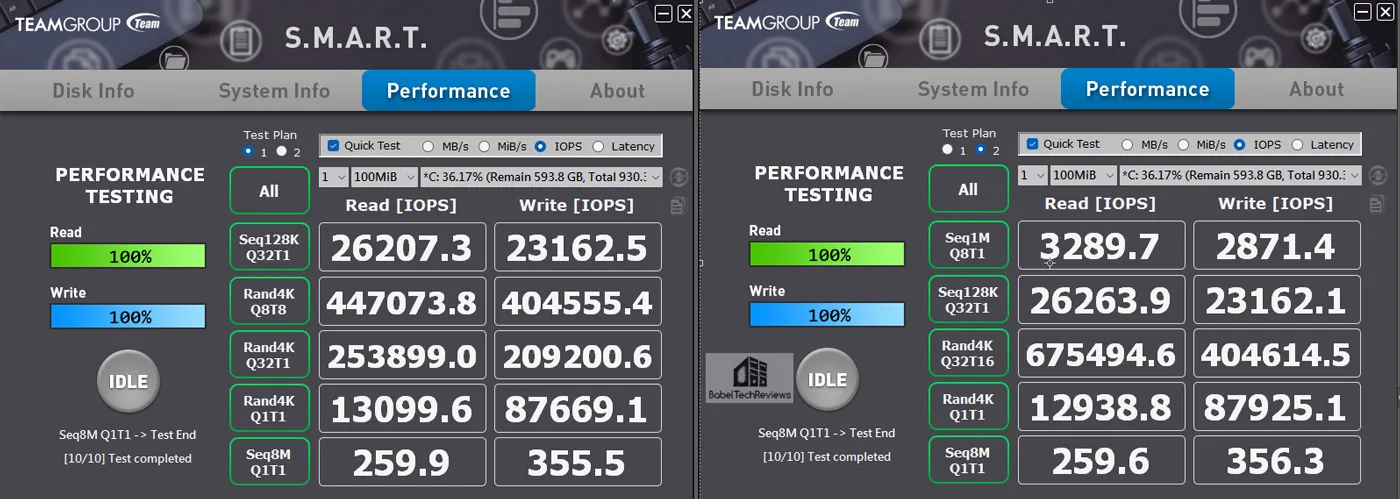 S.M.A.R.T. next measures latency for the CARDEA IOPS.
S.M.A.R.T. next measures latency for the CARDEA IOPS. 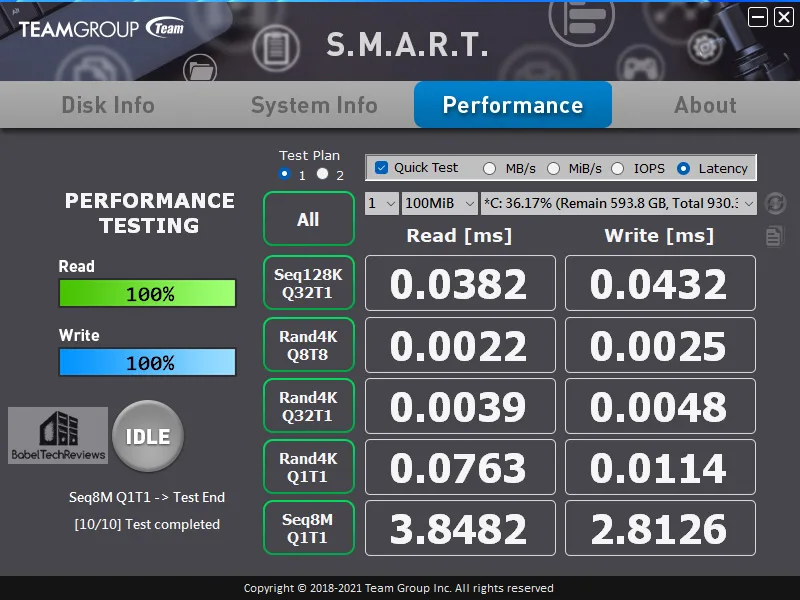 Below we look at the performance tests in MB/s for the TeamGroup MP33 SSD.
Below we look at the performance tests in MB/s for the TeamGroup MP33 SSD.  Next, we look at the performance tests in IOPS for the TeamGroup MP33 SSD
Next, we look at the performance tests in IOPS for the TeamGroup MP33 SSD 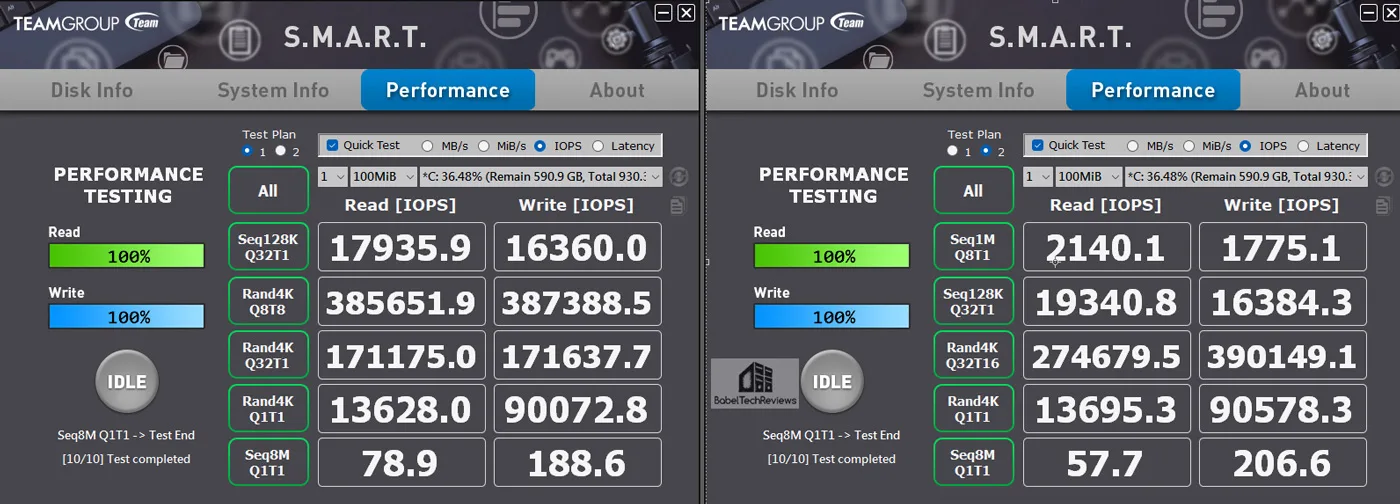 Now the dual latency tests for the MP33 SSD.
Now the dual latency tests for the MP33 SSD. 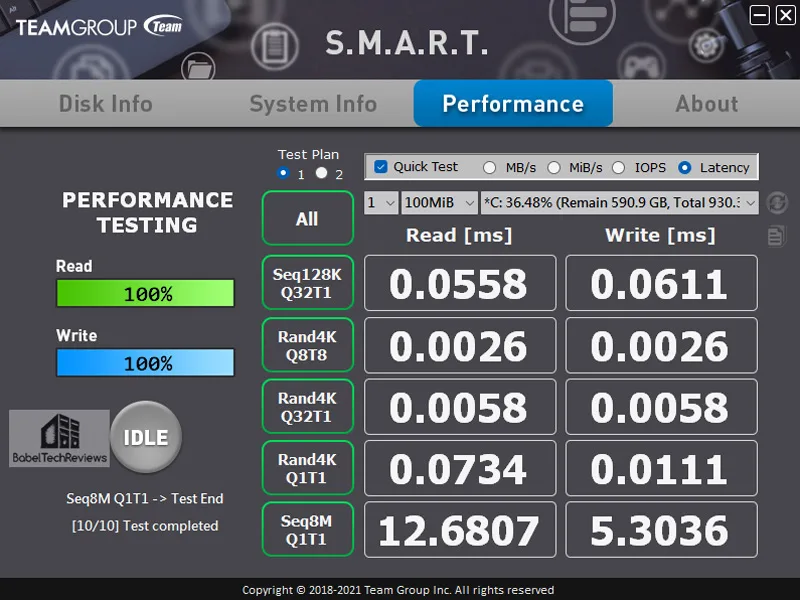 Next, the Delta MAX dual performance tests starting with MB/s.
Next, the Delta MAX dual performance tests starting with MB/s.  Below we look at the performance tests in IOPS for the Delta MAX.
Below we look at the performance tests in IOPS for the Delta MAX. 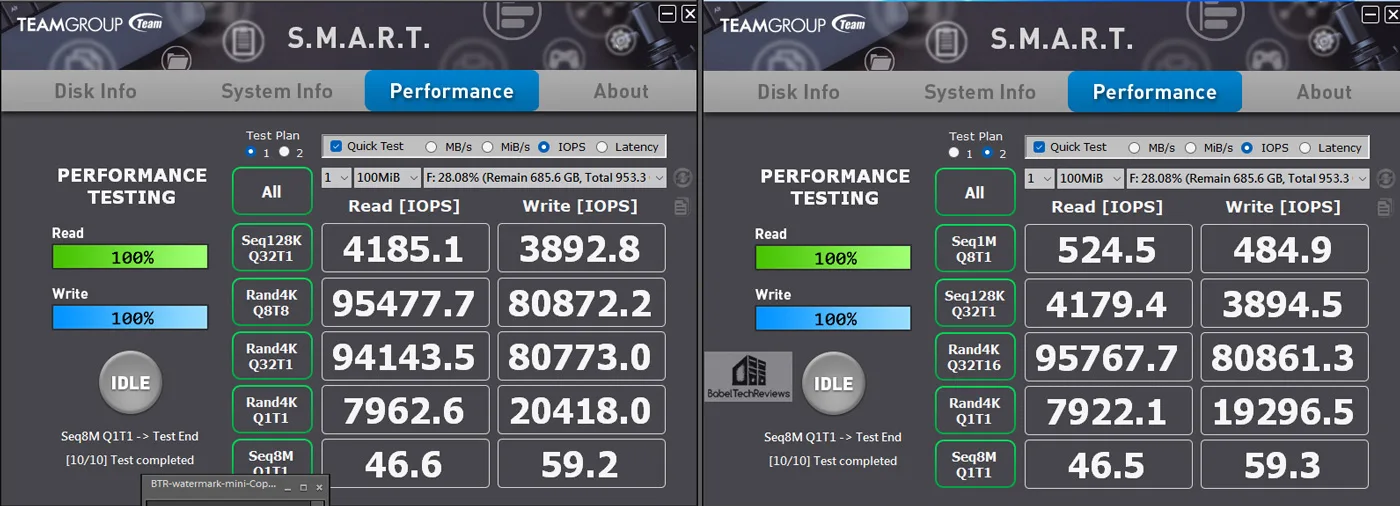 Finally, S.M.A.R.T. measures the Delta MAX SATA III SSD latency.
Finally, S.M.A.R.T. measures the Delta MAX SATA III SSD latency. 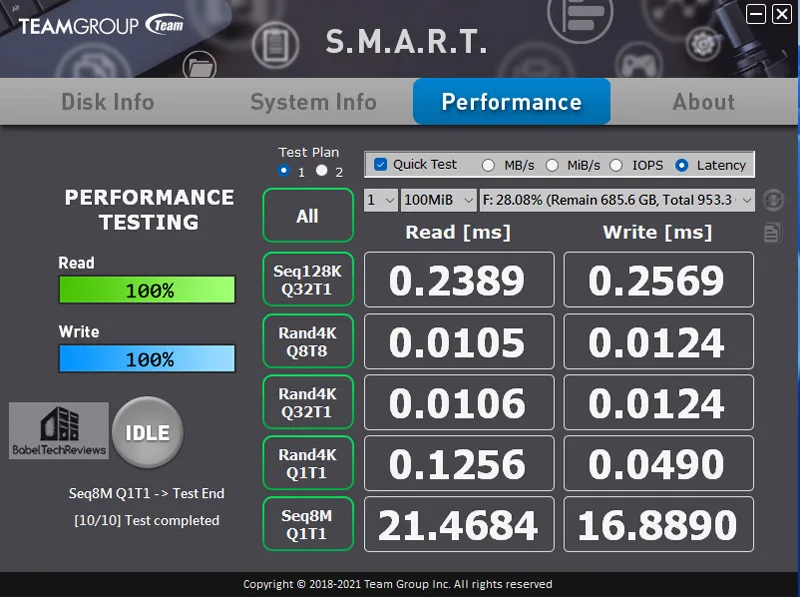 S.M.A.R.T. clearly shows the PCIe NVMe CARDEA A440 is the fastest SSD, followed by the CARDEA Ceramic C440, the CARDEA IOPS, then the TeamGroup MP33 SSD, the T-FORCE M200 Portable SSD, and in last place, the Delta MAX SATA III SSD.
S.M.A.R.T. clearly shows the PCIe NVMe CARDEA A440 is the fastest SSD, followed by the CARDEA Ceramic C440, the CARDEA IOPS, then the TeamGroup MP33 SSD, the T-FORCE M200 Portable SSD, and in last place, the Delta MAX SATA III SSD.
TeamGroup’s S.M.A.R.T. tool is a great place to start, so let’s see what other synthetic and real world tests show. Let’s begin with 3DMark’s storage benchmark.
3DMark Storage Benchmark
3DMark’s Professional version by UL includes a Storage Benchmark (optional in the Advanced version) which also measures the time it takes to load several popular games.
First, the T-TORCE M200 Portable results with 1210.

Now the CARDEA Ceramic A440 results with 3844.  The CARDEA Ceramic C440 scores 3009.
The CARDEA Ceramic C440 scores 3009. 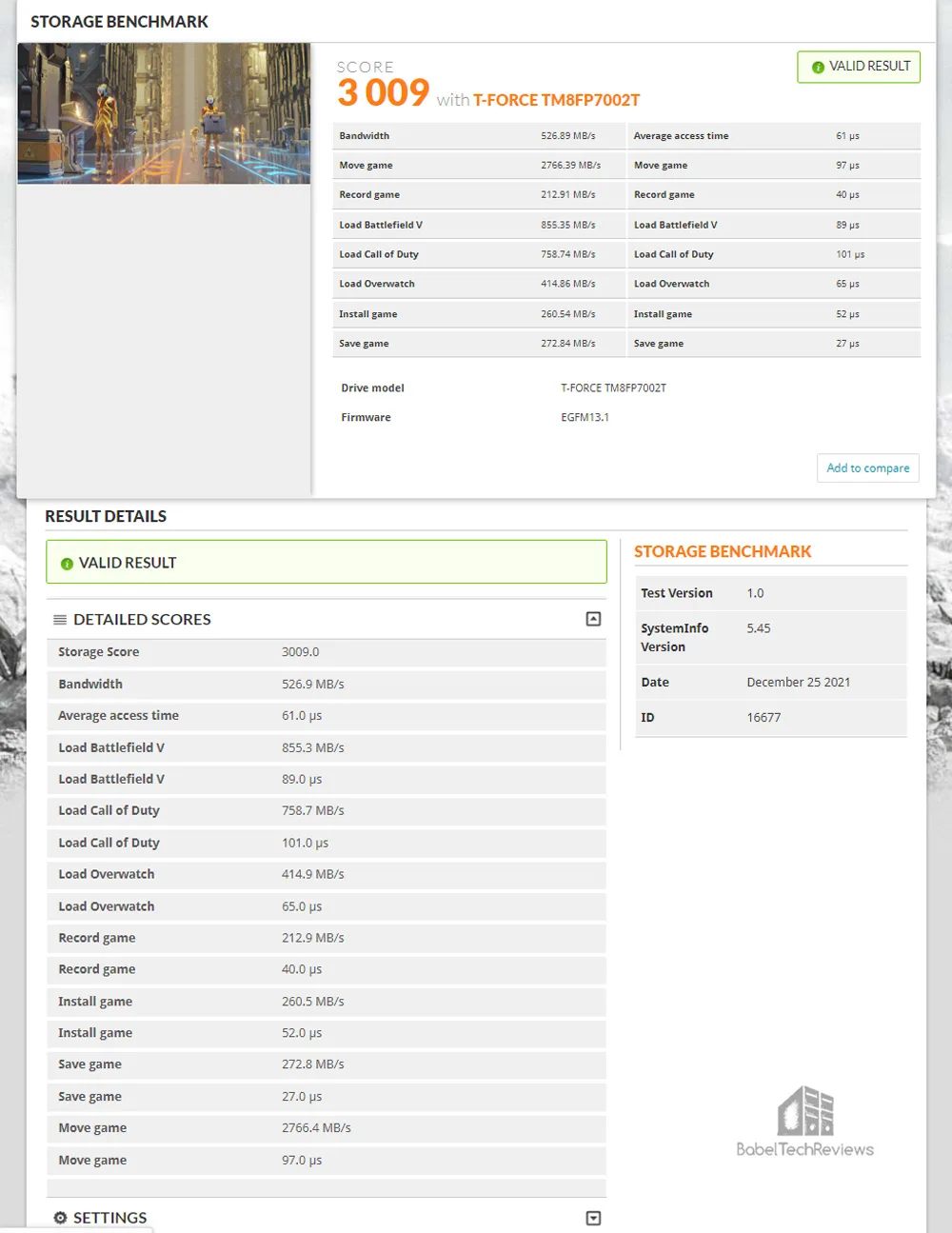 Next up, the CARDEA IOPS manages 2587.
Next up, the CARDEA IOPS manages 2587. 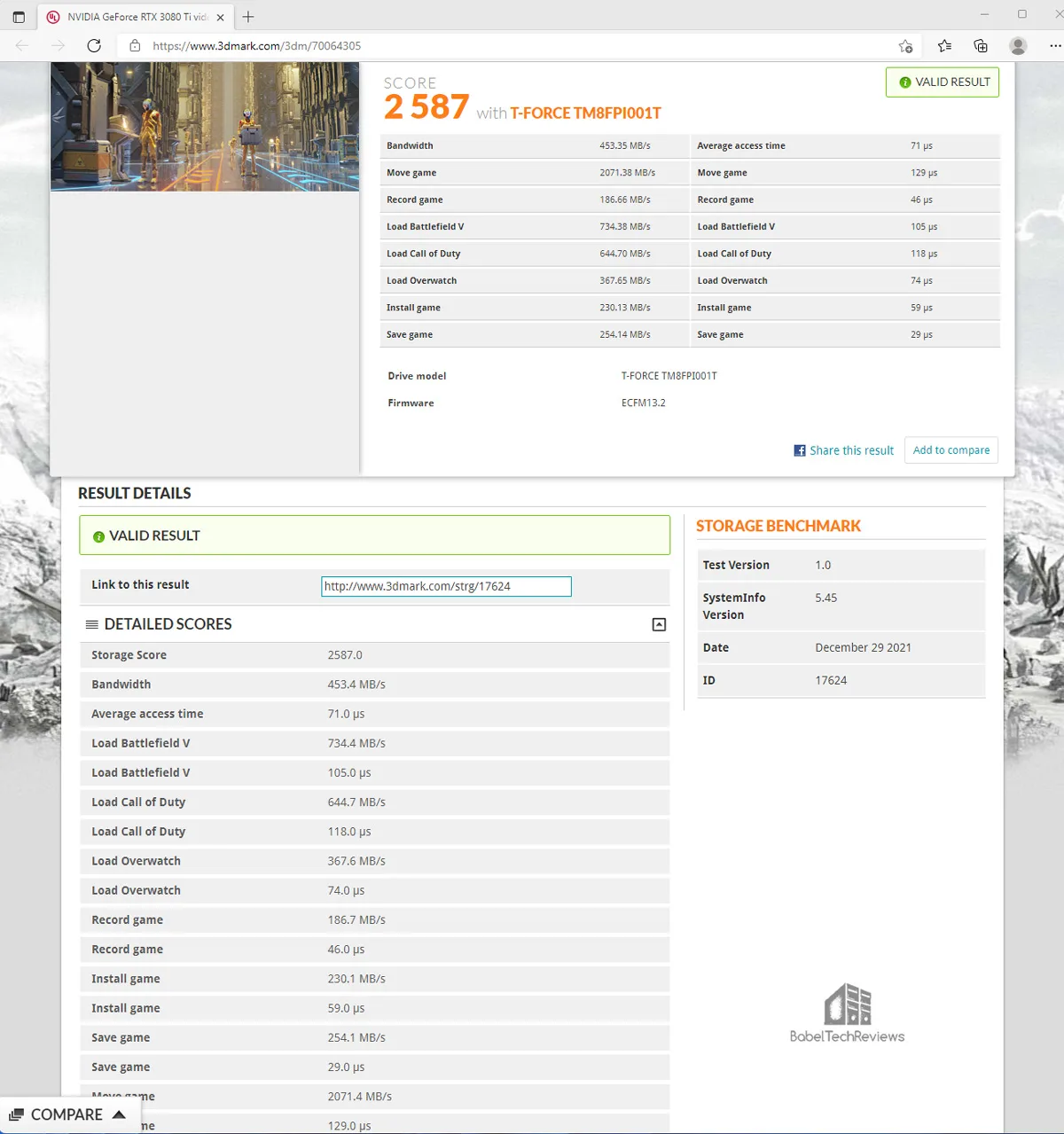 The TeamGroup MP33 SSD gets 1538.
The TeamGroup MP33 SSD gets 1538. 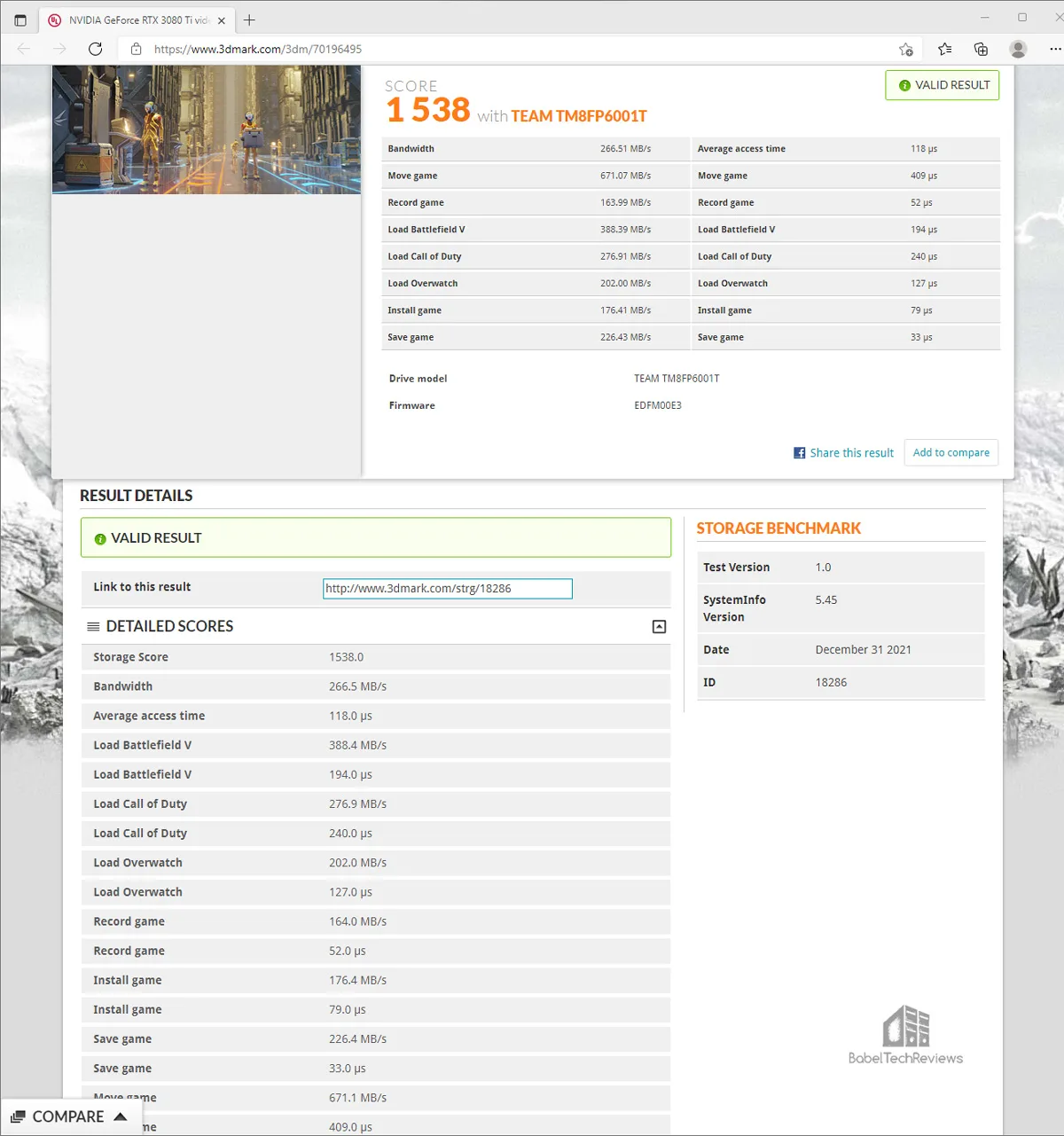 And in last place, the Delta MAX SATA III SSD gets 1005.
And in last place, the Delta MAX SATA III SSD gets 1005. 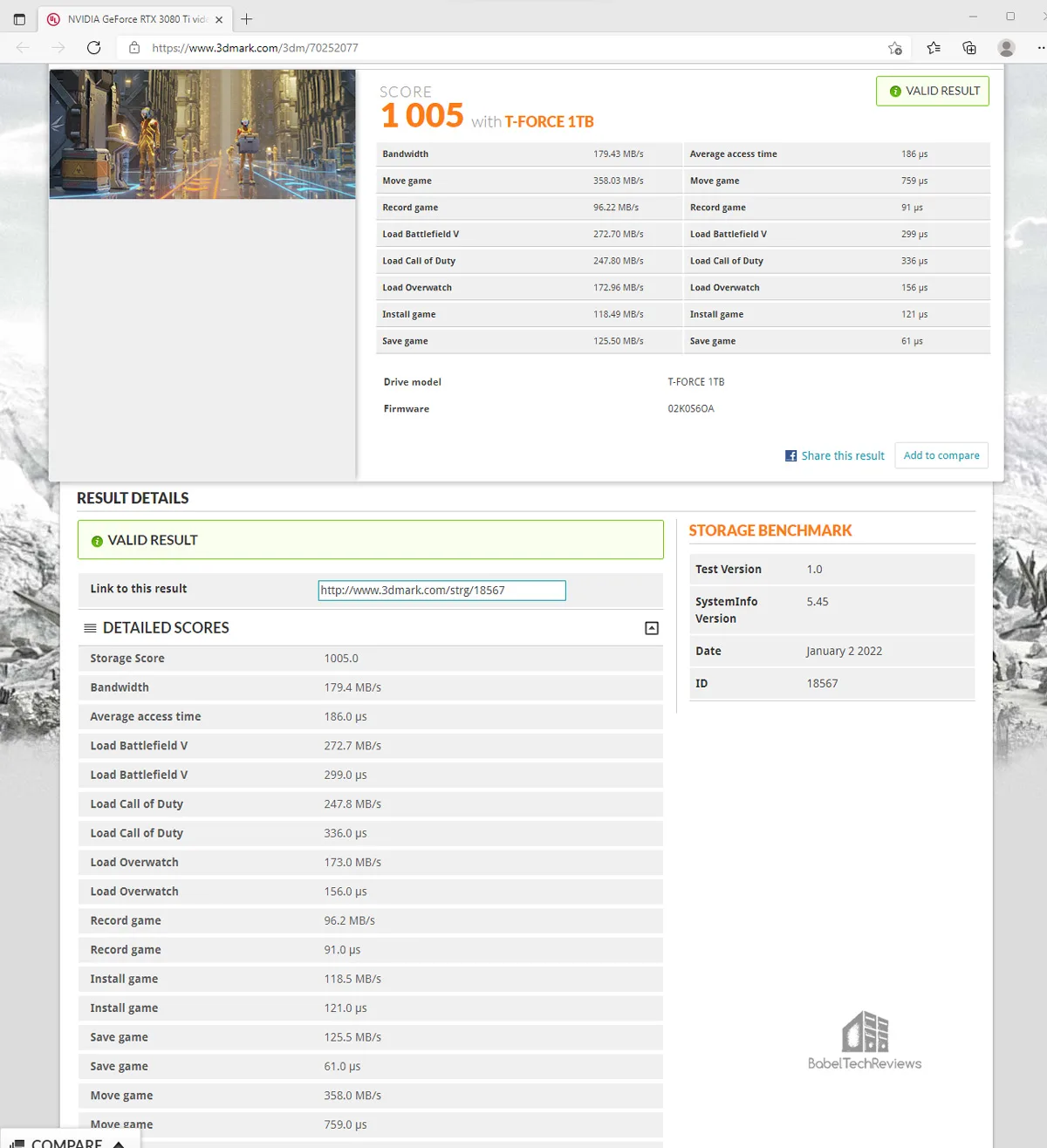 Here’s the summary chart.
Here’s the summary chart.

It’s clear that the CARDEA A440 is the fastest SSD followed by the C440, the IOPS, the MP33, the M200 Portable, and the DELTA MAX. The M200 delivers impressive performance considering that it is an external drive transferring data over USB.
Next up, another important UL benchmark suite, PCMark 10 including the full benching suites – Express, Extended, and the Full System Drive Benchmark.
PCMark 10 Professional
UL (formerly Futuremark) has been a developer and publisher of PC benchmark applications for nearly two decades. Although PCMark benches are synthetic suites, they provide a good measure of system performance. PCMark 10 was primarily developed for Windows 10 and it builds upon the PCMark 8 suite for a package of vendor-neutral home and office benchmarks.
The regular version of PCMark 10 misses several key elements such as detailed storage testing, but the Professional version, which we use courtesy of UL, includes a storage benchmark and a full system drive benchmark. In addition, We use both PCMark 10’s Express and Extended suite also.
First up is the PCMark 10’s Full System Drive Benchmark.
Full System Drive Benchmark
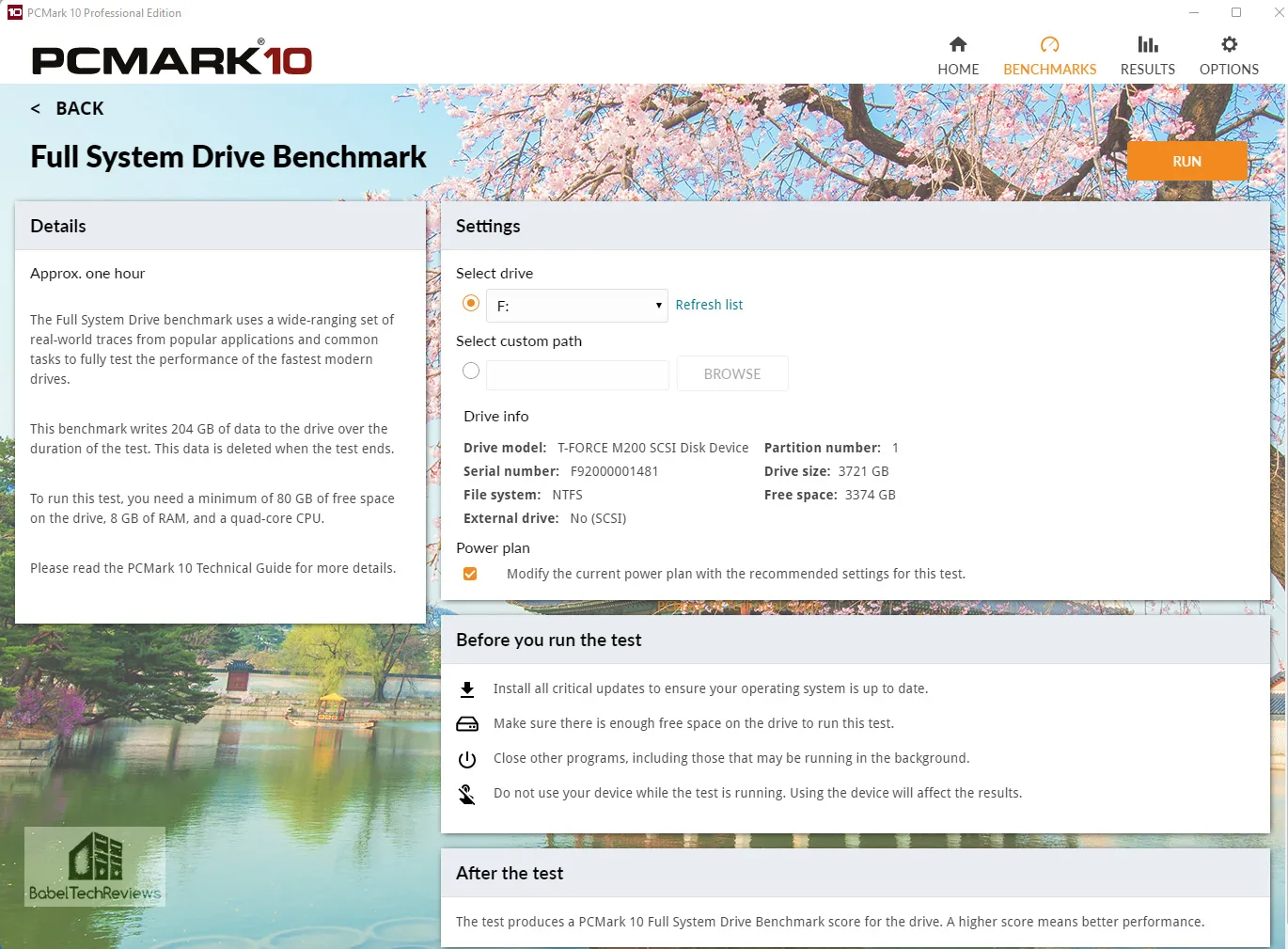
First we test the M200 Portable which scores 955.
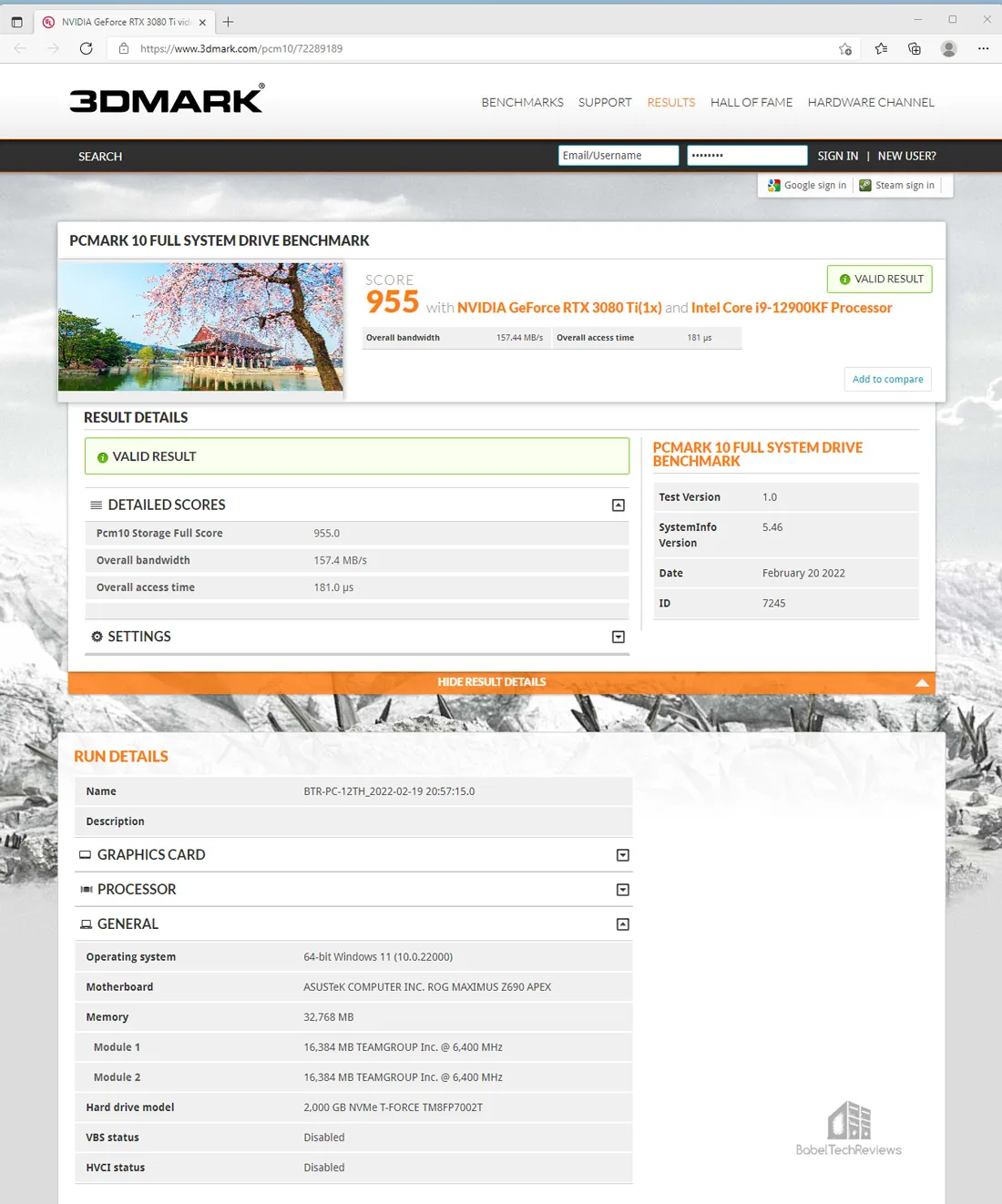
Next, we test the CARDEA A440 which scores 3474. 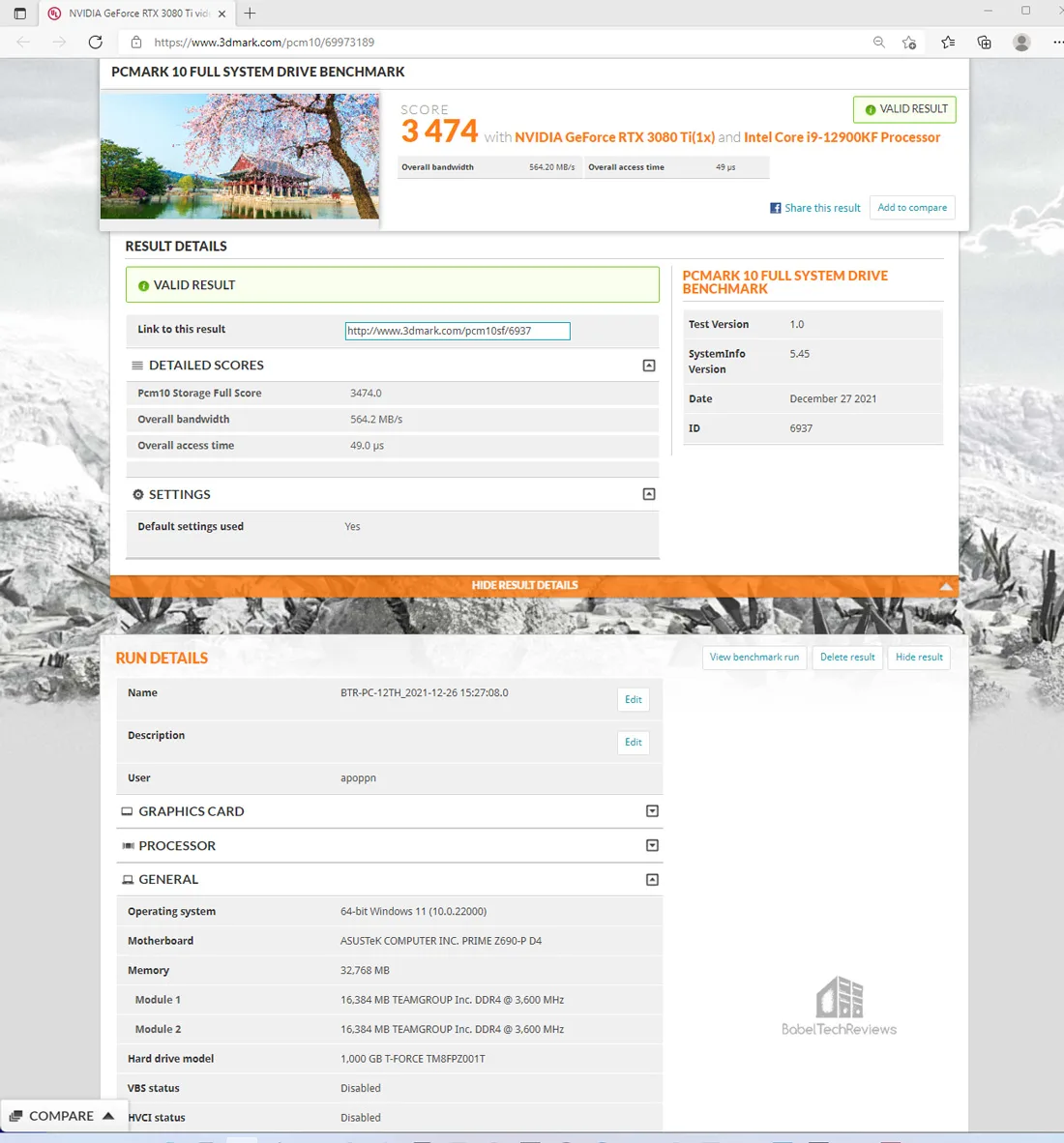 Next the CARDEA Ceramic results give 2223.
Next the CARDEA Ceramic results give 2223. 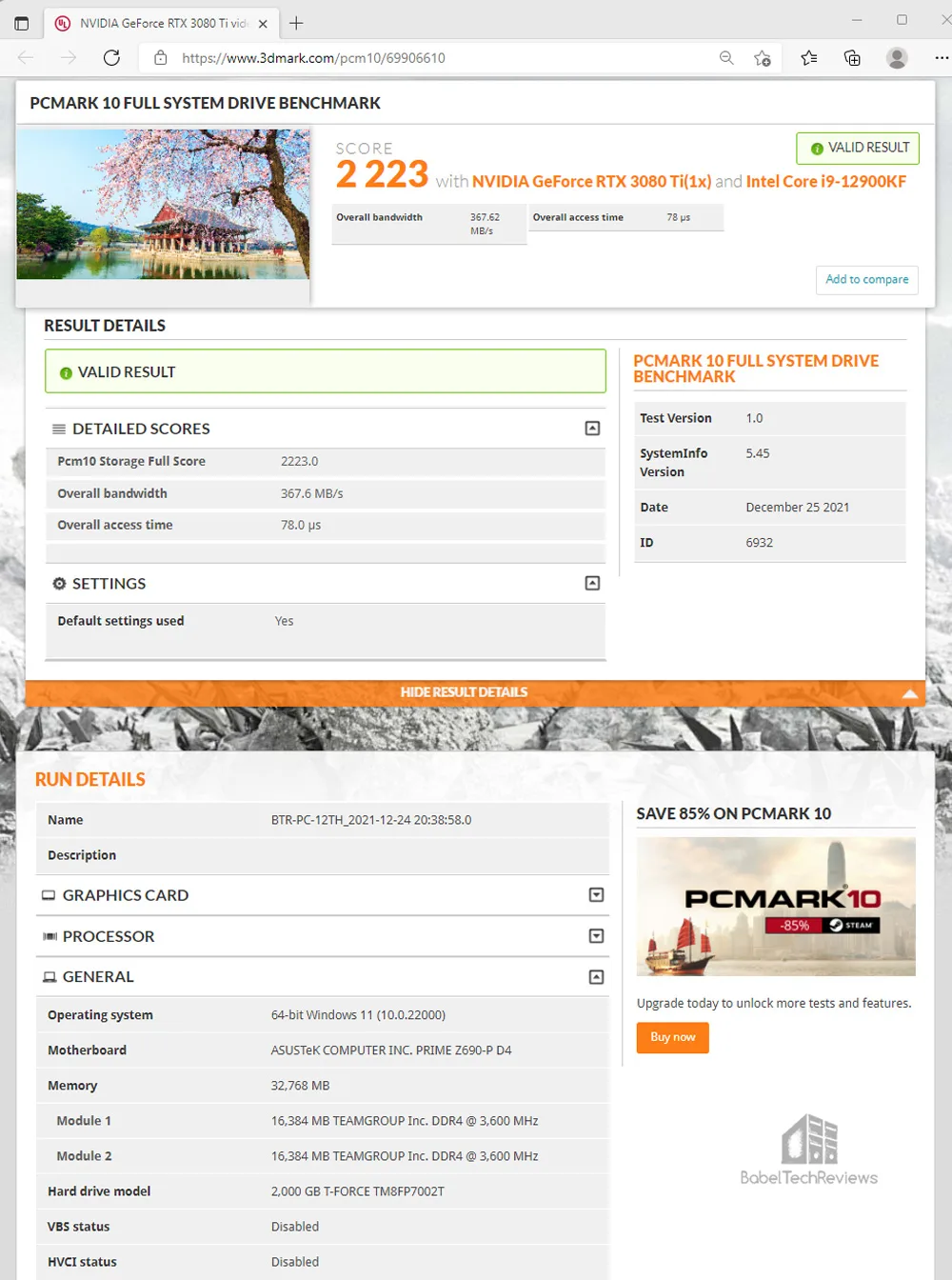 The CARDEA IOPS SSD scores 2027.
The CARDEA IOPS SSD scores 2027. 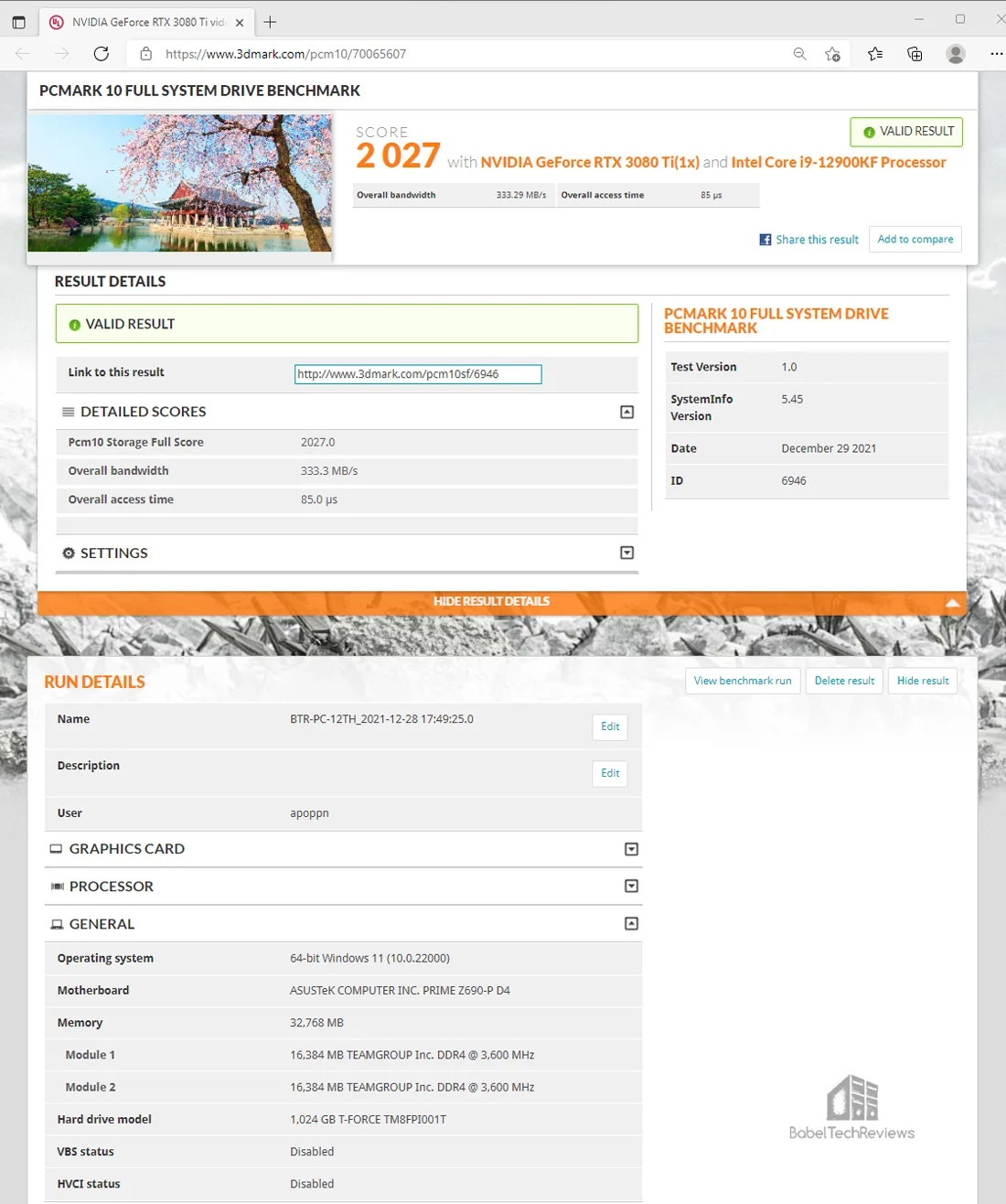 The MP33 SSD manages 1187.
The MP33 SSD manages 1187. 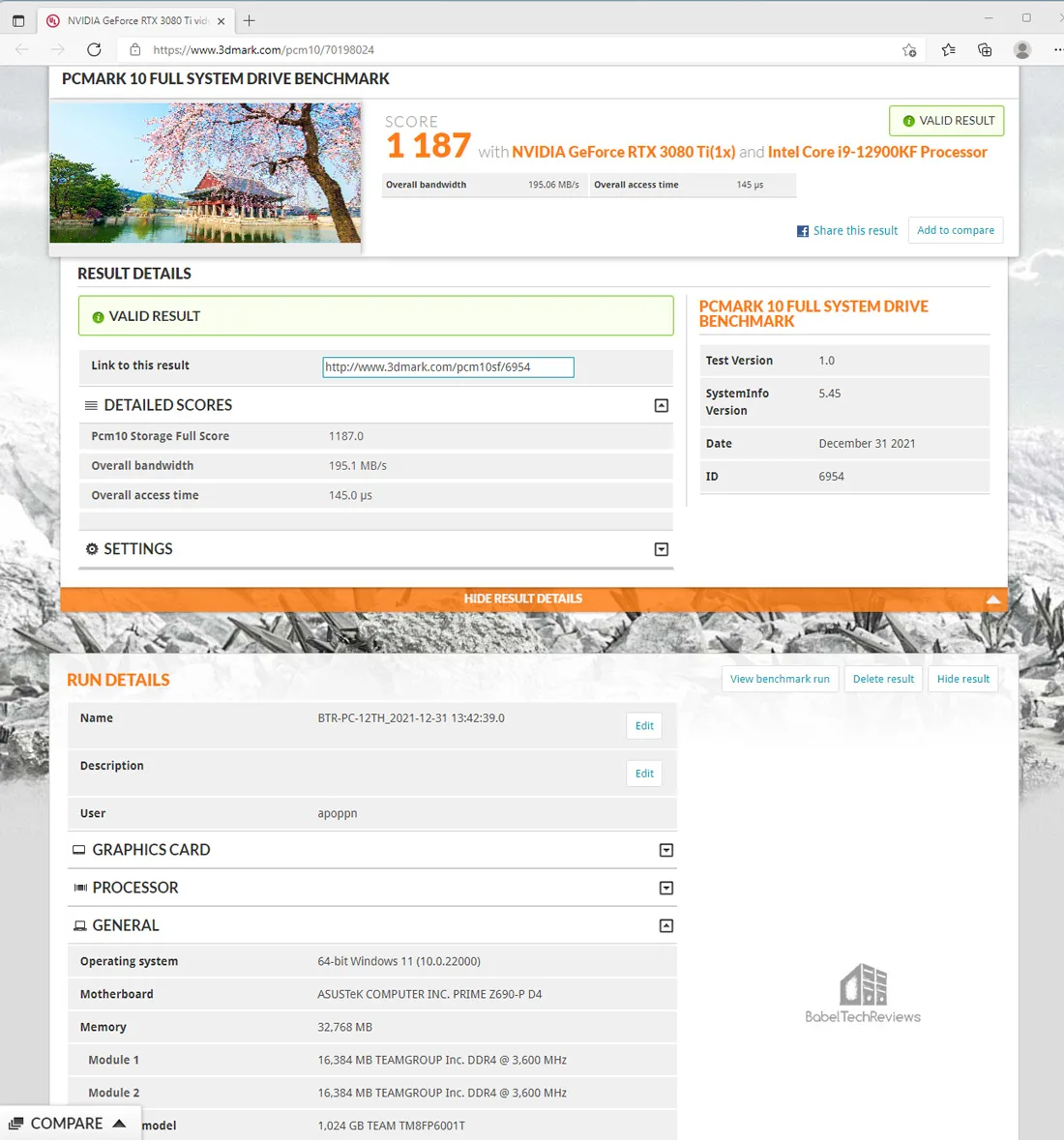 The Delta MAX SSD was tested last and it scores lowest with 816.
The Delta MAX SSD was tested last and it scores lowest with 816.

Here’s the summary chart.

The SSDs line up in their expected order with the M200 Portable drive beating the SATA III drive.
The PCMark 10 Express benchmark suite is best suited for office tasks while the Extended benchmarks are for power users. To properly compare the PCMark 10 scores, look at the detailed results. All of the SSD results are presented as screenshots. Open the images in separate tabs for easy individual test result comparisons. These will be summarized after all of the screenshots are presented.
PCMark 10 Express
First up, the M200 Portable Express score with 6515.
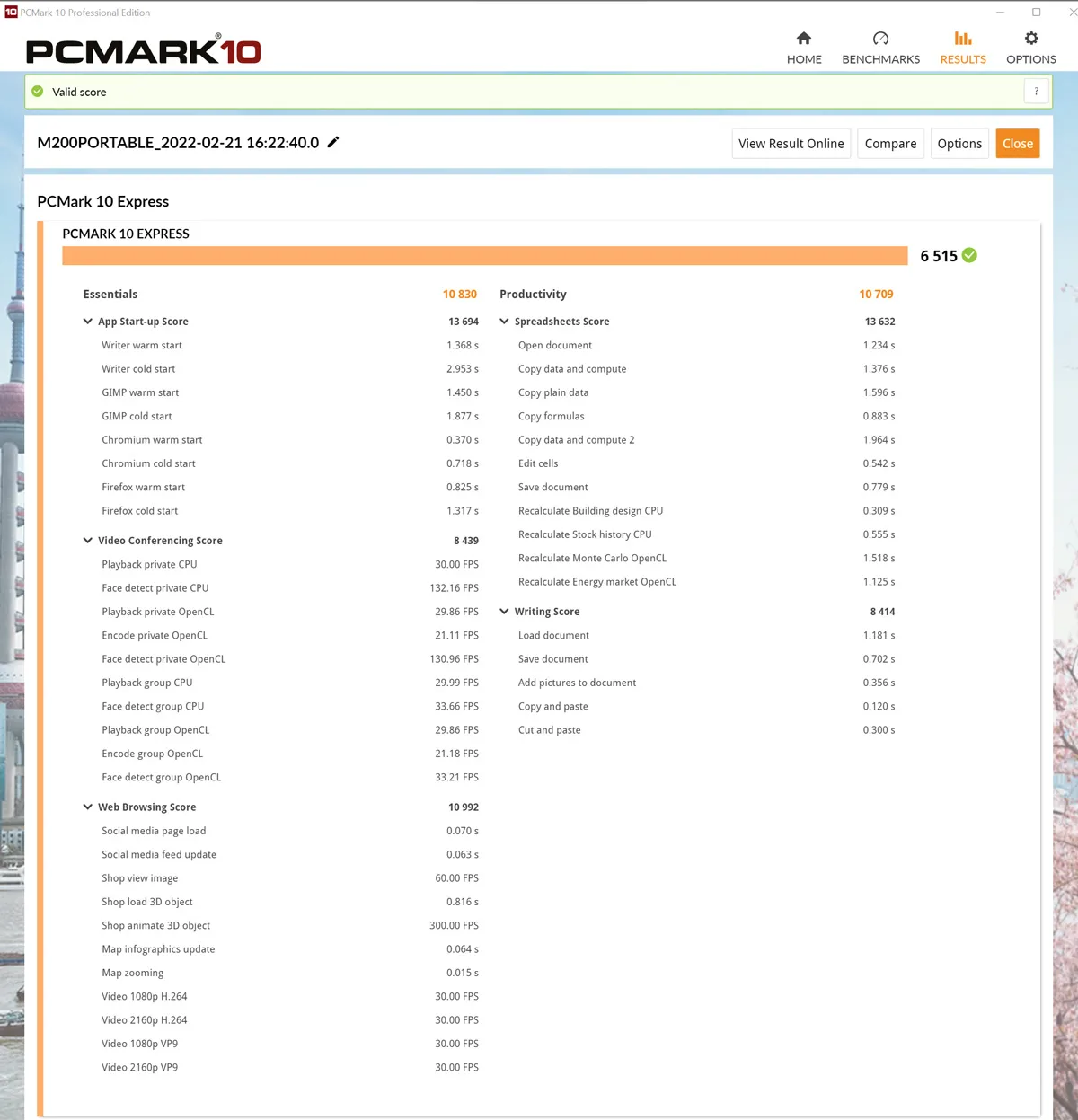
Now the online validated score which gives more detailed results.

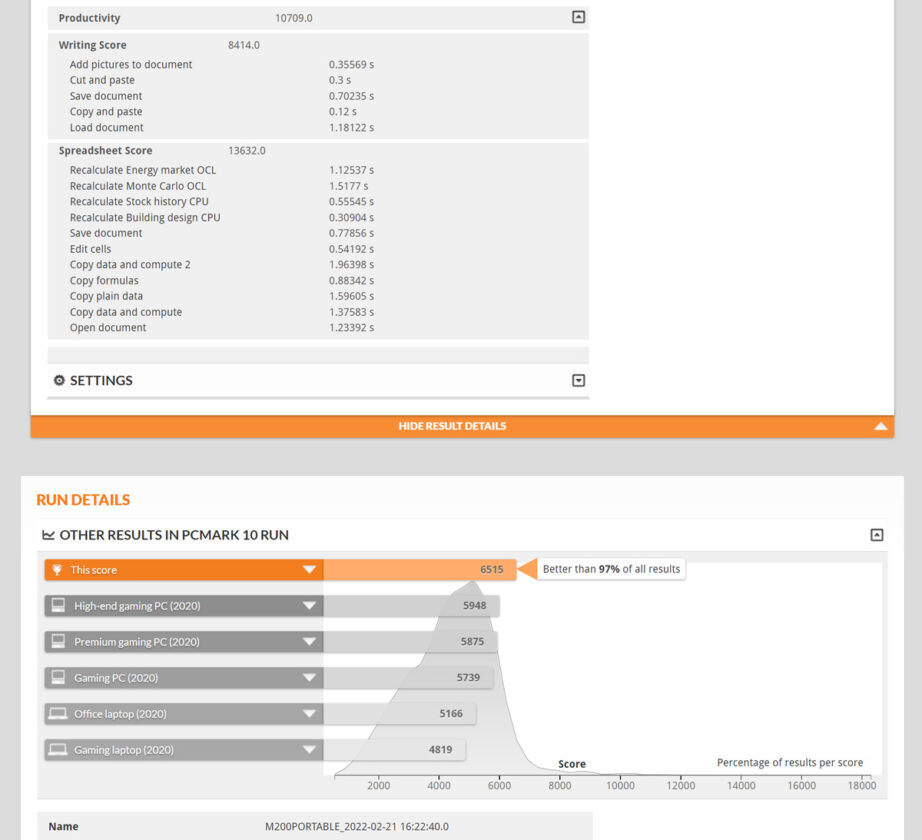
Next up, the CARDEA A440 Express score with 7480.
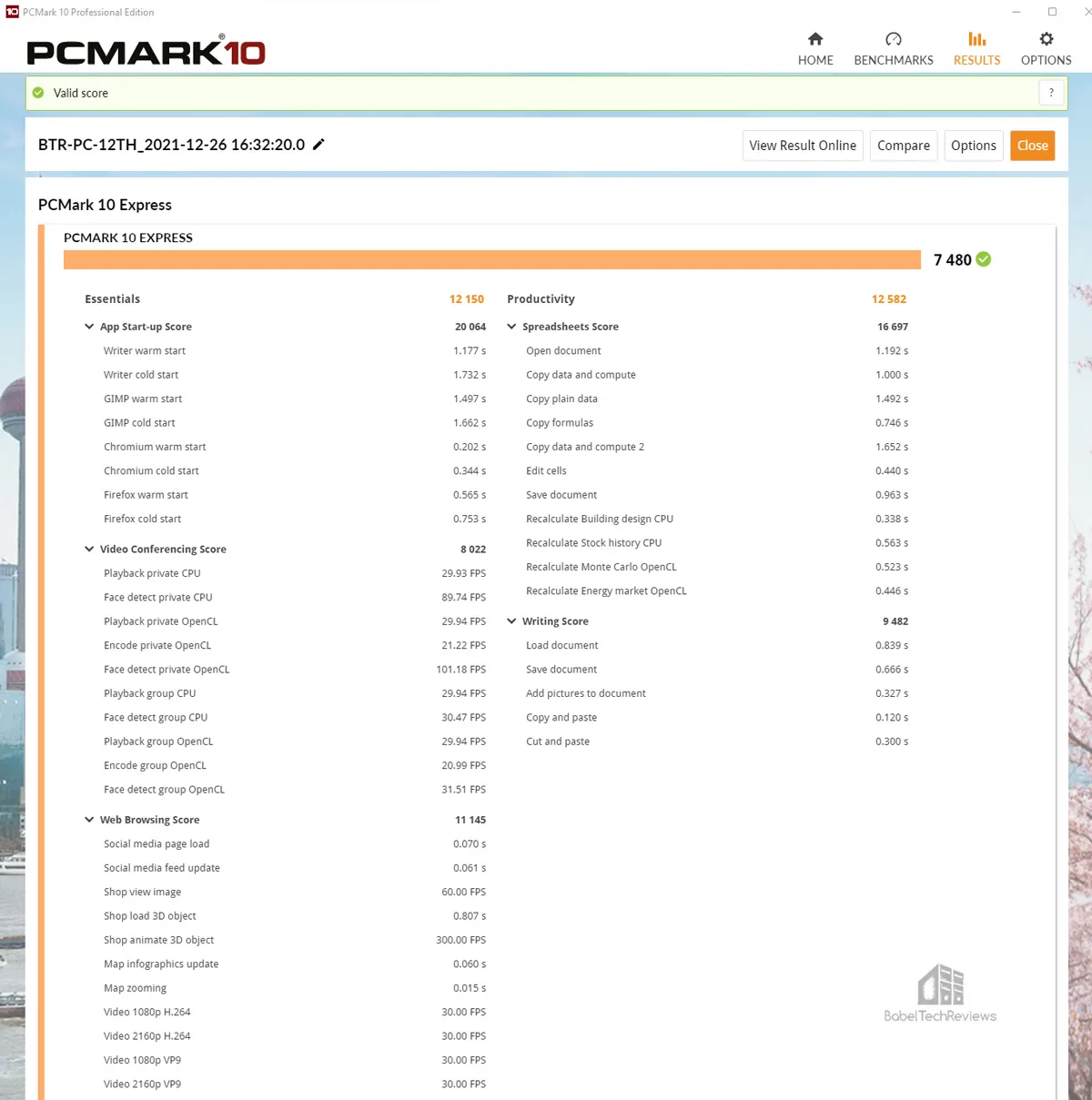 Now the online validated score which gives more detailed results.
Now the online validated score which gives more detailed results. 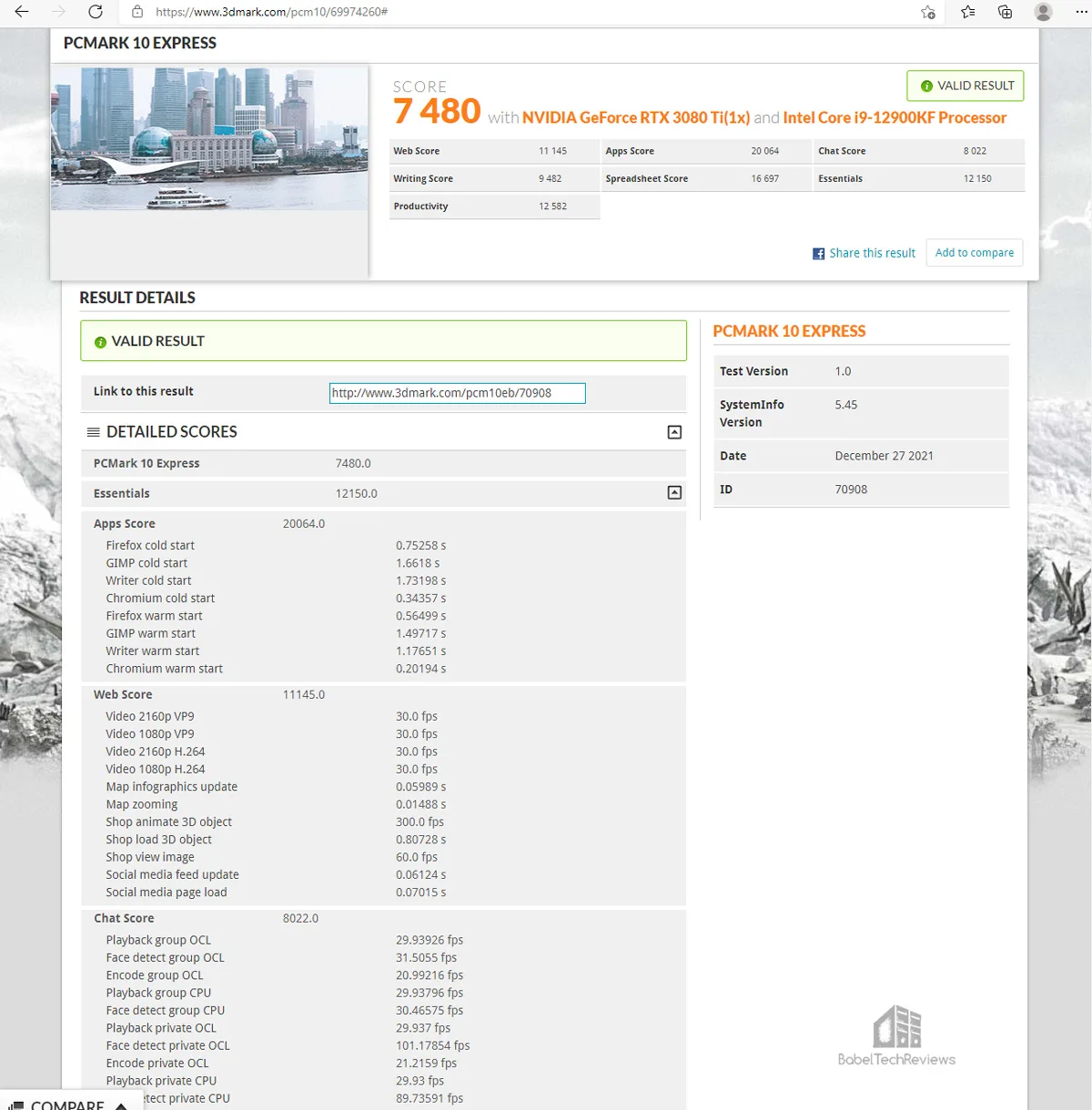
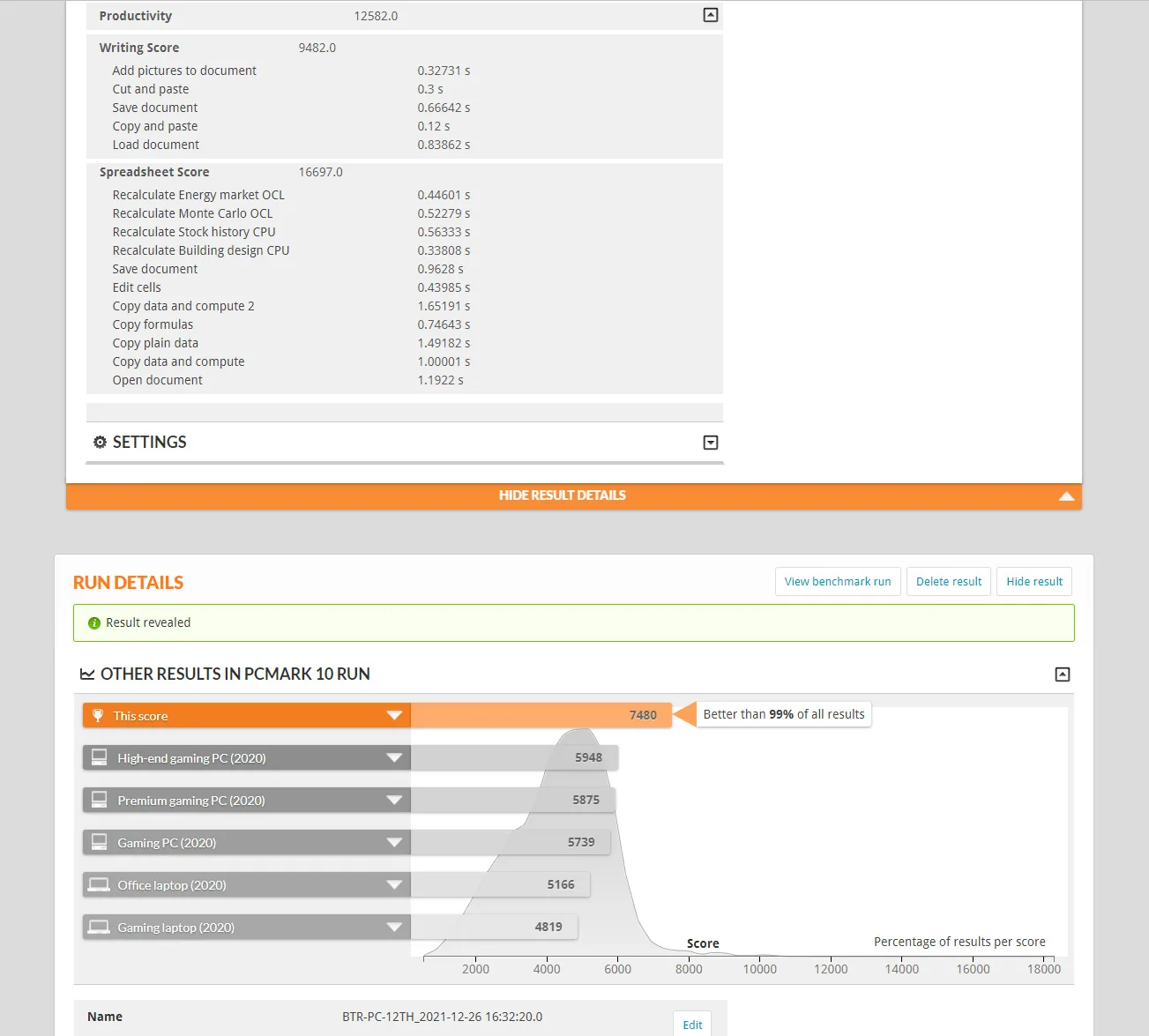 Next, the CARDEA Ceramic C440 Express score is 7188
Next, the CARDEA Ceramic C440 Express score is 7188  Now online results.
Now online results. 
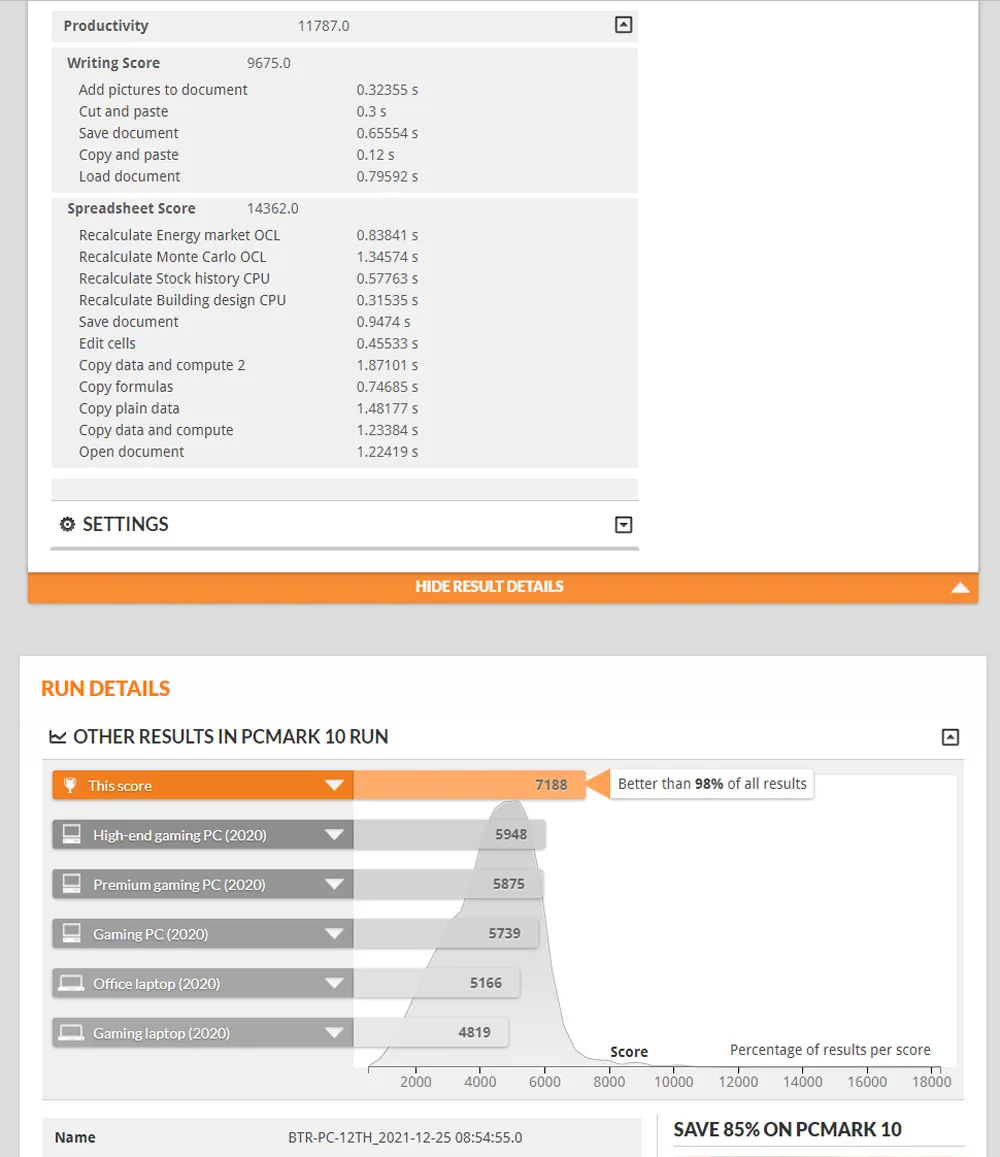 Next up is the CARDEA IOPS Express score with 7484.
Next up is the CARDEA IOPS Express score with 7484.  Online details are next.
Online details are next. 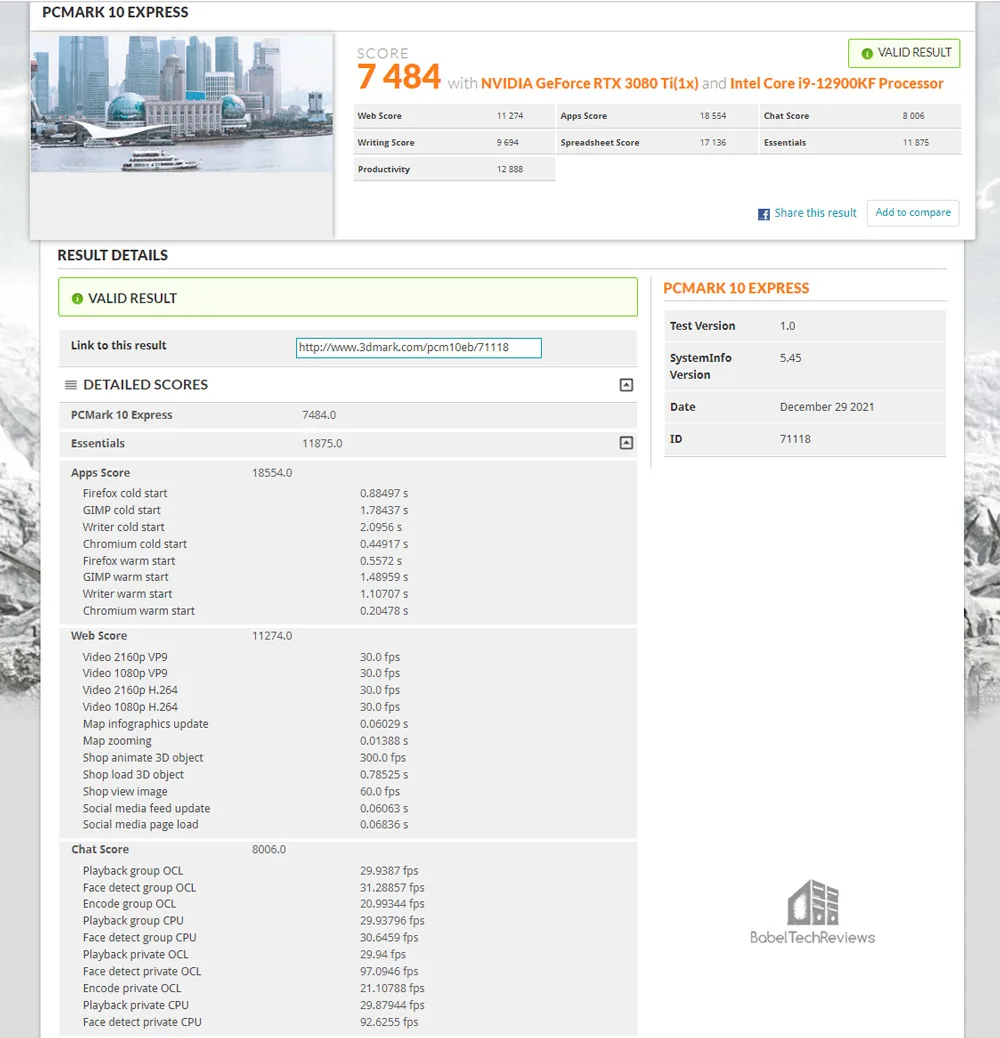
 The Team Group MP33 Express score is given below with 7348
The Team Group MP33 Express score is given below with 7348 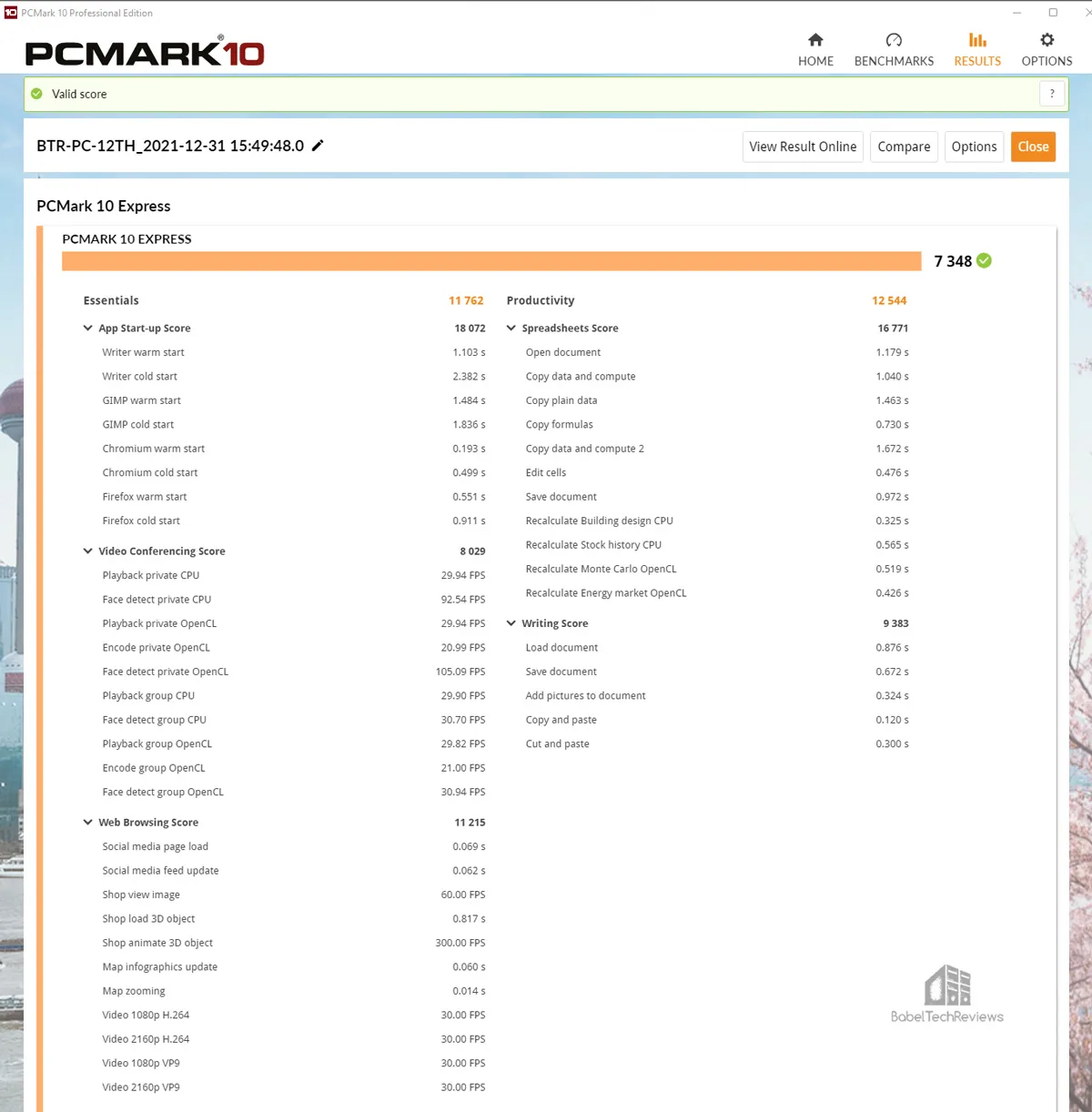 The online details follow.
The online details follow. 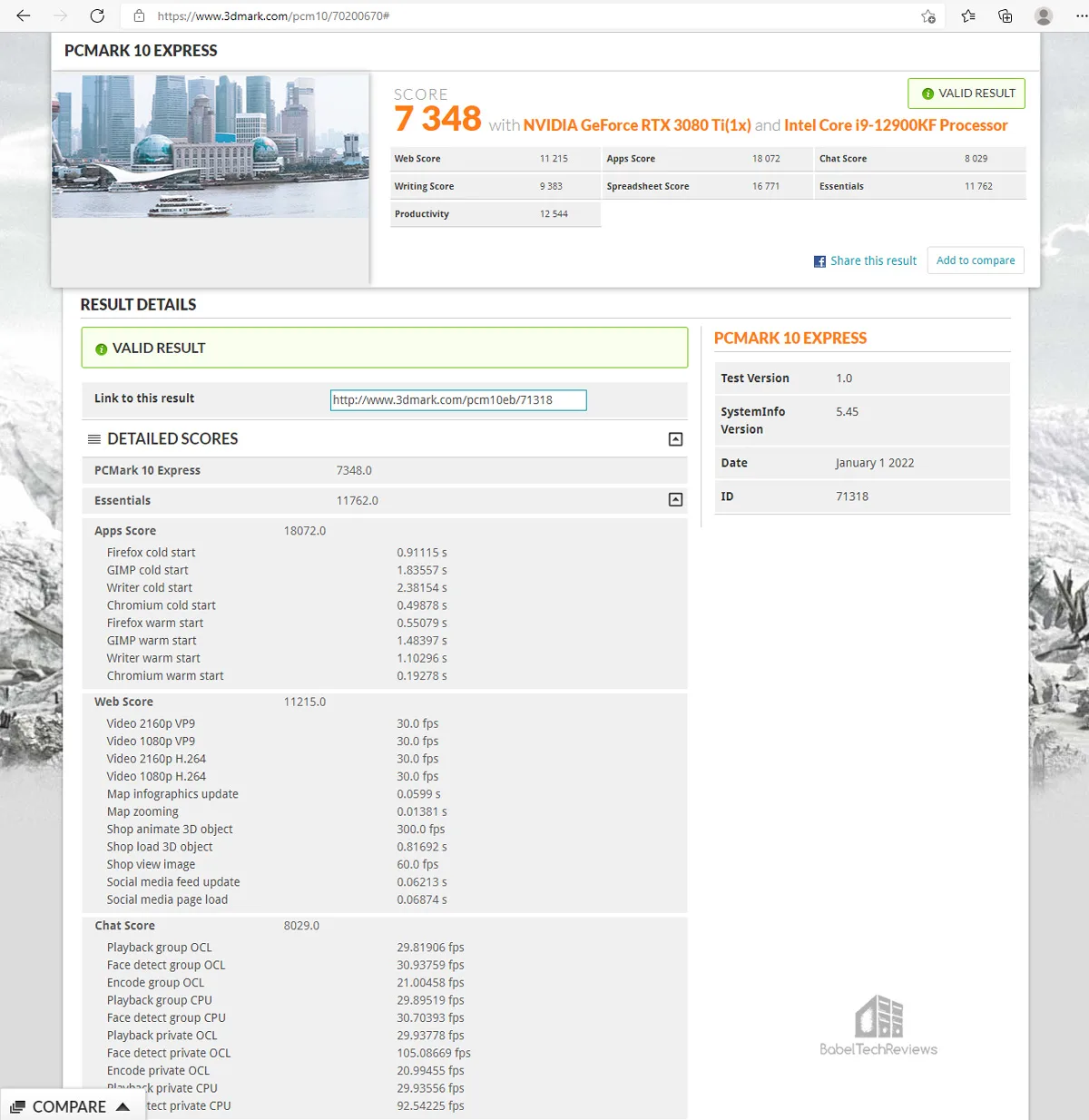
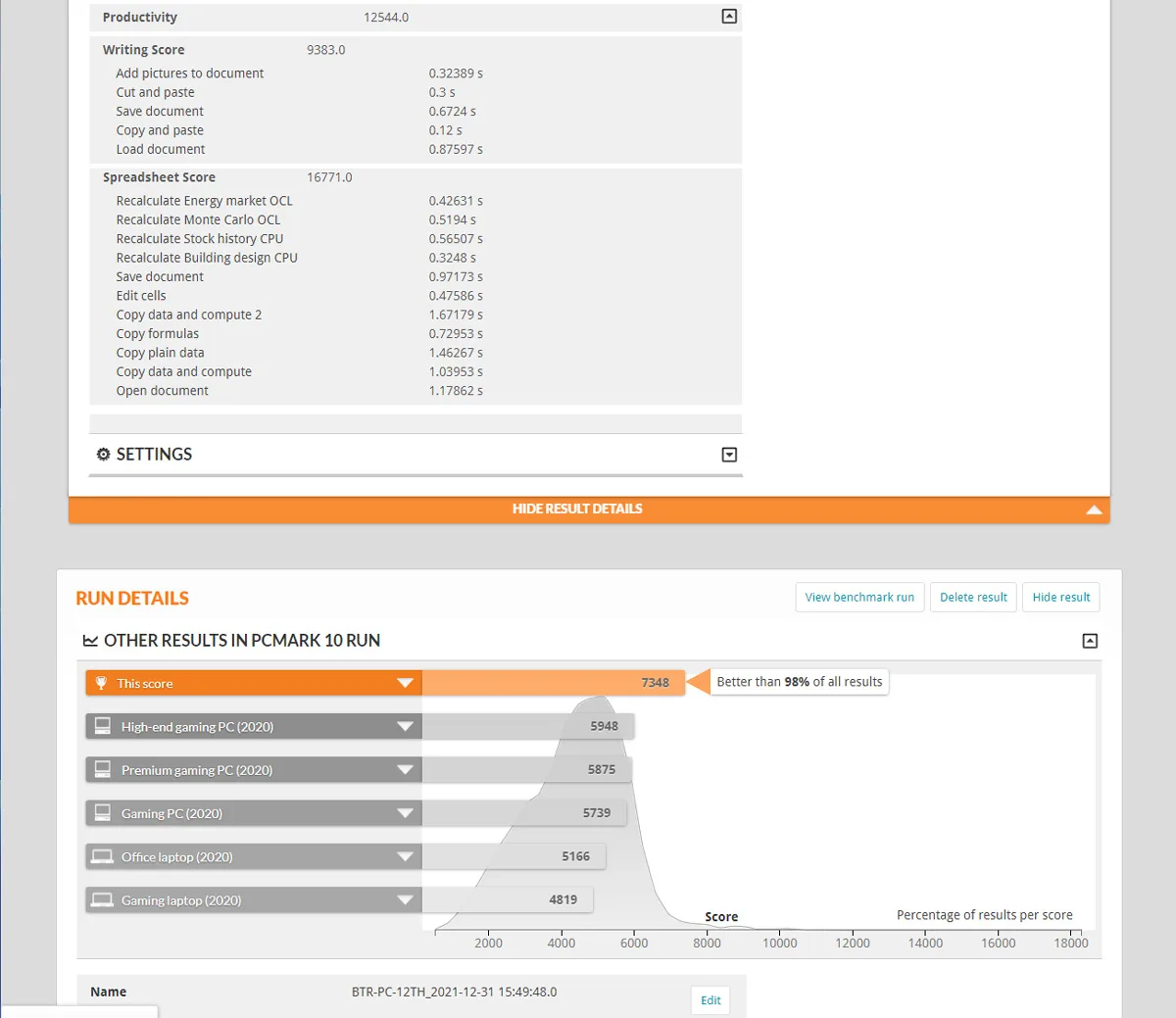 Delta Max could not be tested since windows is not set up on it. The Express summary chart is presented after the Extended scores.
Delta Max could not be tested since windows is not set up on it. The Express summary chart is presented after the Extended scores.
PCMark 10 Extended
First up, the T-FORCE MP200 Portable SSD Extended score is 12483.

Here are the online details.
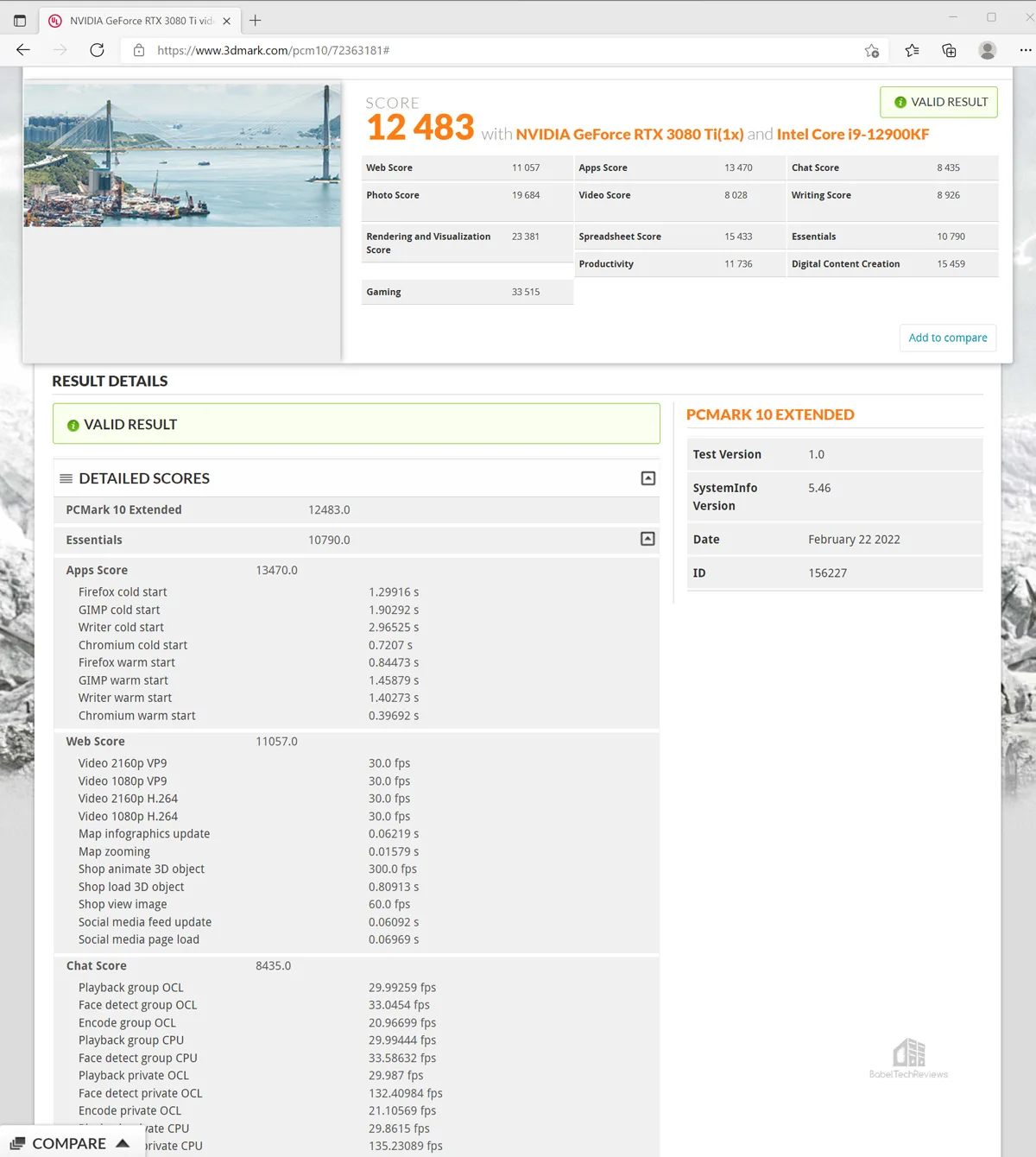
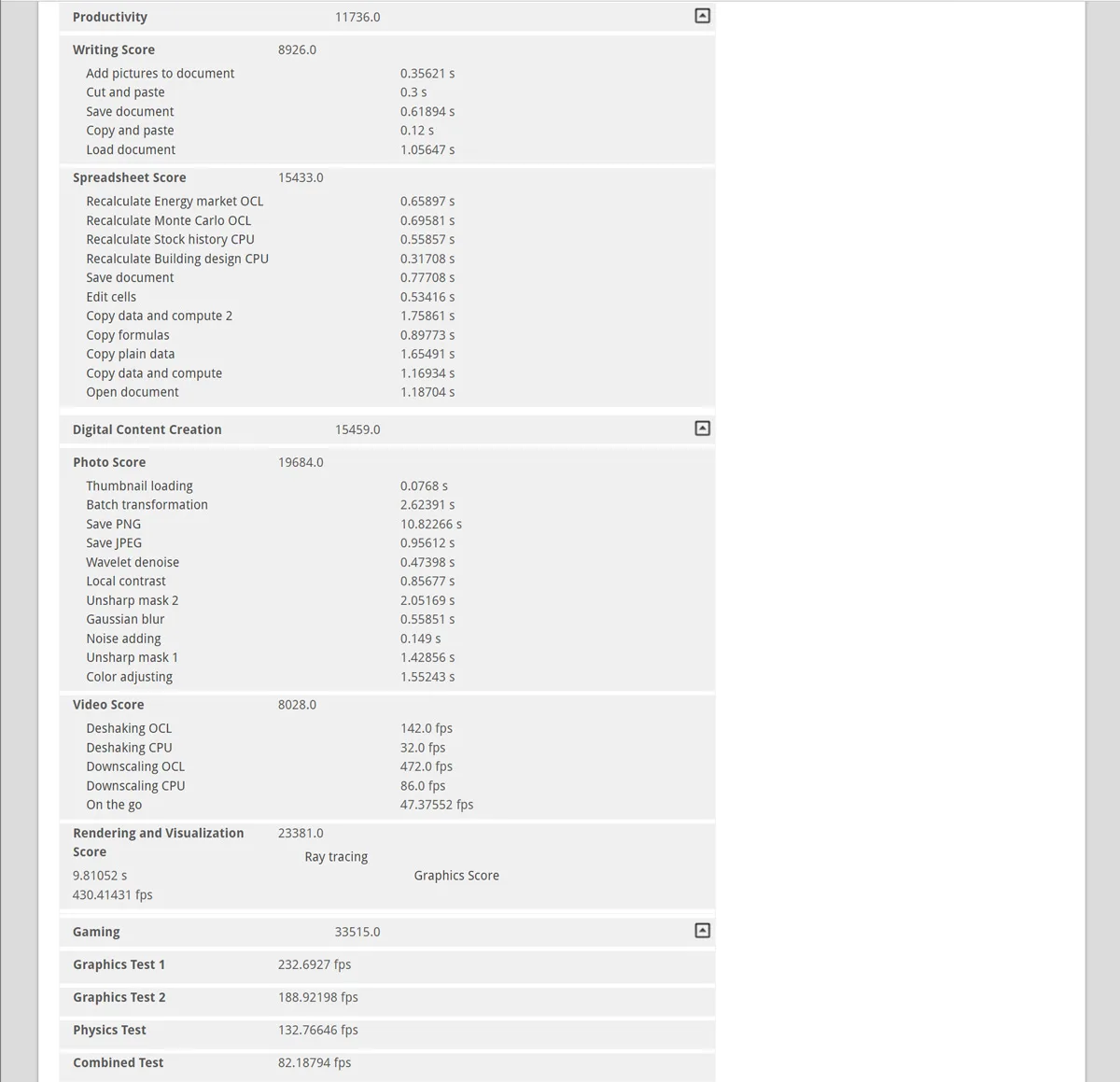
First up, the CARDEA A440 Extended score is 13452.
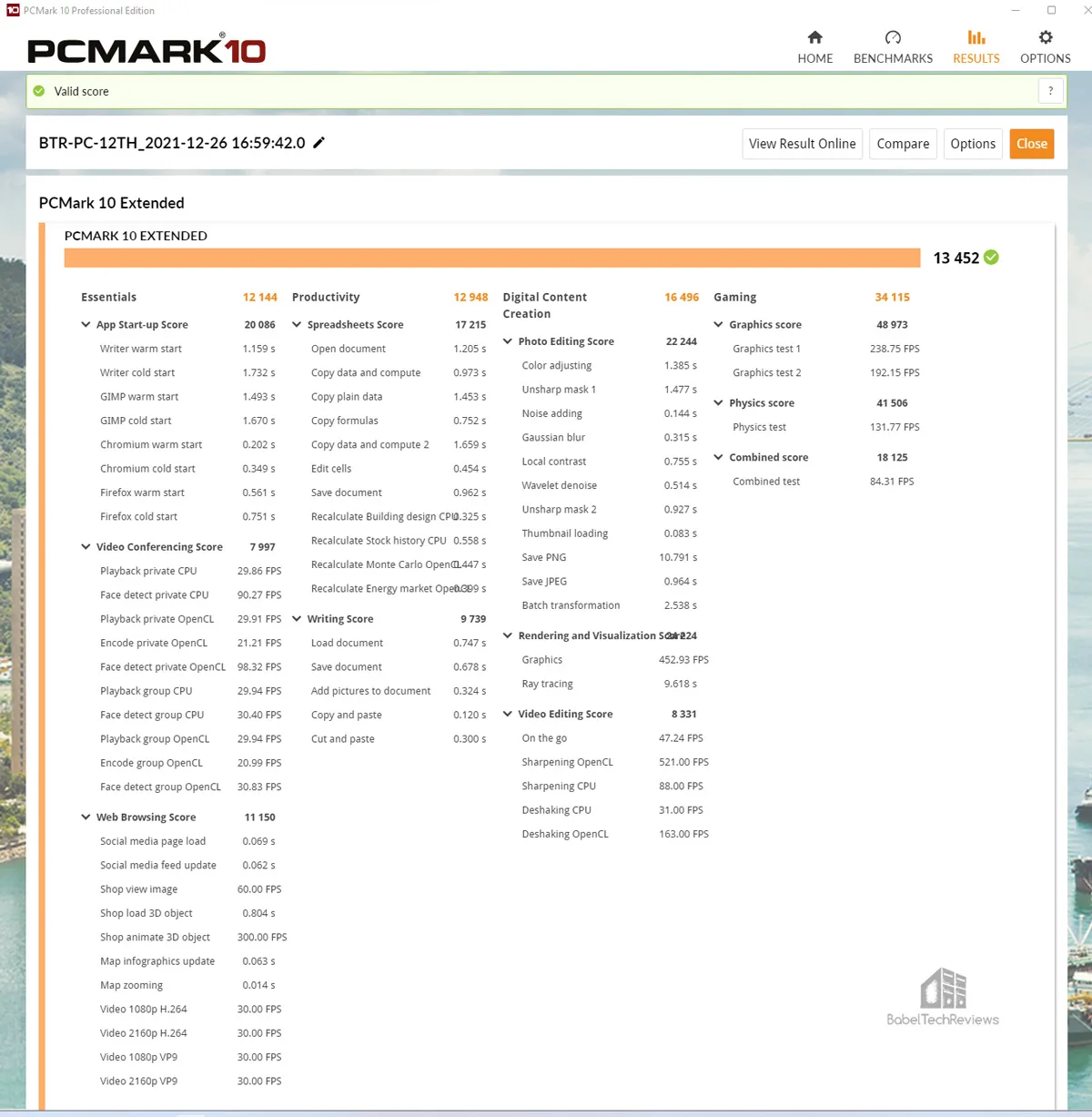 Here are the online details.
Here are the online details. 
 The CARDEA Ceramic C440 Extended score is 13384.
The CARDEA Ceramic C440 Extended score is 13384. 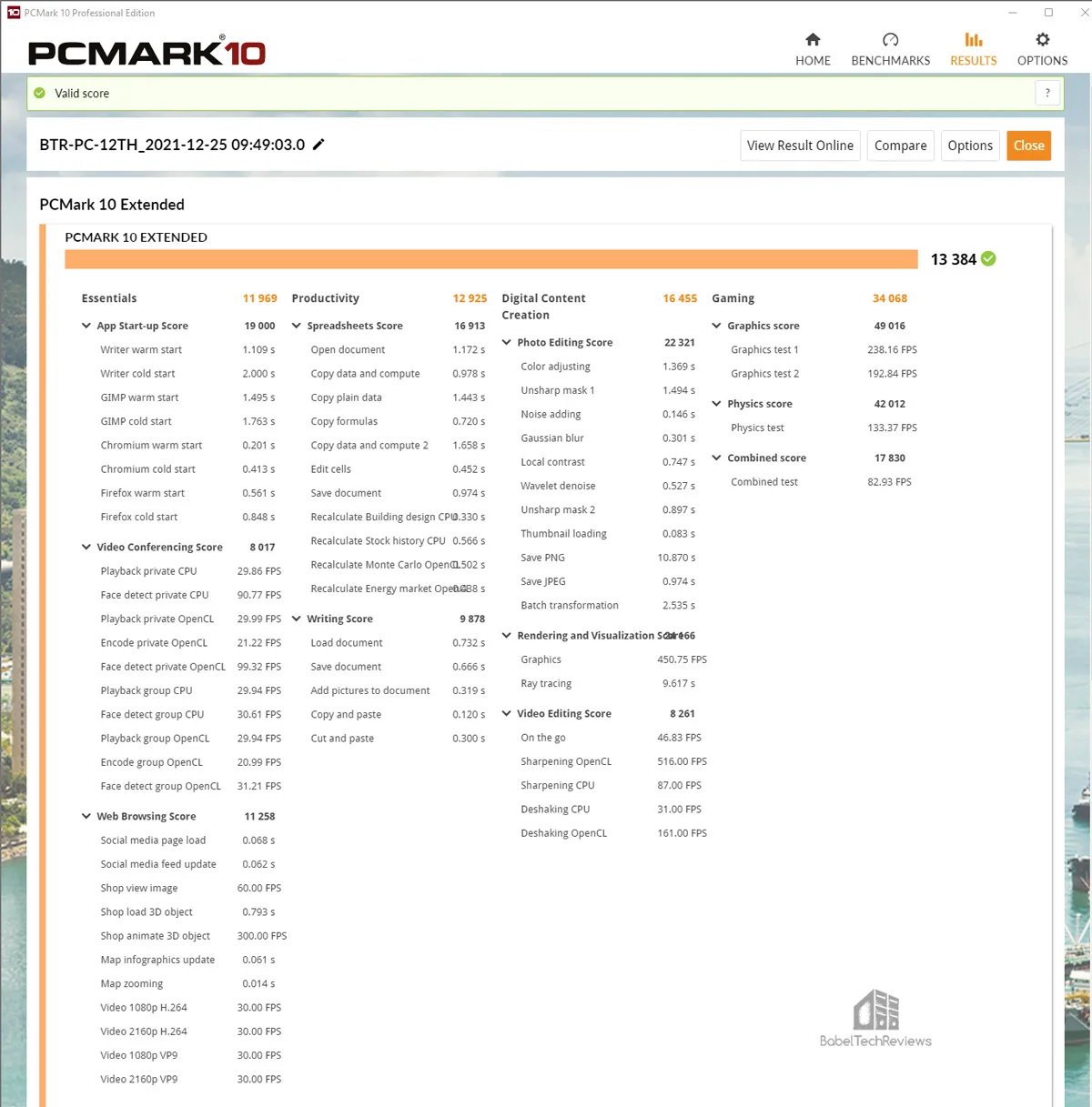 The online details are below.
The online details are below. 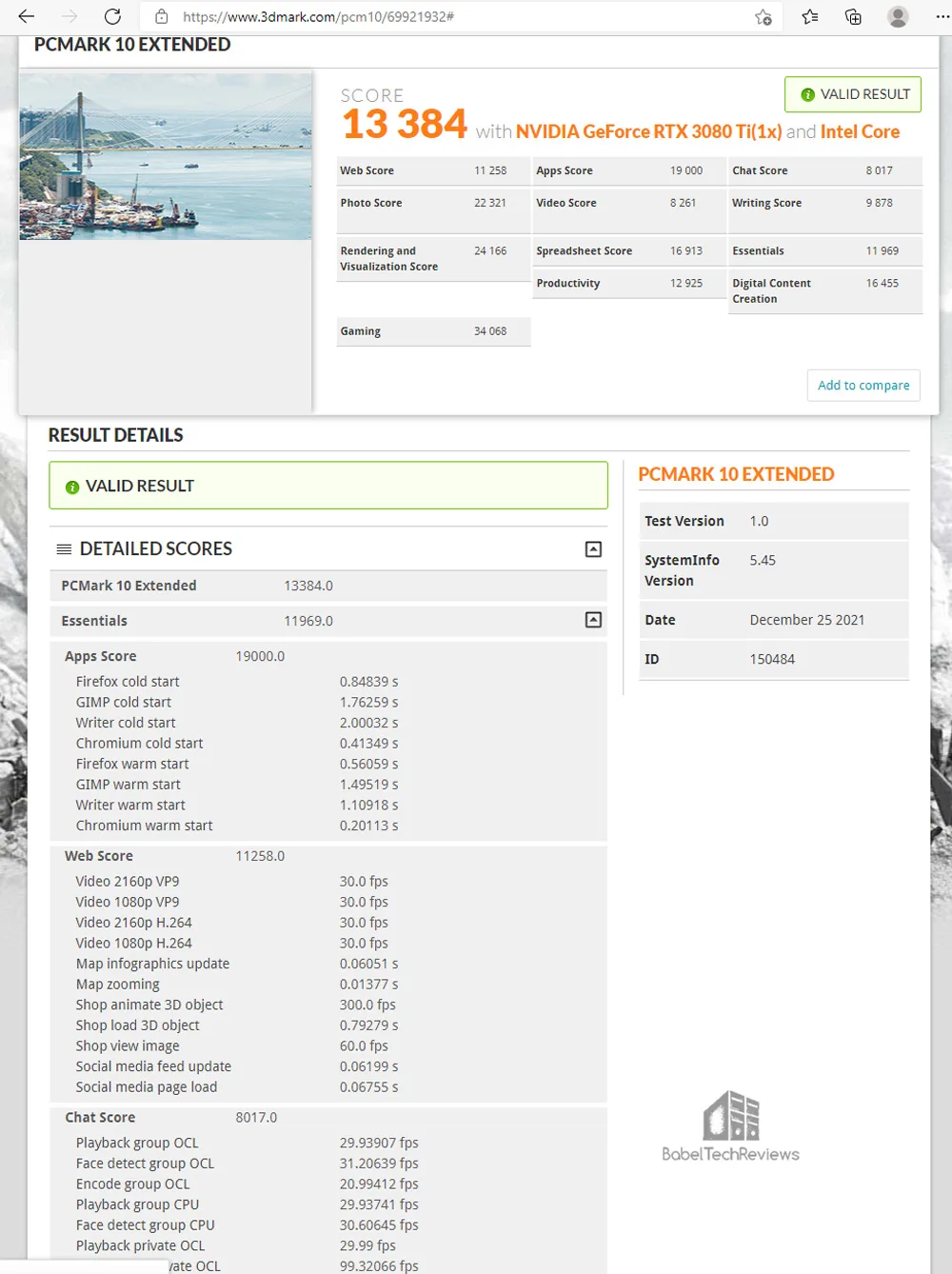
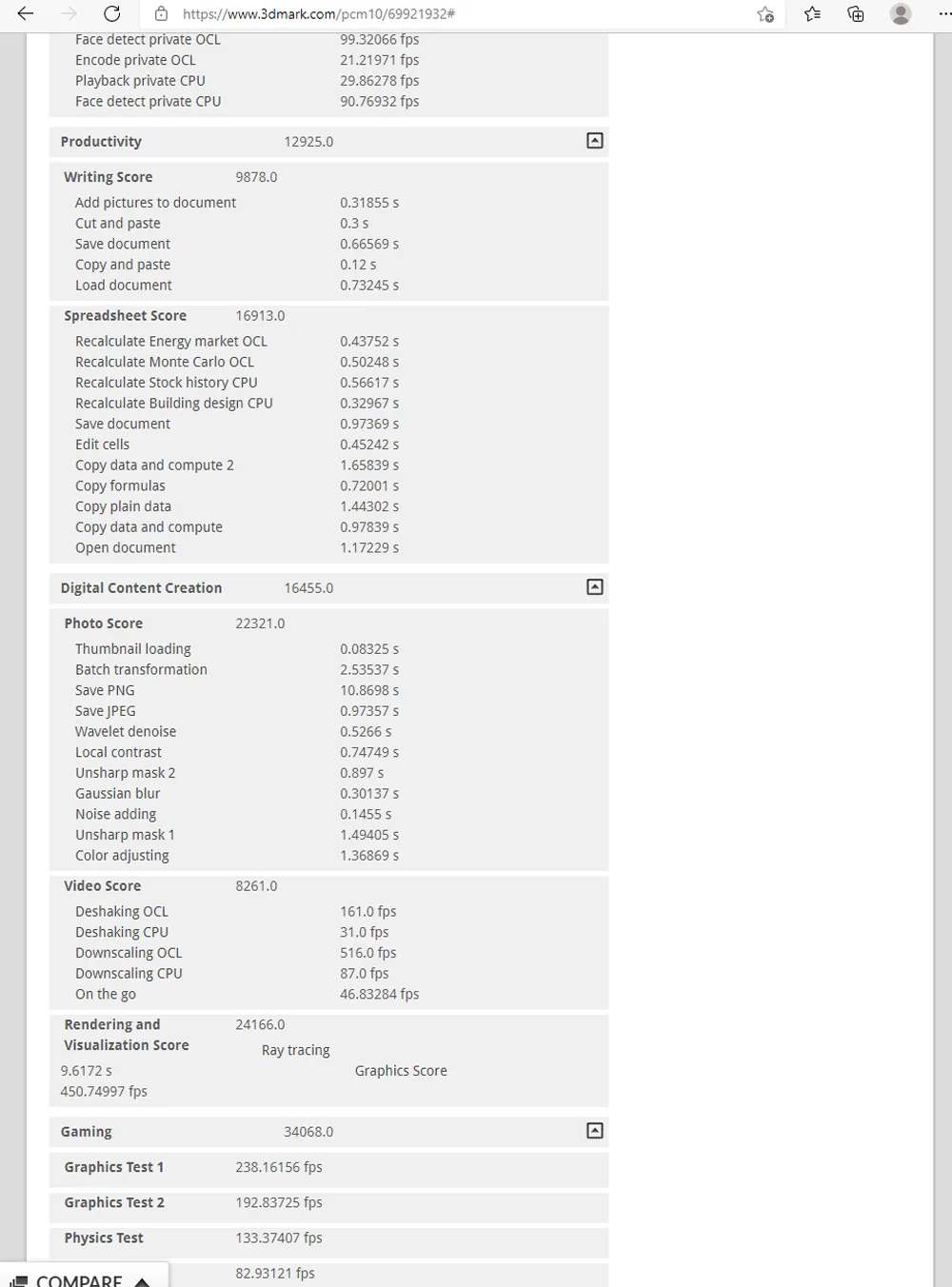 Next up is the CARDEA IOPS Extended score with 13304
Next up is the CARDEA IOPS Extended score with 13304 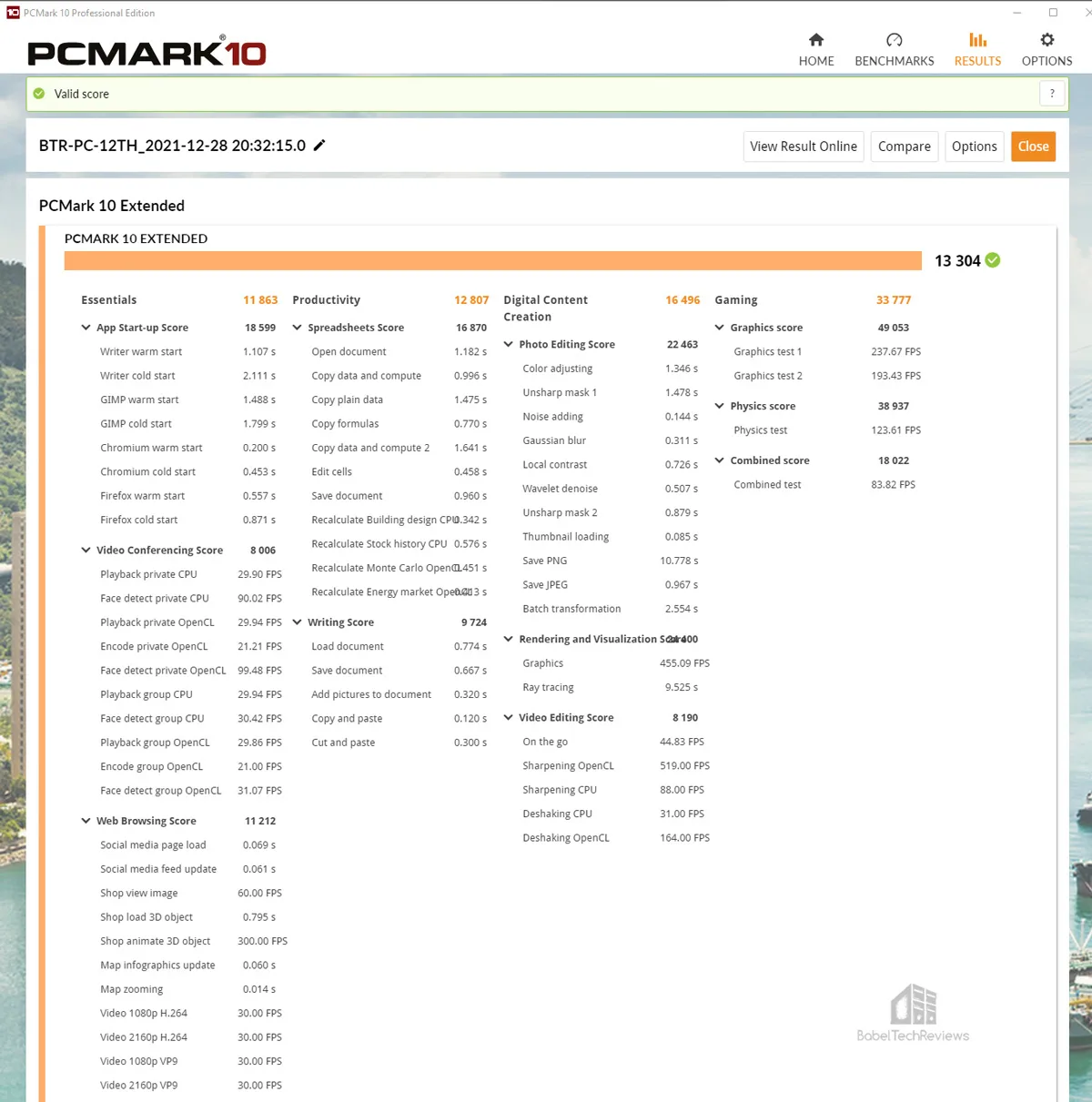 The online details are below.
The online details are below. 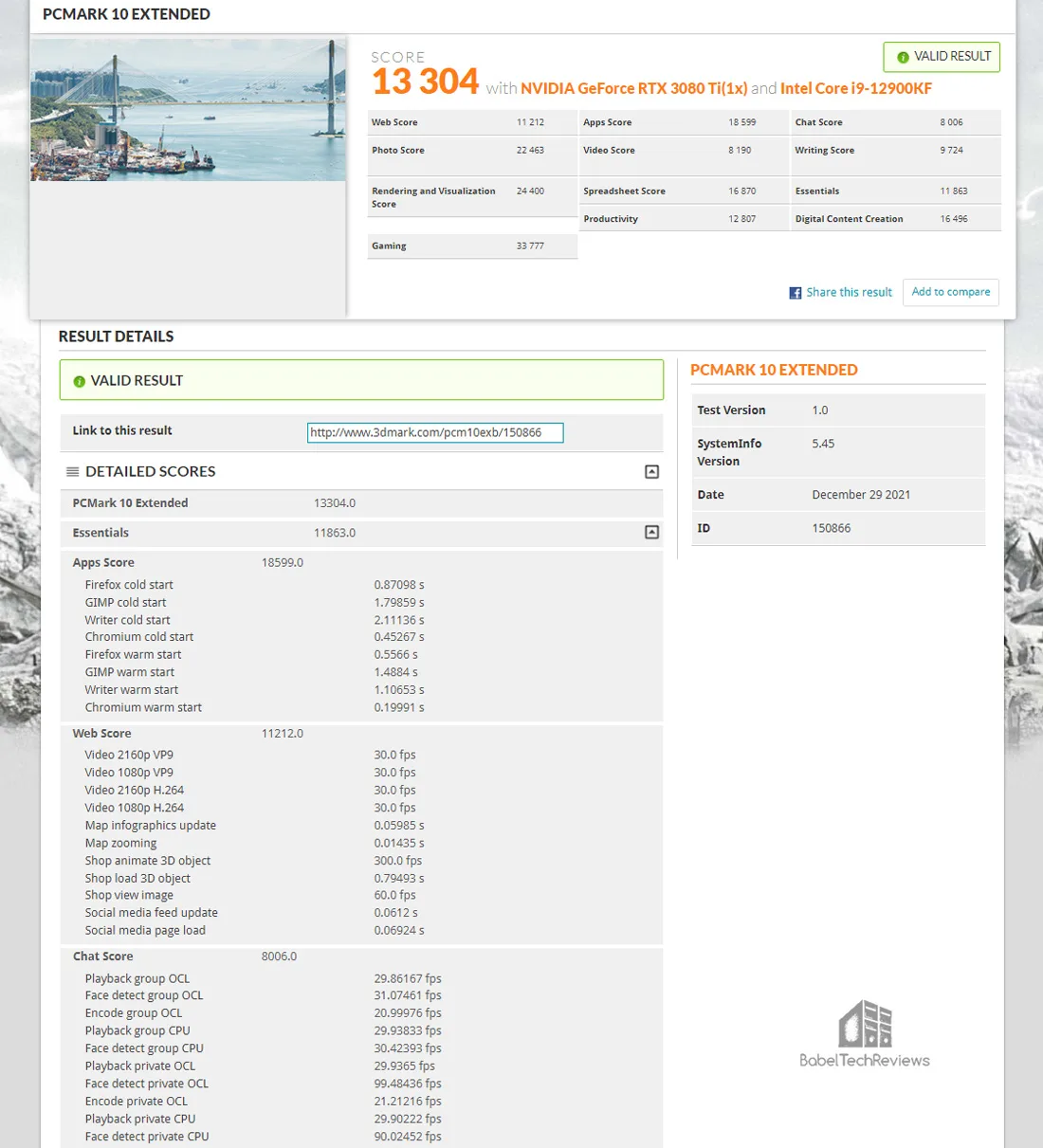
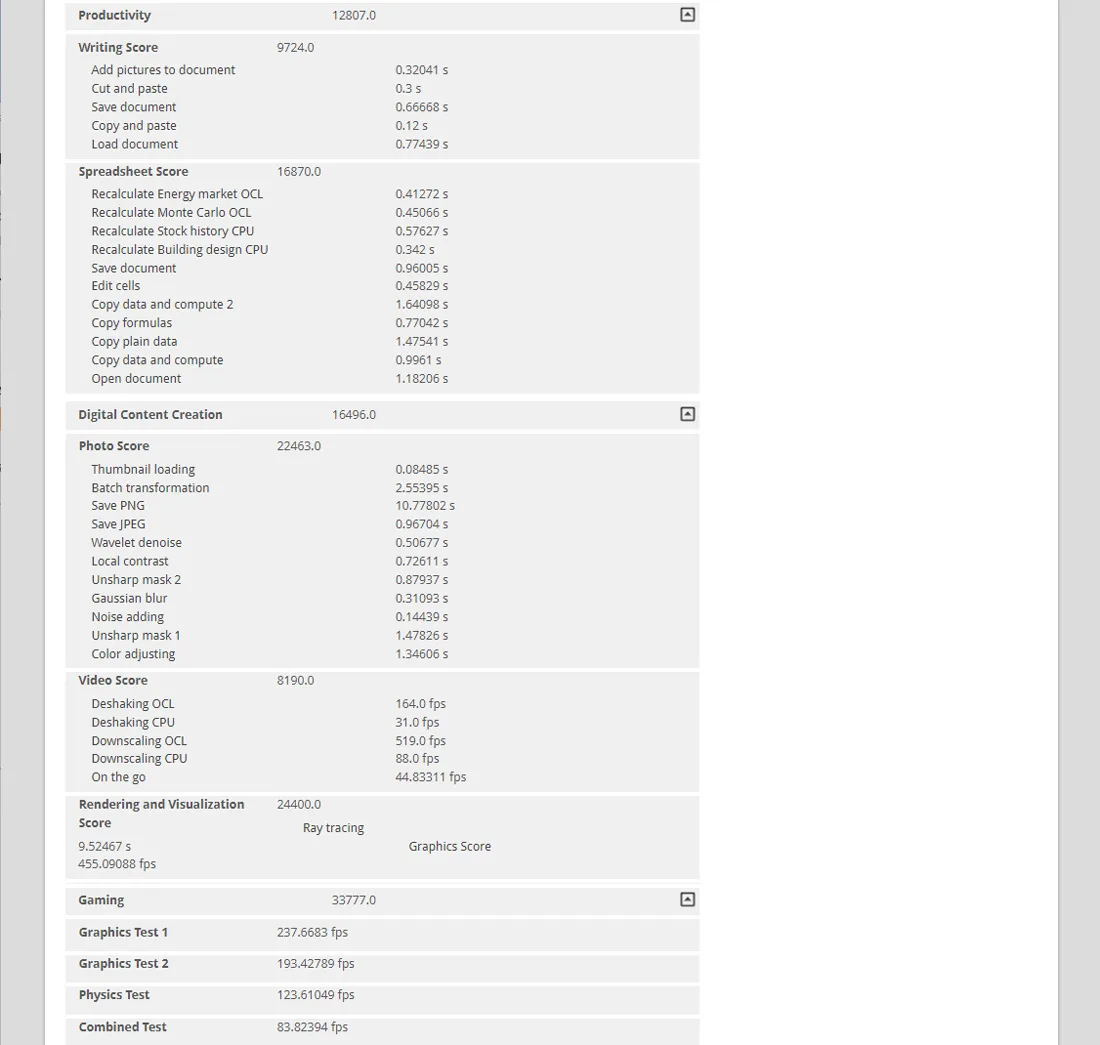 The TeamGroup MP33 SSD manages 13210.
The TeamGroup MP33 SSD manages 13210. 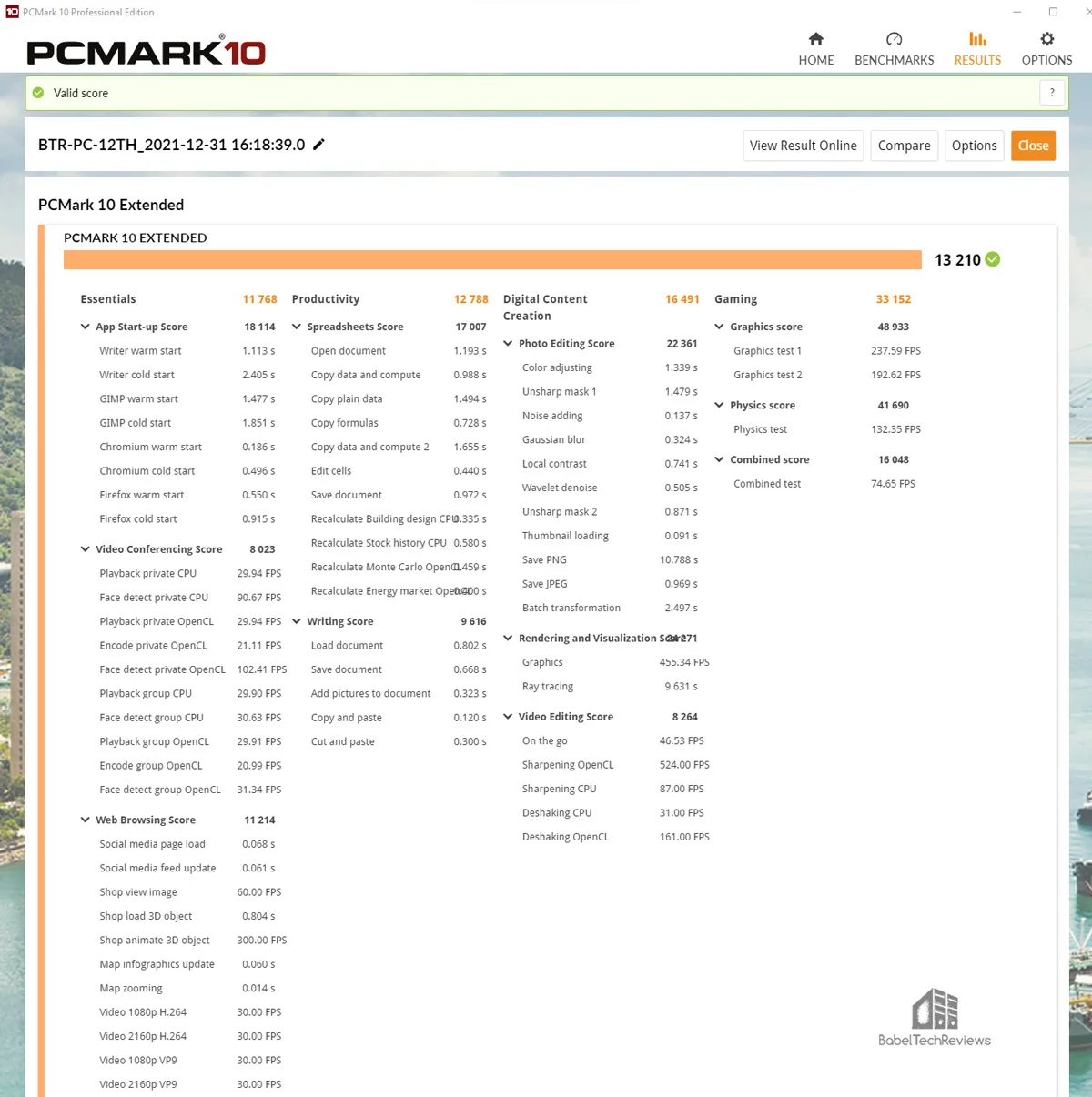 Finally, the online results are detailed.
Finally, the online results are detailed. 
 The Delta MAX SATA III SSD could not be tested by the PC Mark10 Extended or Express benchmarks since Windows is not set up on it. Here are the summary charts followed again by the storage benchmark chart.
The Delta MAX SATA III SSD could not be tested by the PC Mark10 Extended or Express benchmarks since Windows is not set up on it. Here are the summary charts followed again by the storage benchmark chart.


Let’s check out the older PCMark 8 benchmark suite which also uses dedicated storage tests.
PCMARK 8
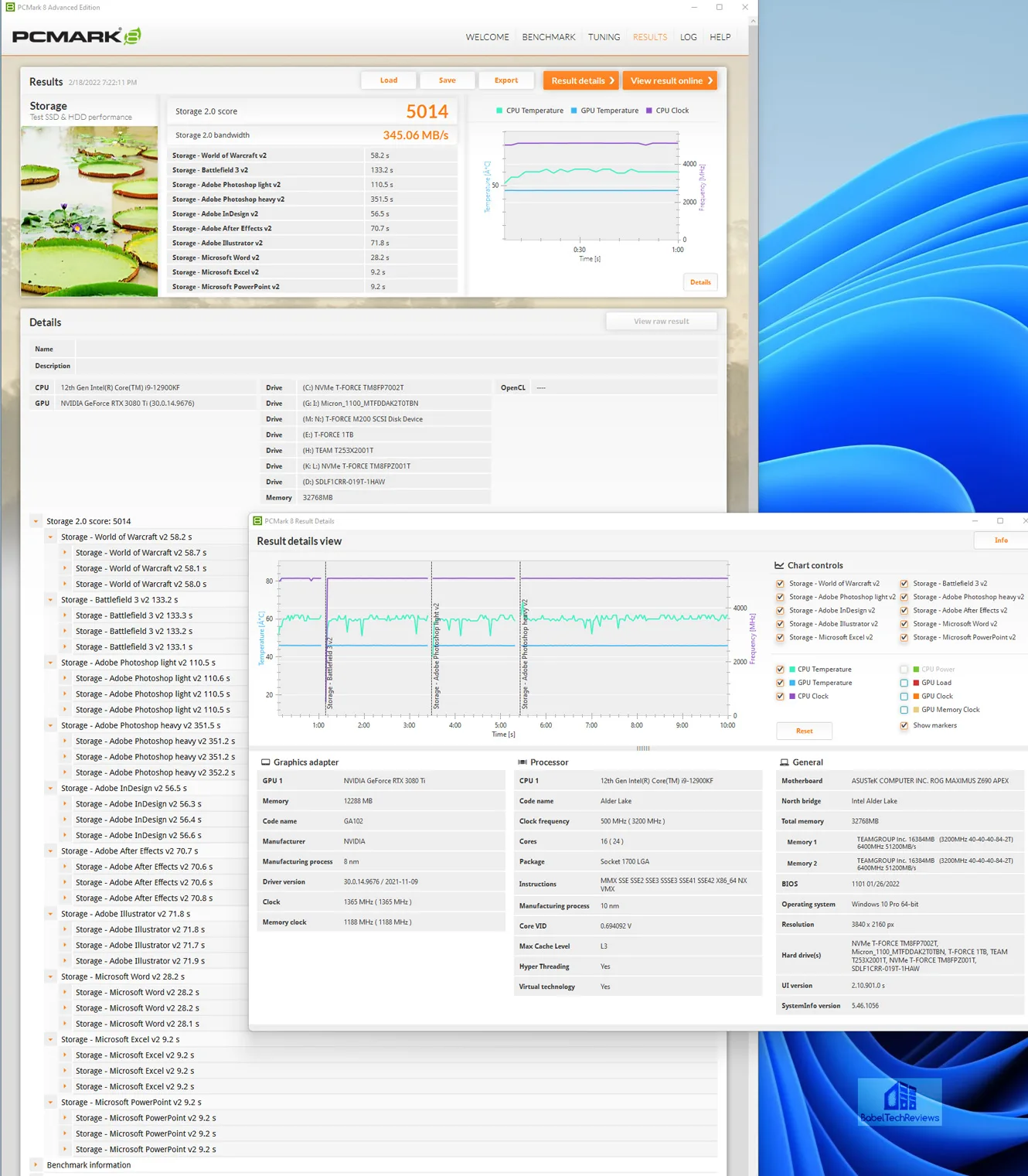
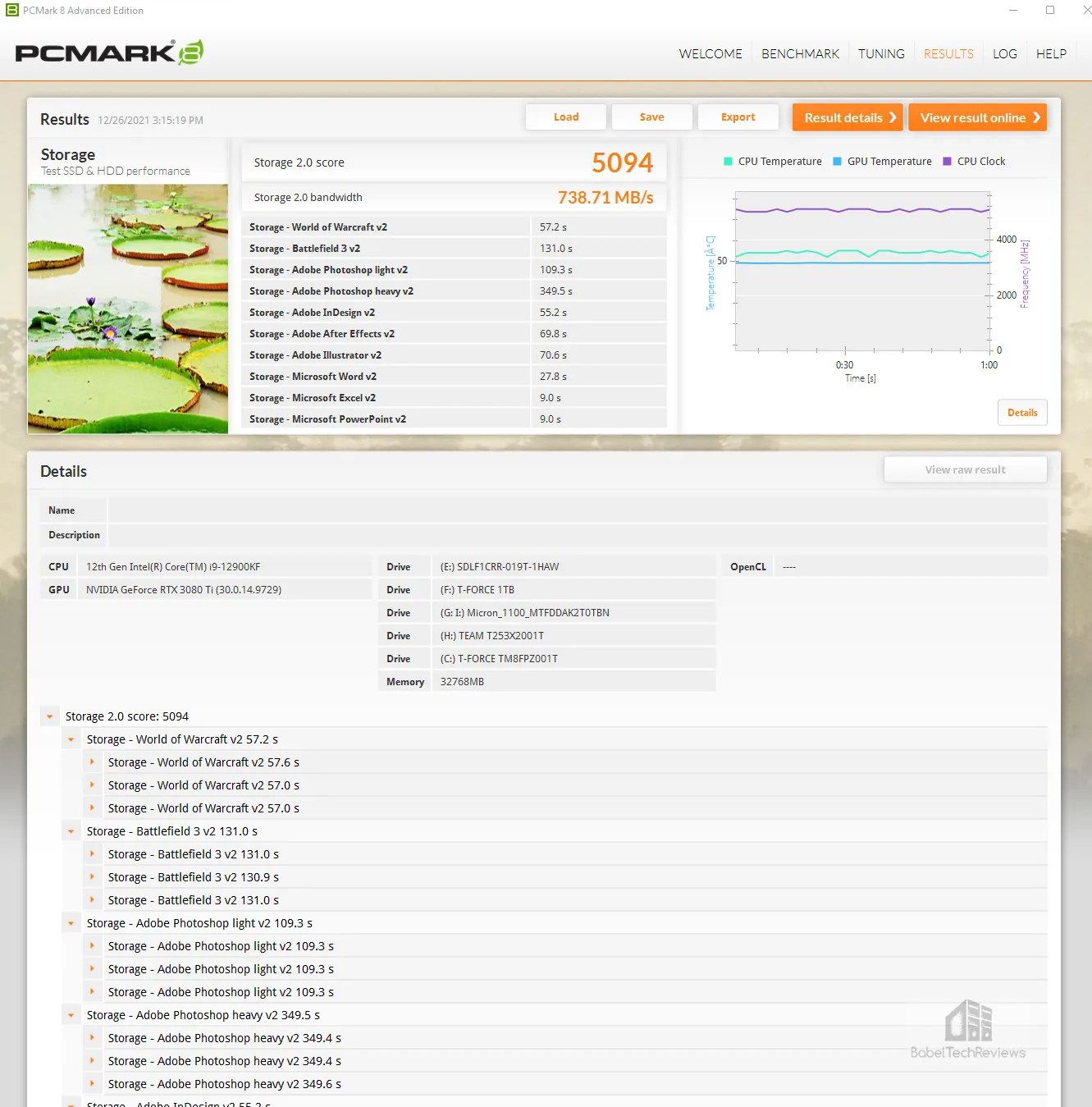
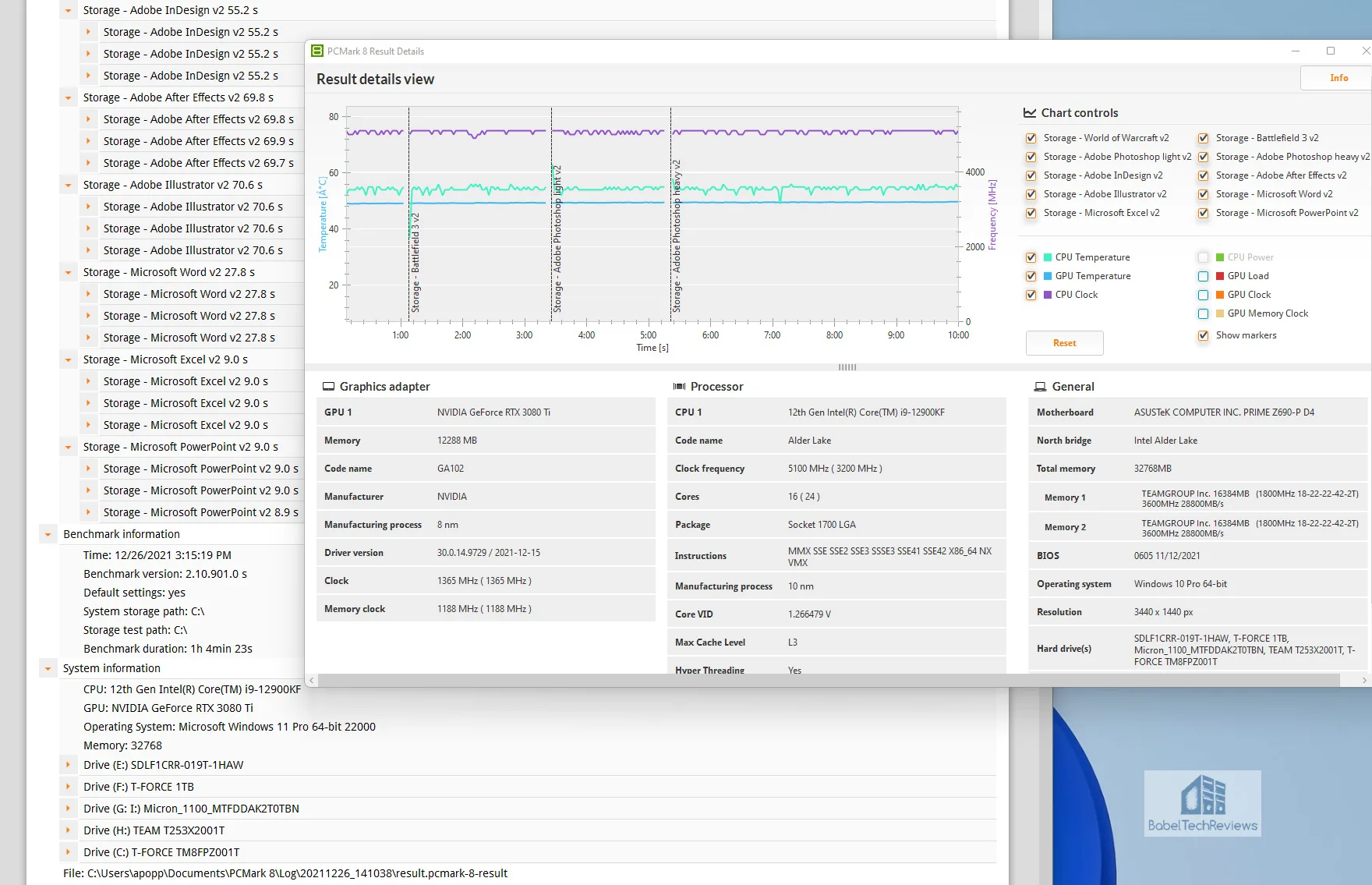
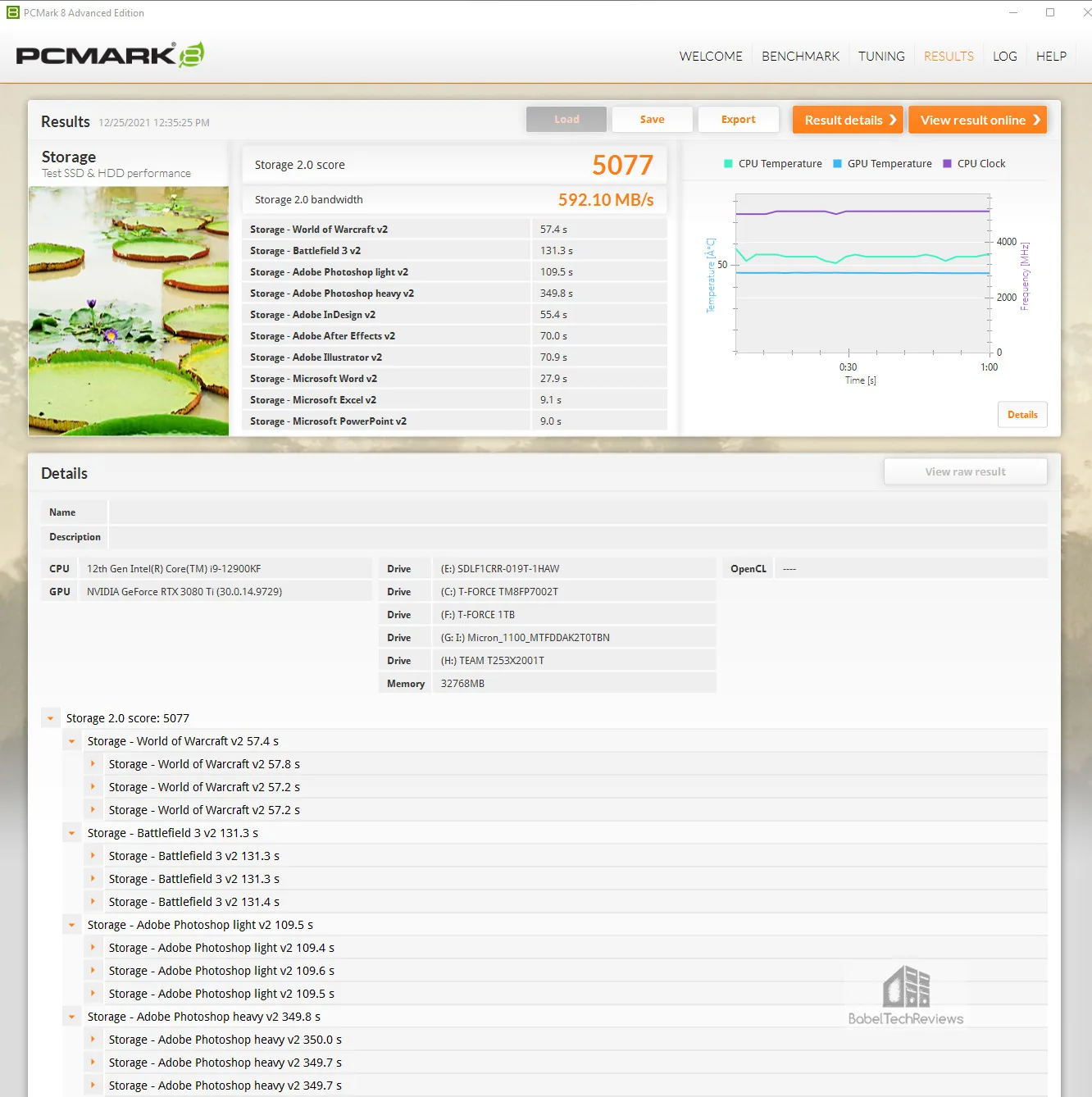
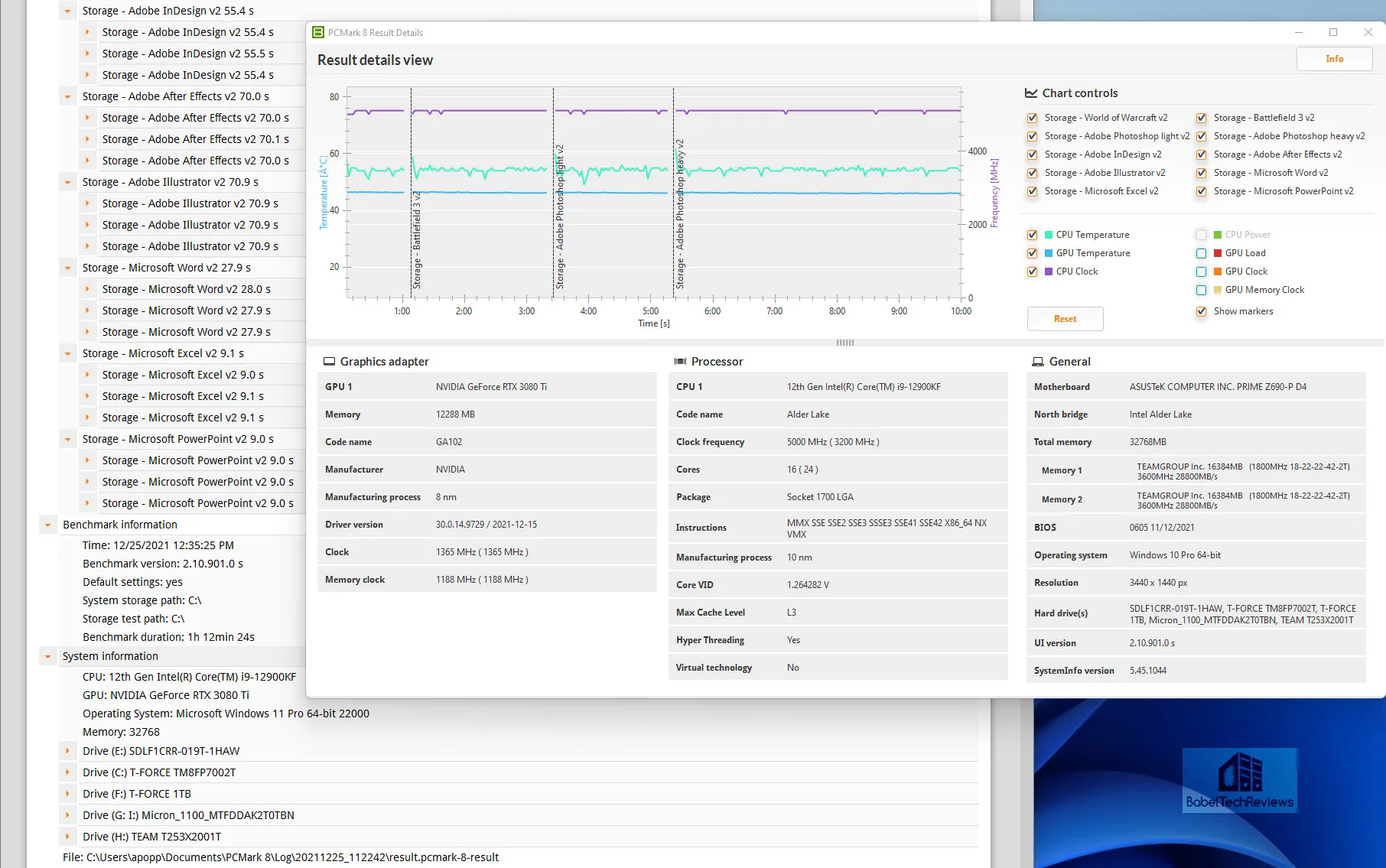
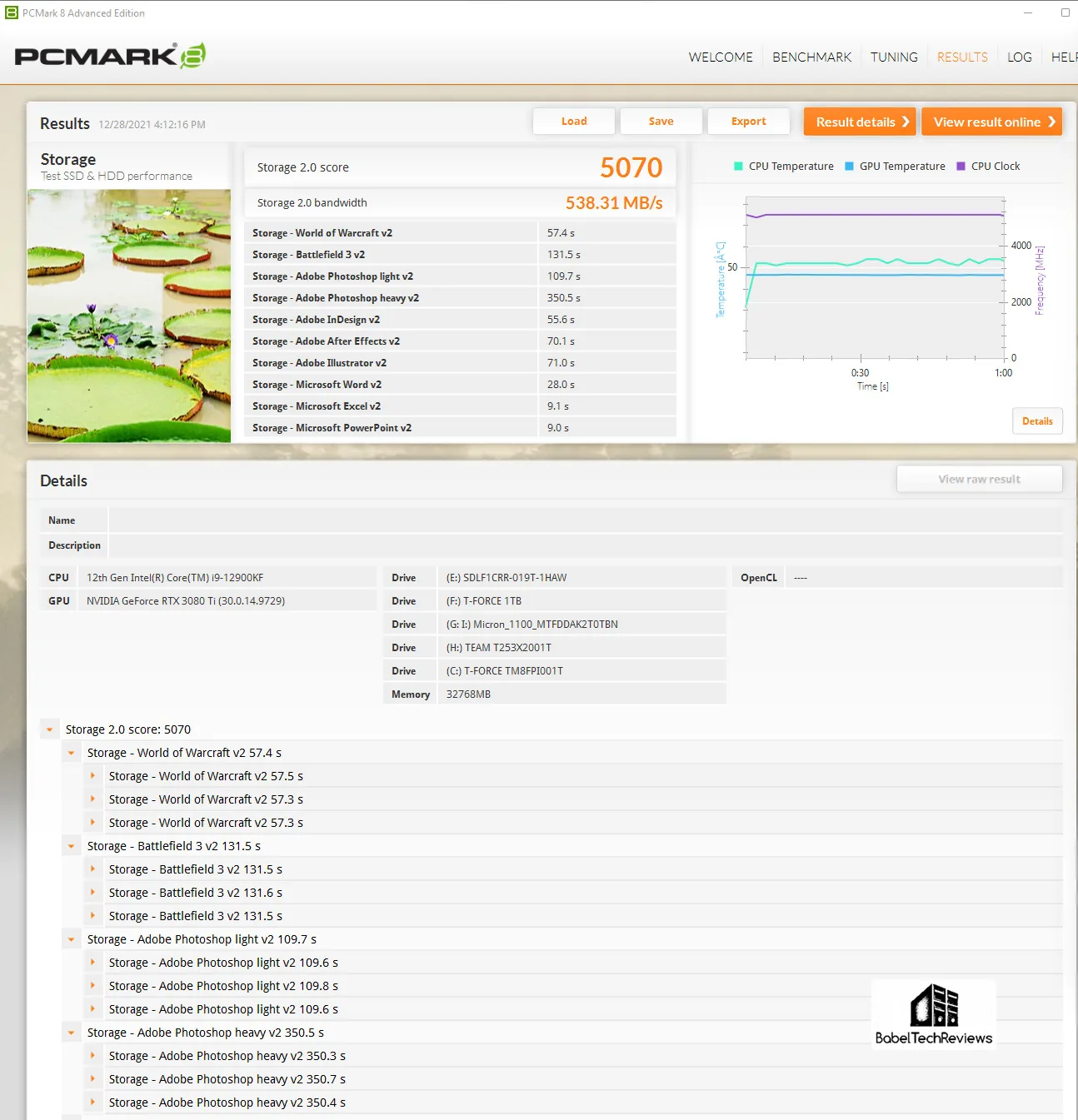

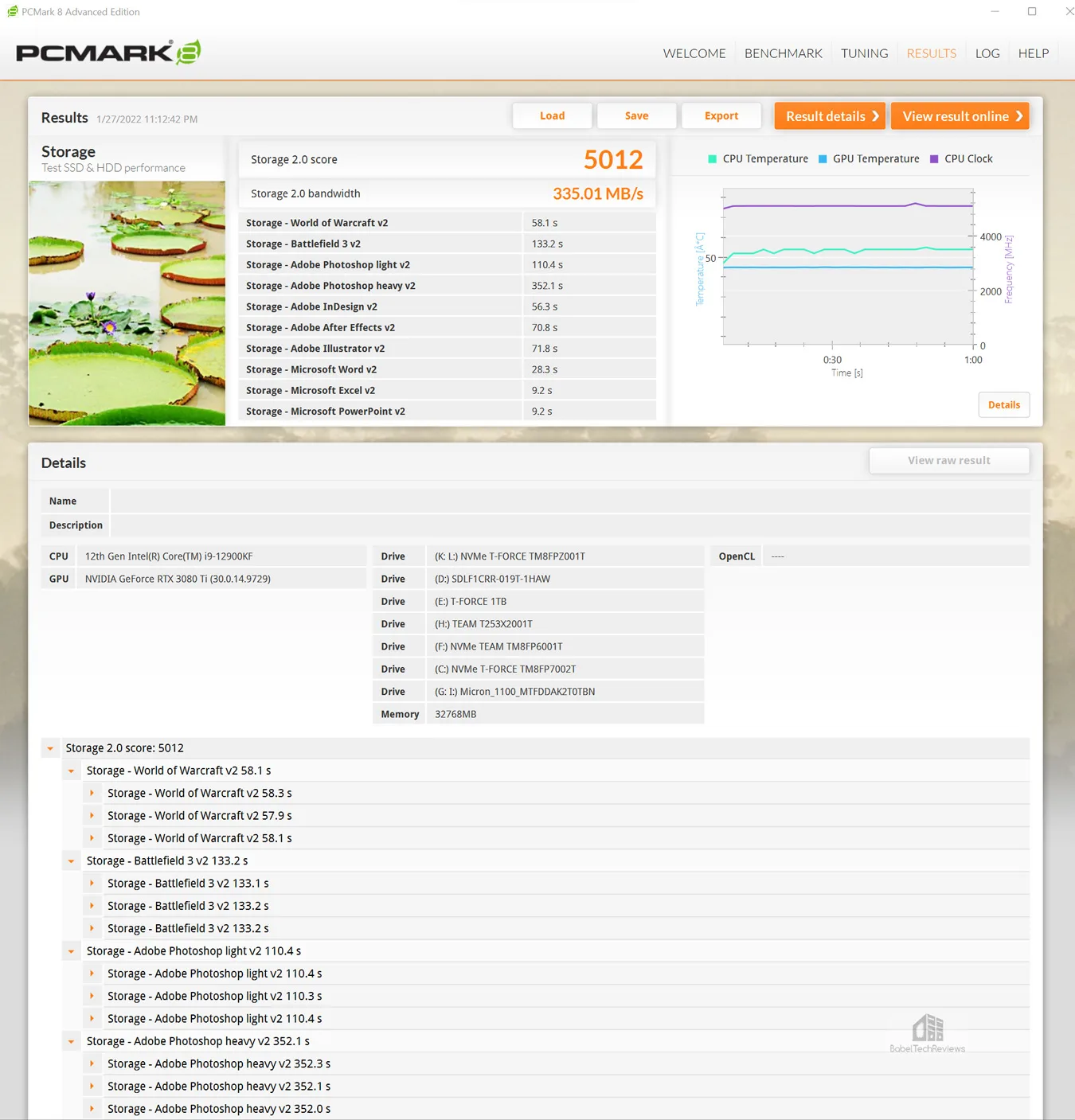
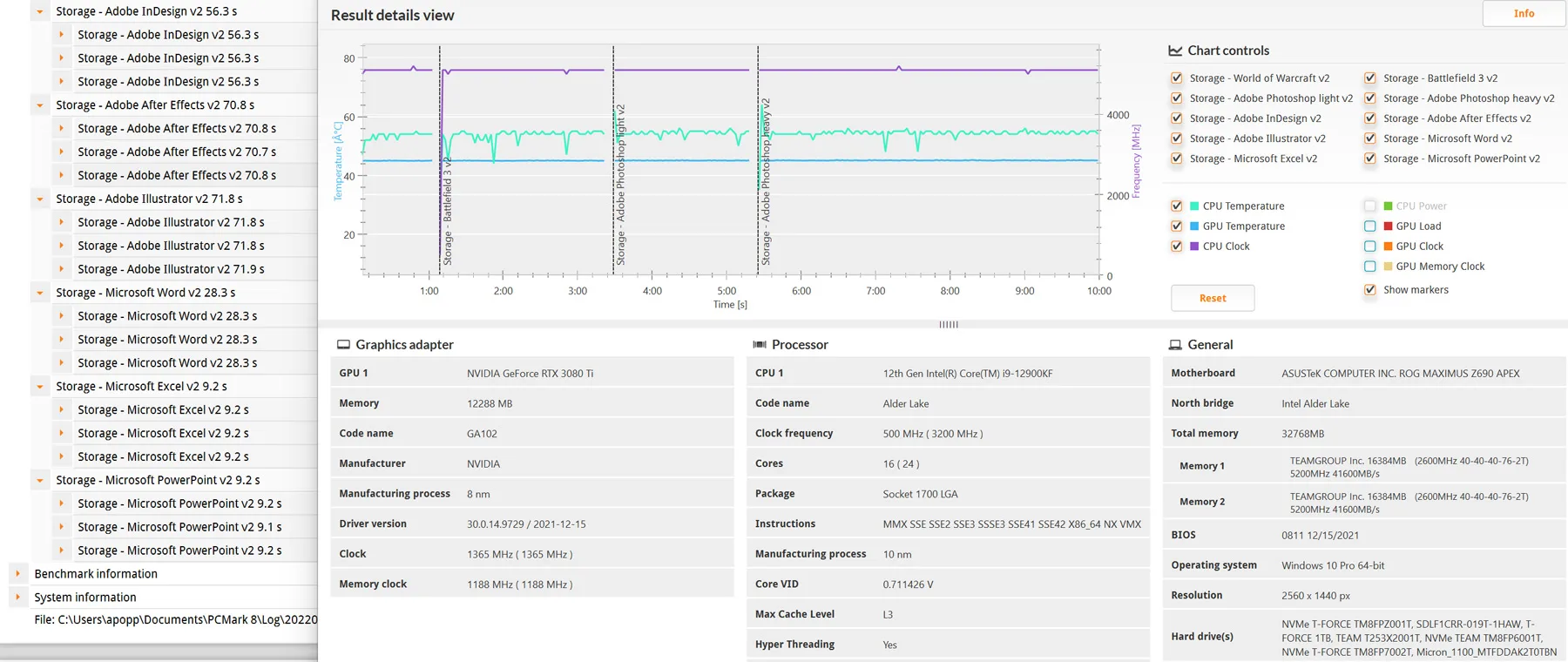
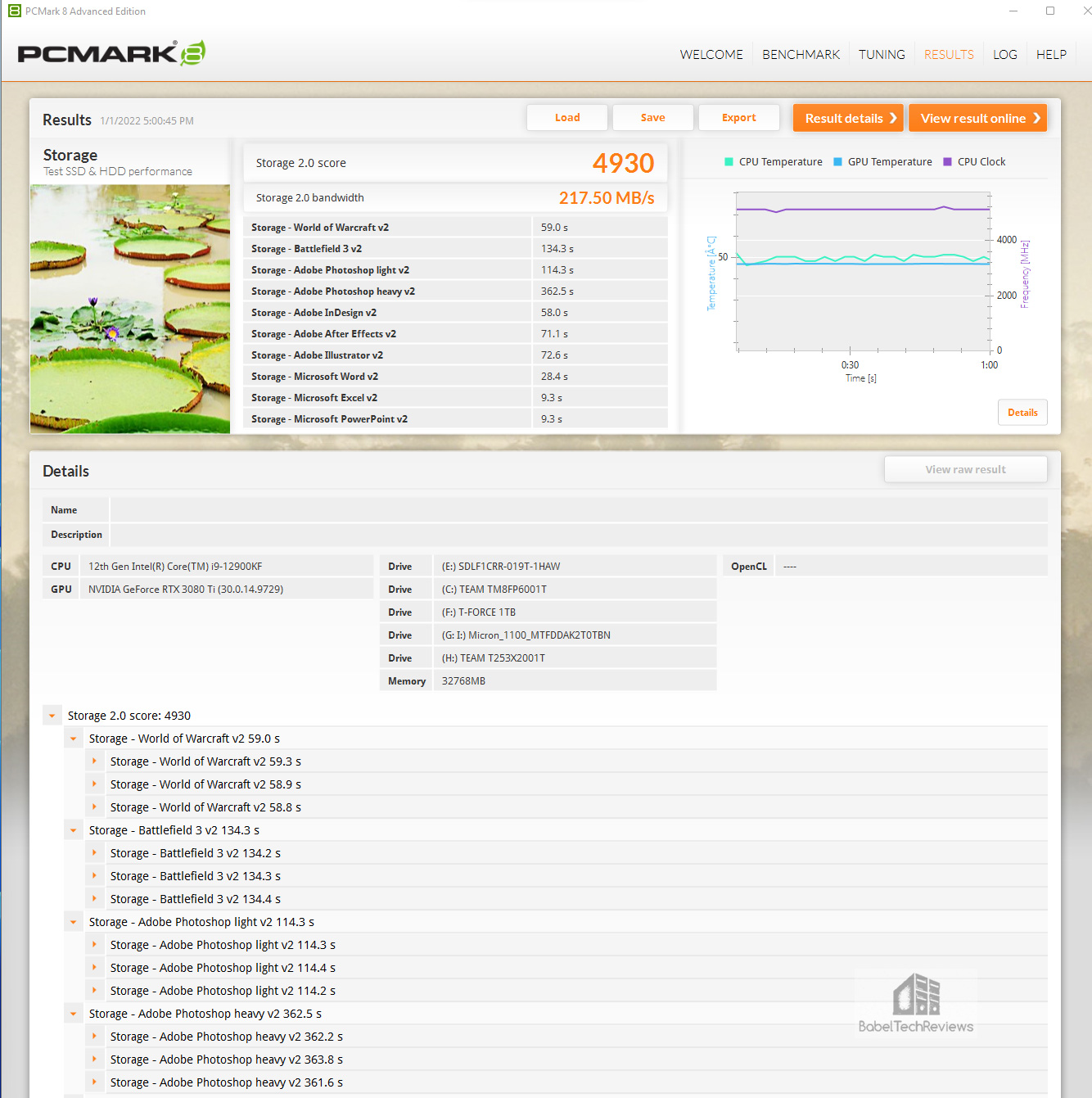
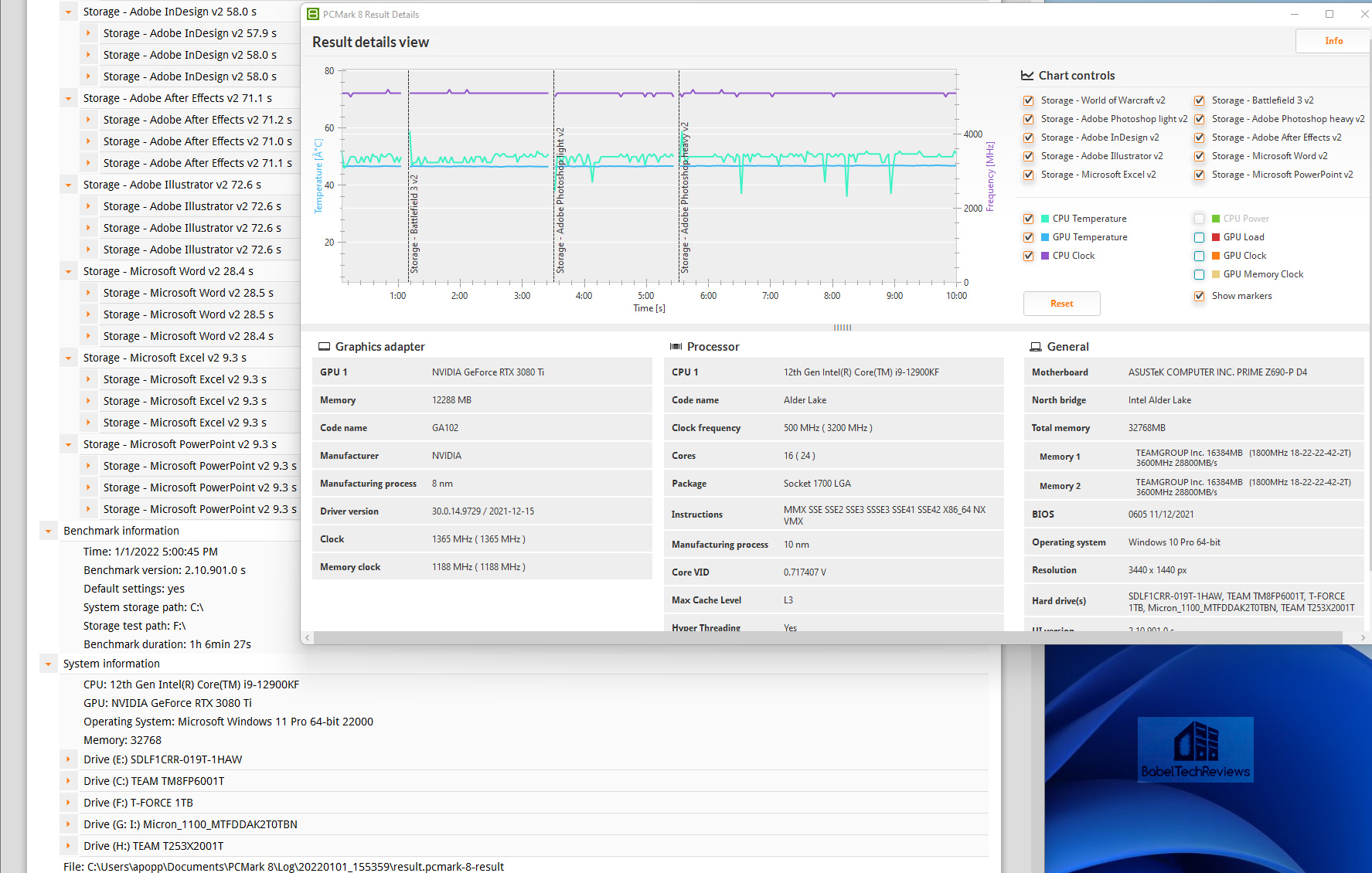


SiSoft Sandra 2020/2022
To see exactly where drive performance results differ, there is no better tool than SiSoft’s Sandra 2020. Sandra (the System ANalyser, Diagnostic and Reporting Assistant) is a complete information & diagnostic utility in one package. It is able to provide all of the information about your hardware, software, and other devices for diagnosis and for benchmarking.

AIDA64 v6.32
AIDA64 is the successor to Everest and it is an important industry tool for benchmarkers. AIDA64’s benchmark code is written in Assembly language, and they are well-optimized for AMD, Intel and VIA processors by utilizing the appropriate instruction set extensions. We use the Engineer’s version of AIDA64 courtesy of FinalWire. AIDA64 is free to to try and use for 30 days.
- The Linear Read test measure sequential performance by reading or writing all sectors without skipping any. It’s a linear view of the drives overall performance from its beginning to end.
- The Random Read test measures the random performance by reading variable-sized data blocks at random locations on the drive and they are combination of both speed and access times as its position changes before each new operation.
- The Buffered Read test measures the drive caching.
- The Access time tests are designed to measure the data access performance by reading 0.5 KB data blocks at random drive locations
The Read Test Suite for the M200 Portable runs relatively quickly.
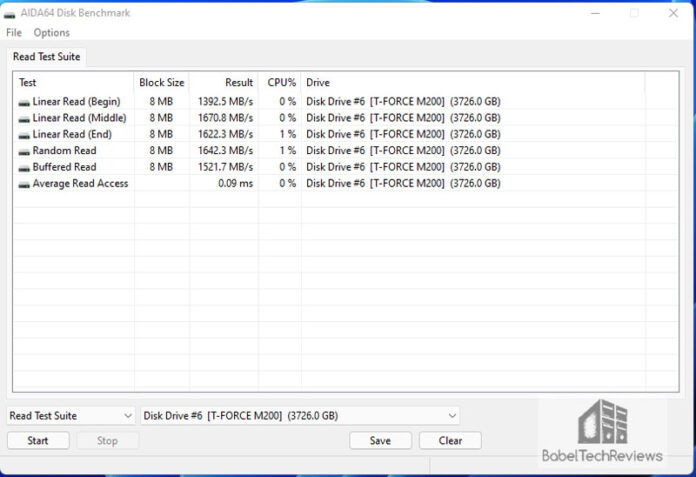
The individual benchmarks take much longer but they are more accurate. It takes 196 minutes for a linear read across 4TB. The numbers at the top right of the chart represent the time the test took to complete and they are presented below without comment.
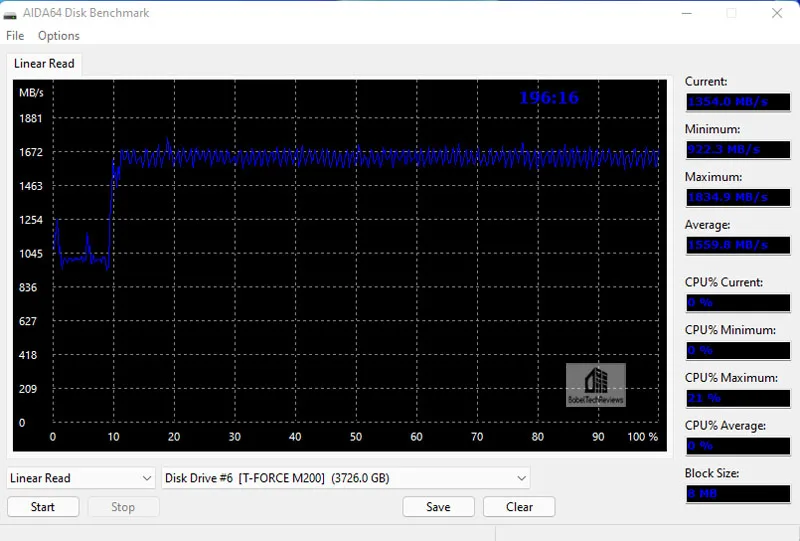
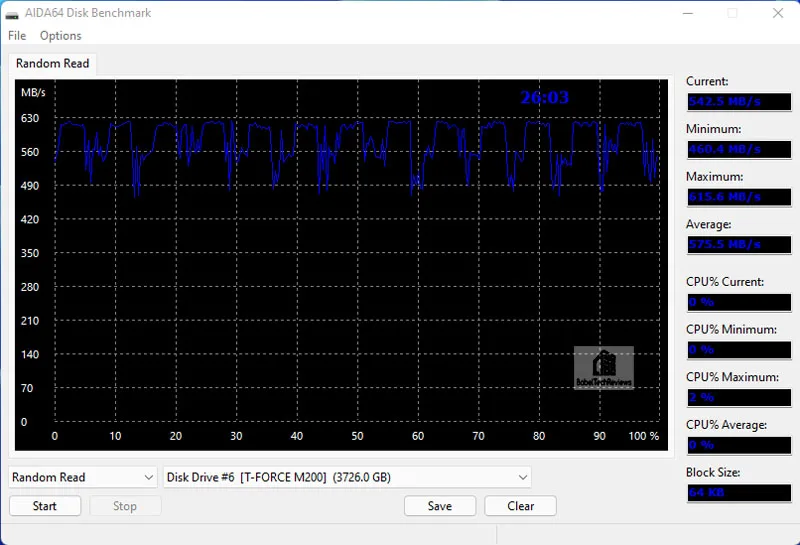
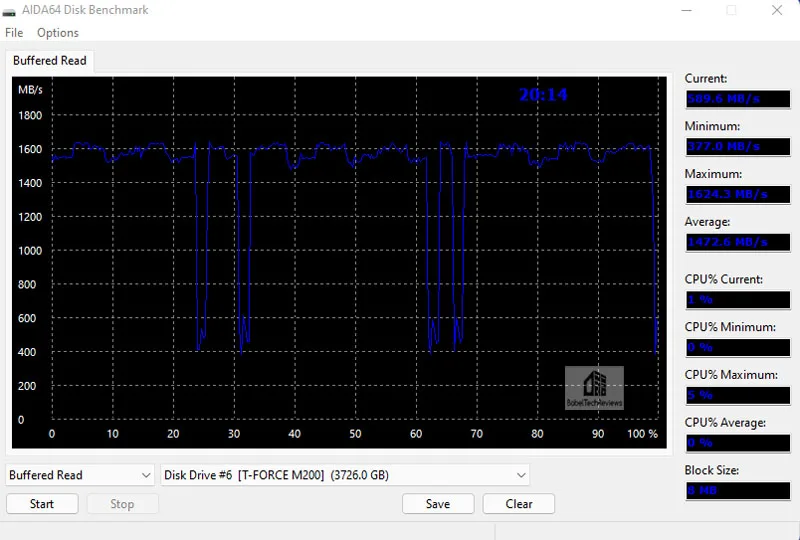
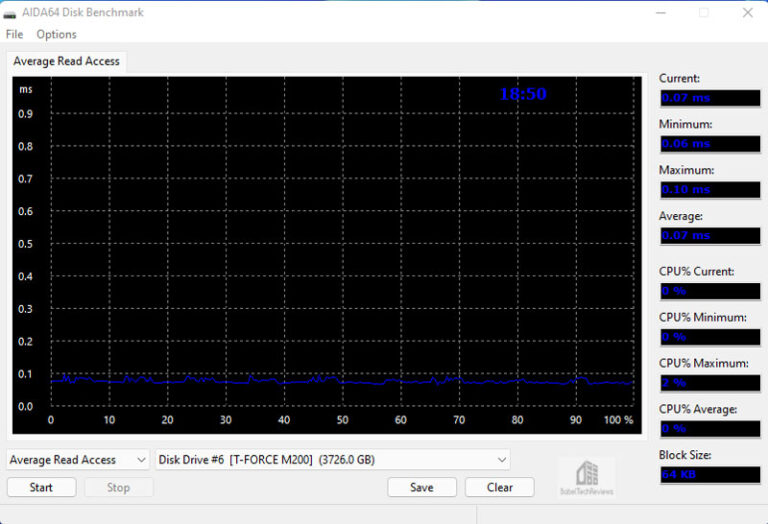
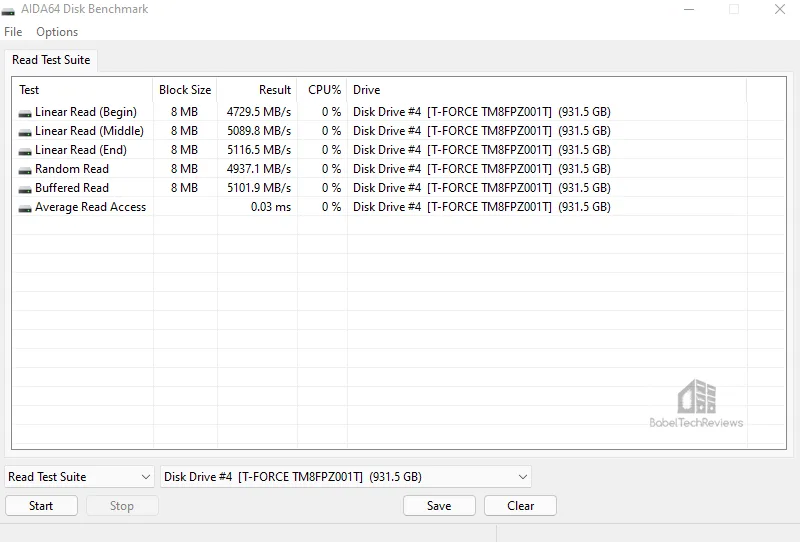

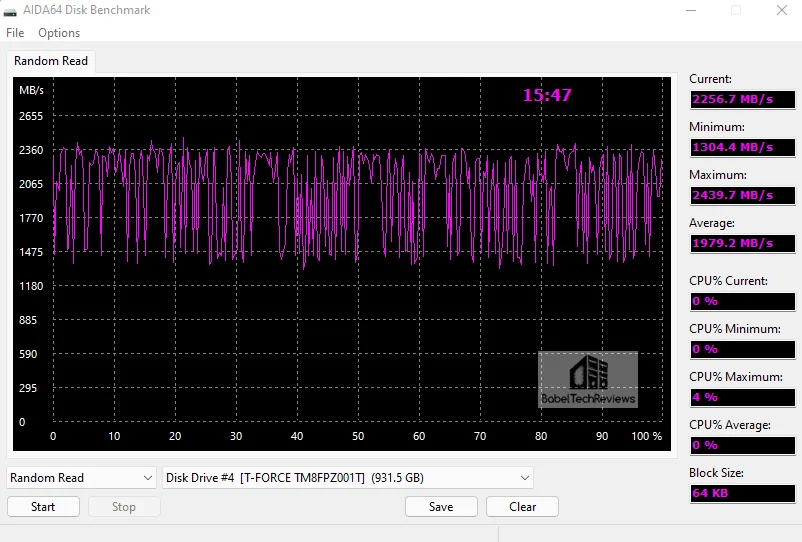
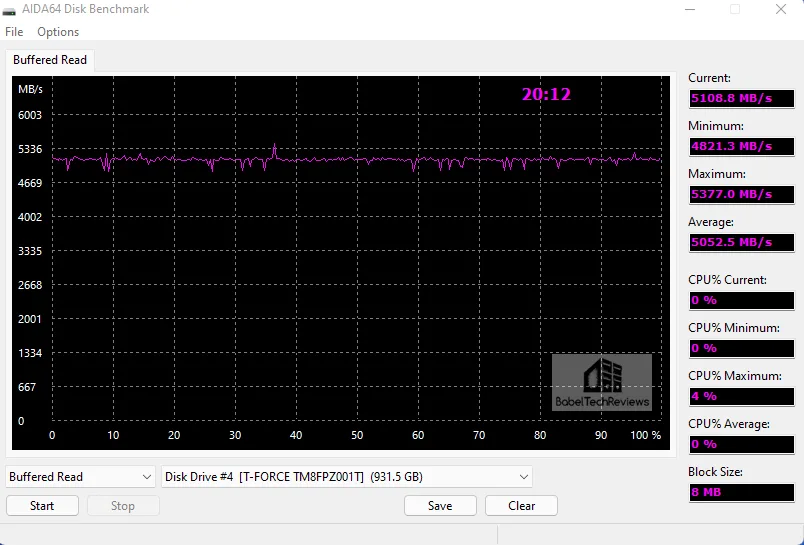
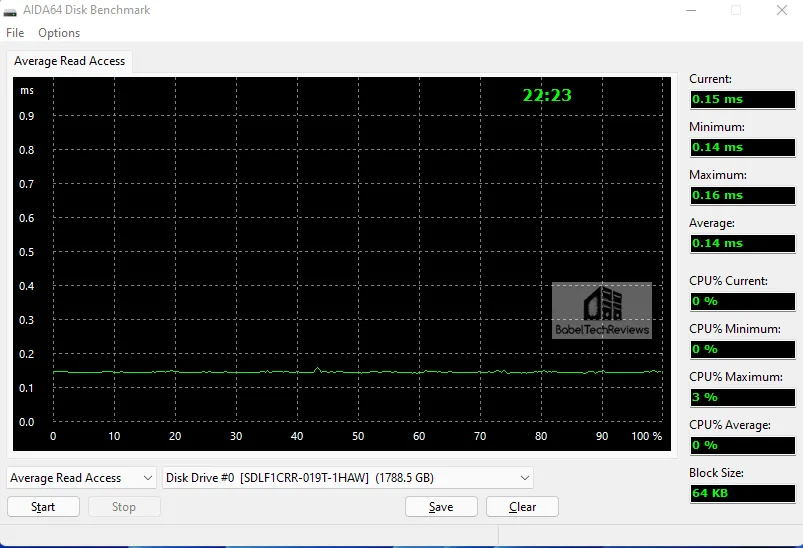 Next up, the C440 Ceramic SSD Read tests.
Next up, the C440 Ceramic SSD Read tests. 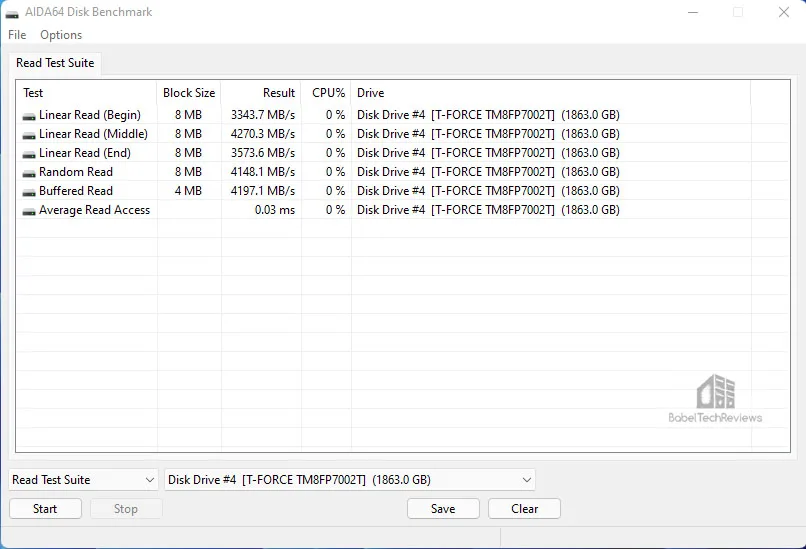
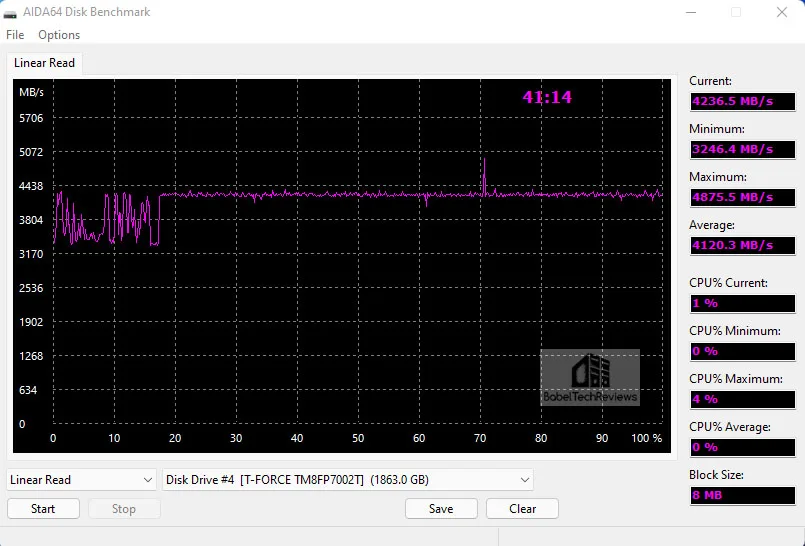
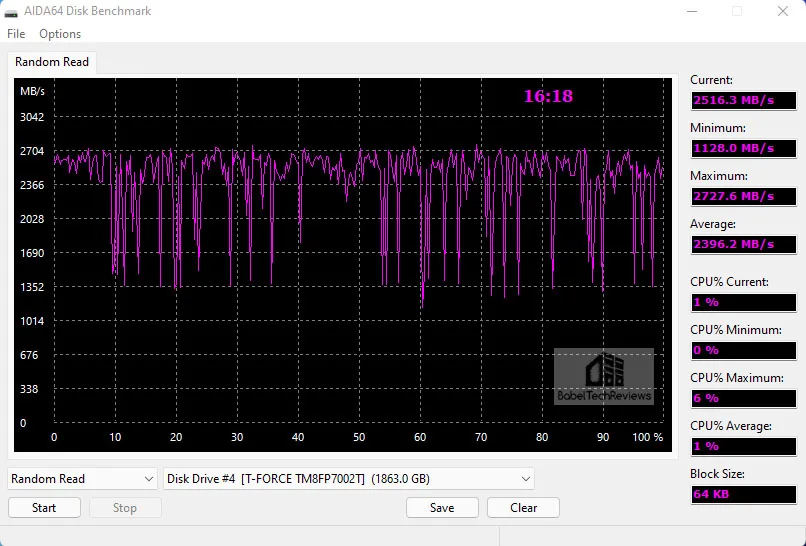
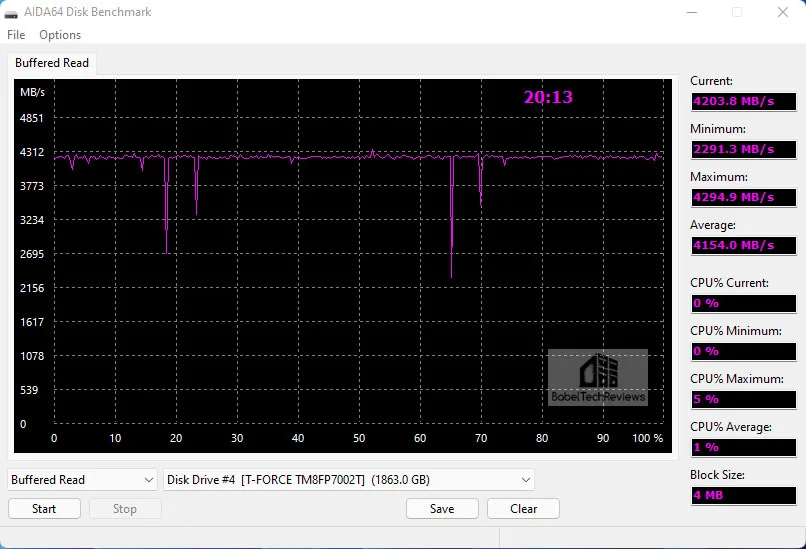
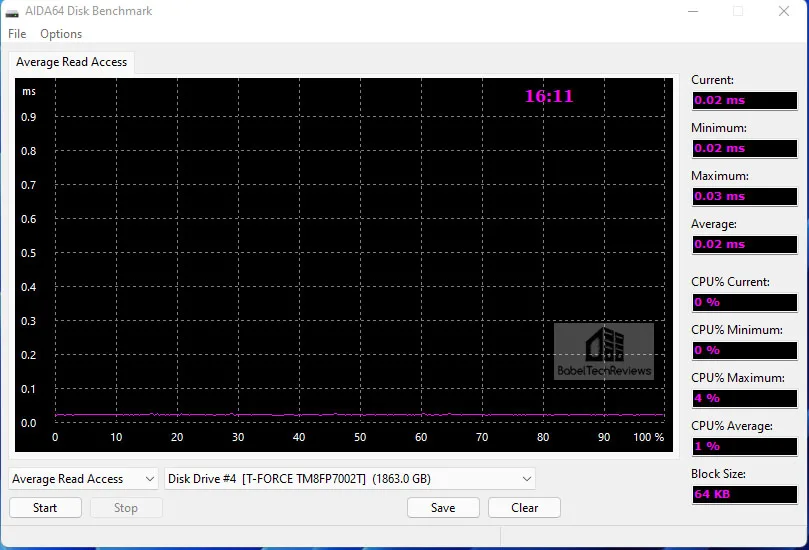 Now the CARDEA IOPS Read tests are shown below.
Now the CARDEA IOPS Read tests are shown below. 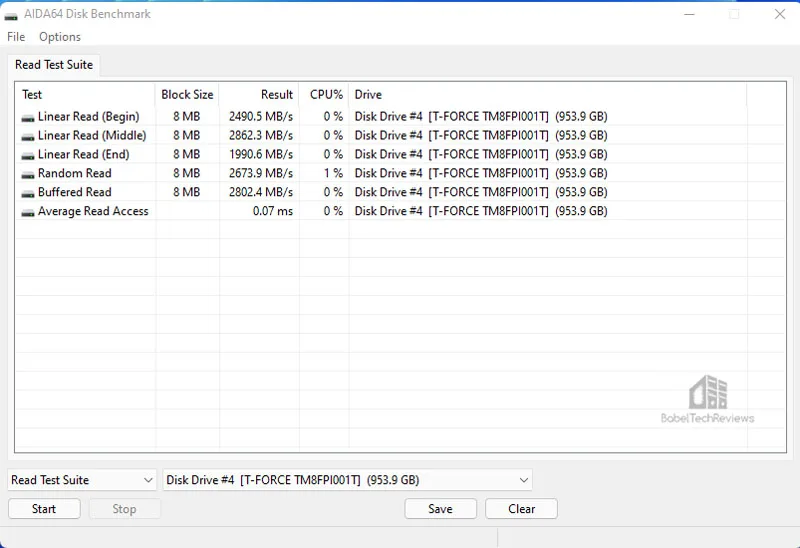

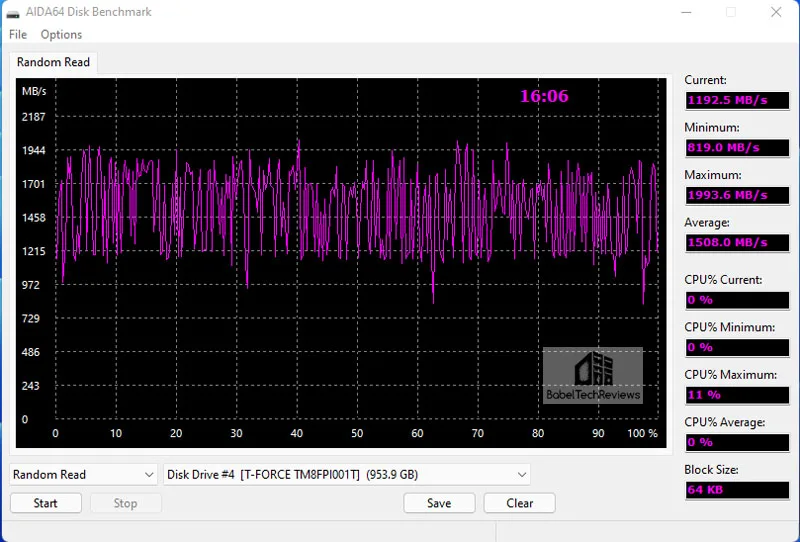

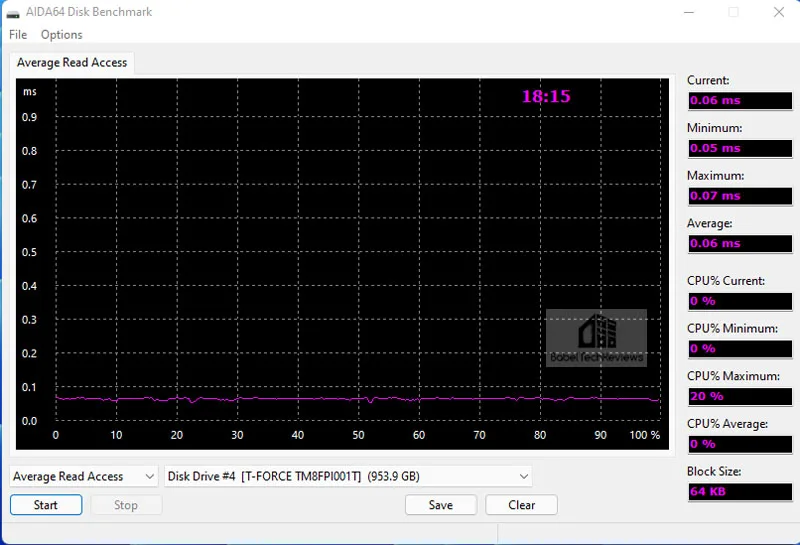 Next, the MP33 series of benchmarks are presented below.
Next, the MP33 series of benchmarks are presented below. 
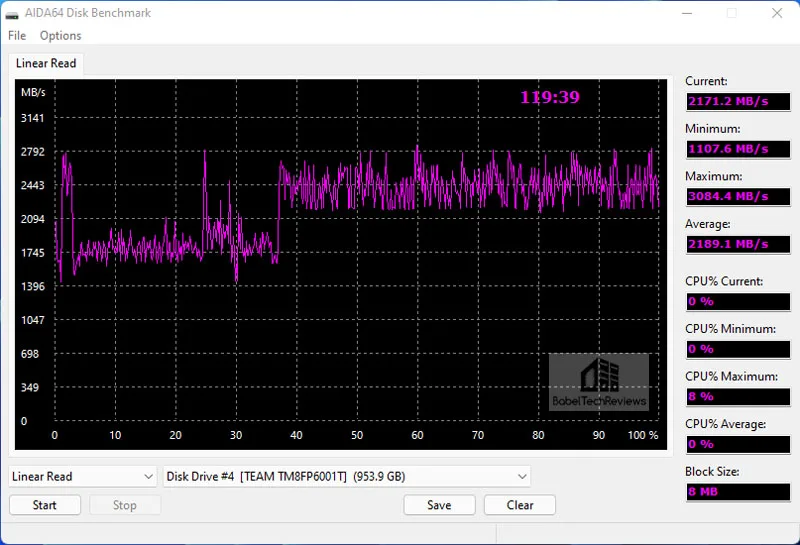
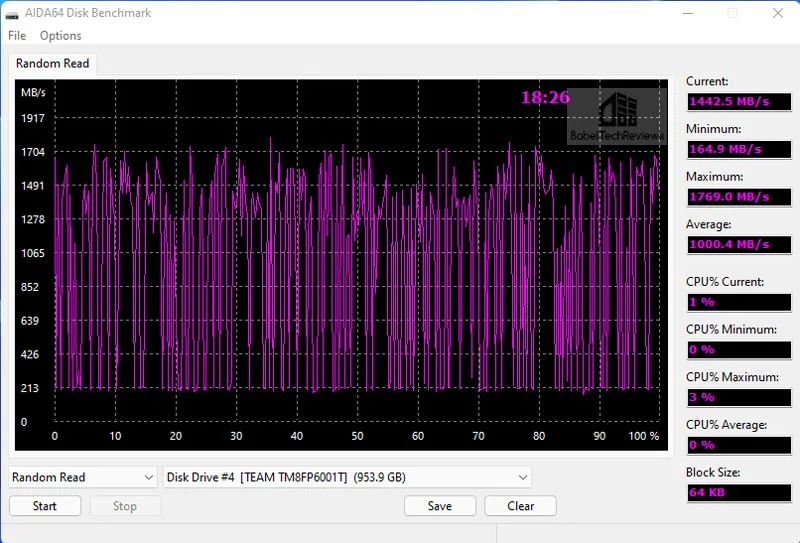

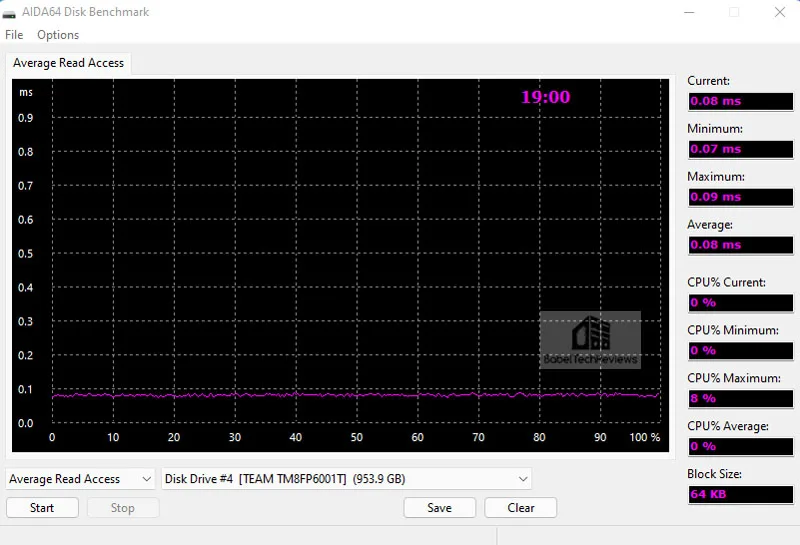 Finally, the Delta MAX SATA III series of benches are below.
Finally, the Delta MAX SATA III series of benches are below. 


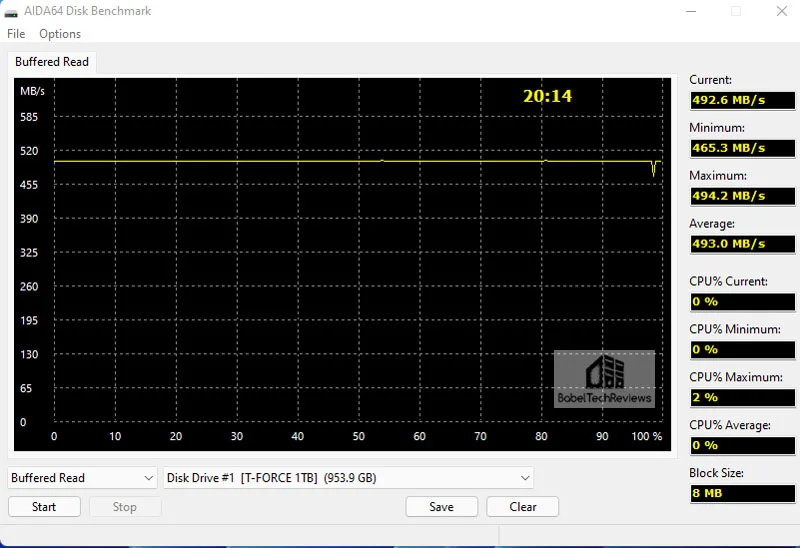
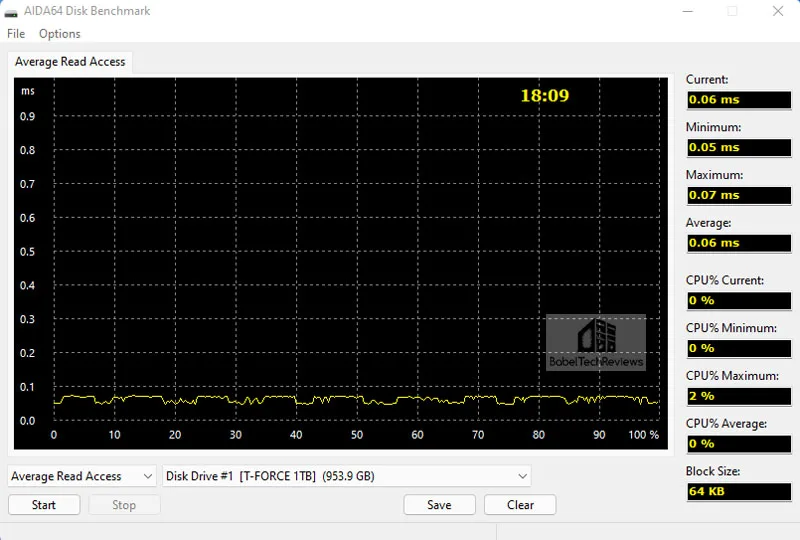 Here is the summary chart comparing our six tested drives where higher is better except for the Average Read Access where lower is better.
Here is the summary chart comparing our six tested drives where higher is better except for the Average Read Access where lower is better.

SPECworkstation3 (3.0.4) Storage Benchmarks
All the SPECworkstation3 benchmarks are based on professional applications, most of which are in the CAD/CAM or media and entertainment fields. All of these benchmarks are free except to vendors of computer-related products and/or services. The most comprehensive workstation benchmark is SPECworkstation3. It’s a free-standing benchmark which does not require ancillary software. It measures GPU, CPU, storage and all other major aspects of workstation performance based on actual applications and representative workloads.
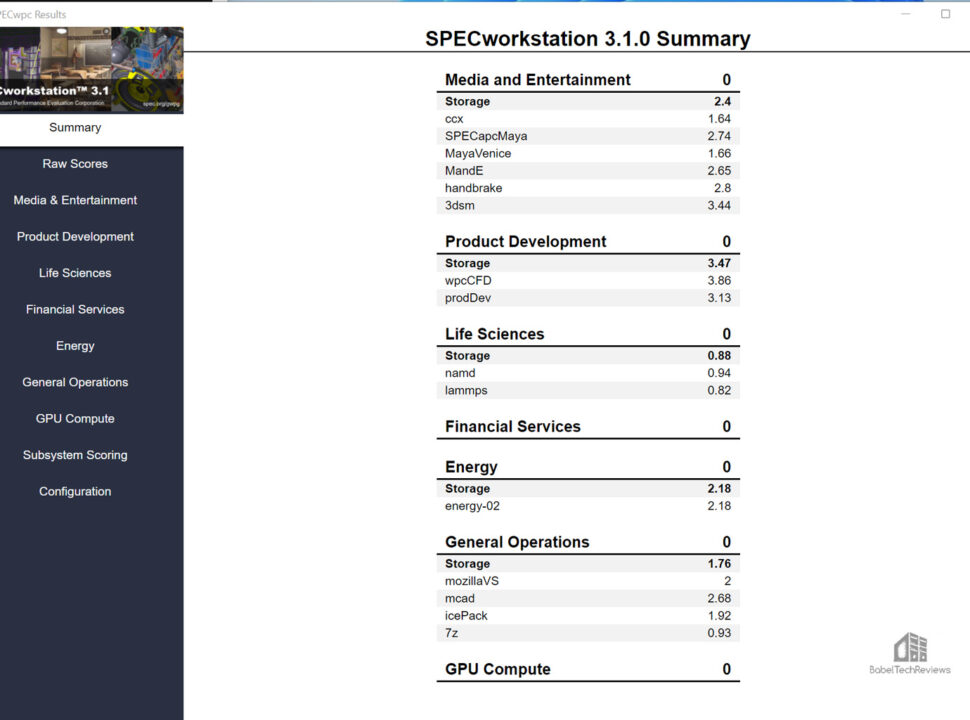
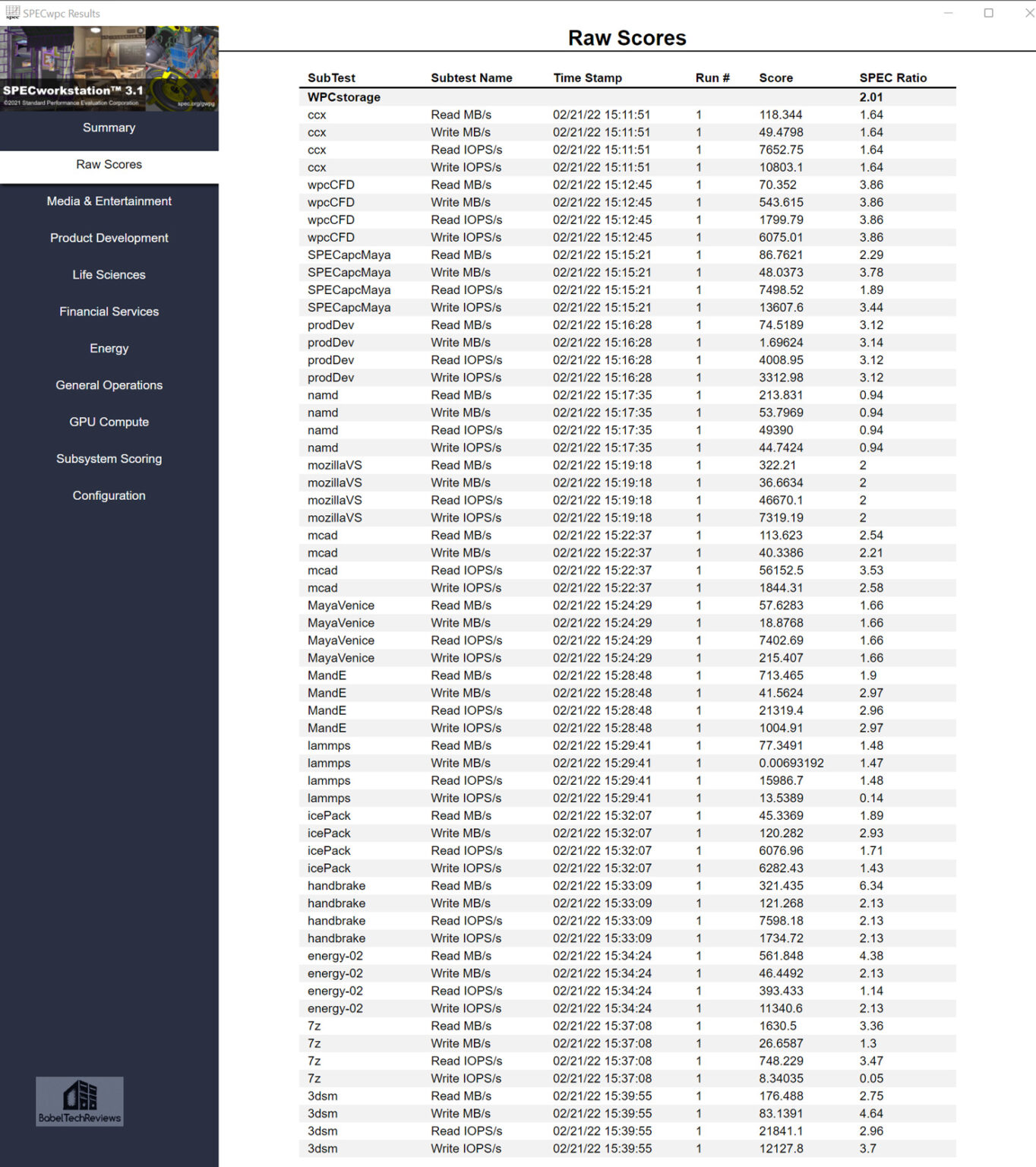
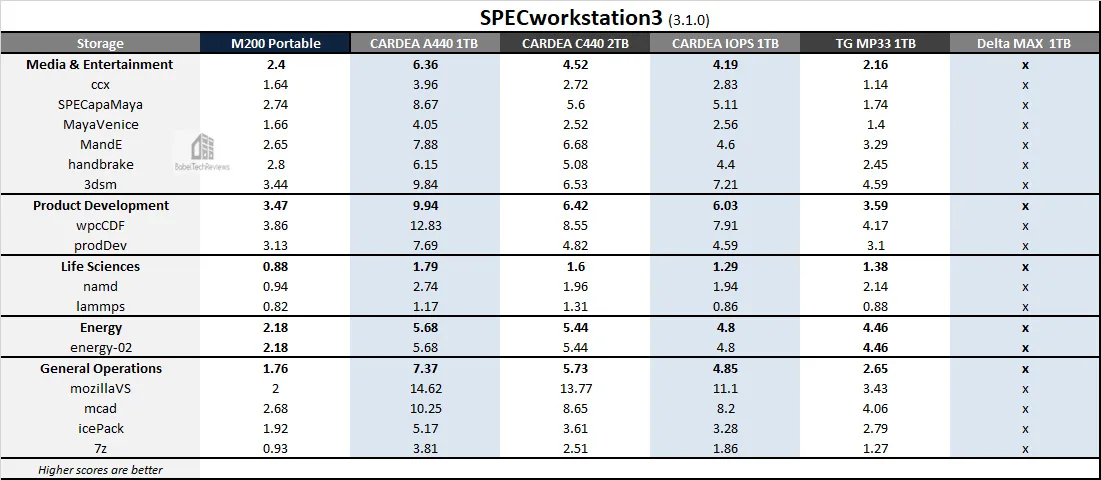
Anvil’s Storage Utilities
Anvil’s Storage Utilities is a tool designed to benchmark and evaluate the Read and Write performance of SSDs and HDDs. It gives overall bandwidth as well separate Read and Write scores, the response times, and IOPS capabilities.
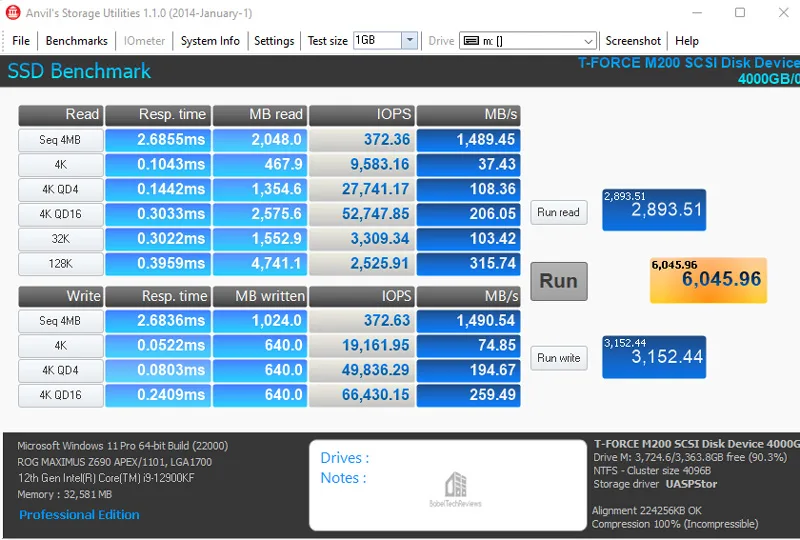
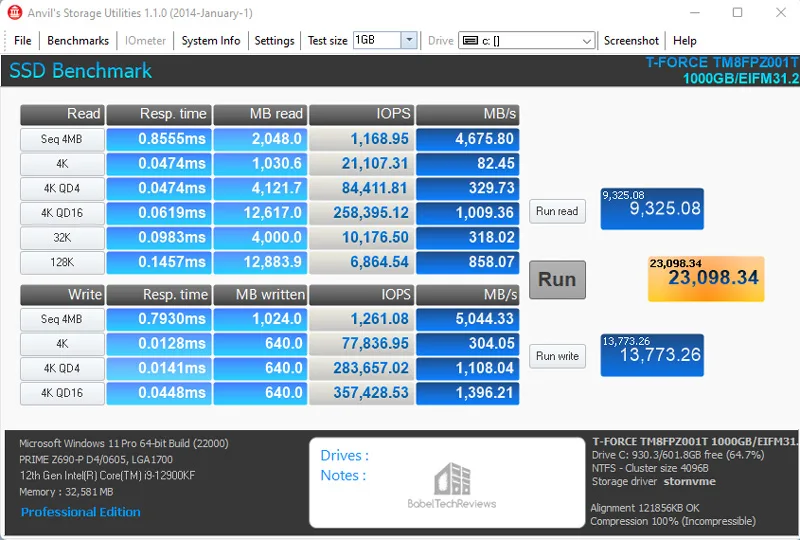
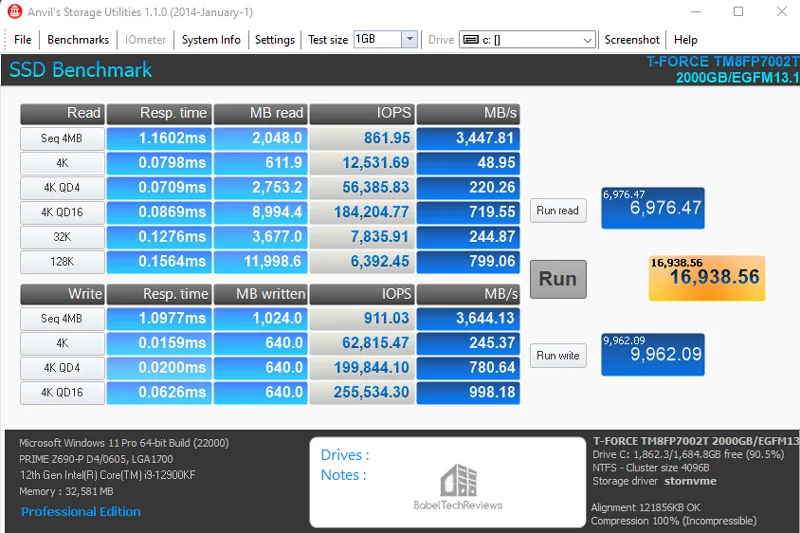
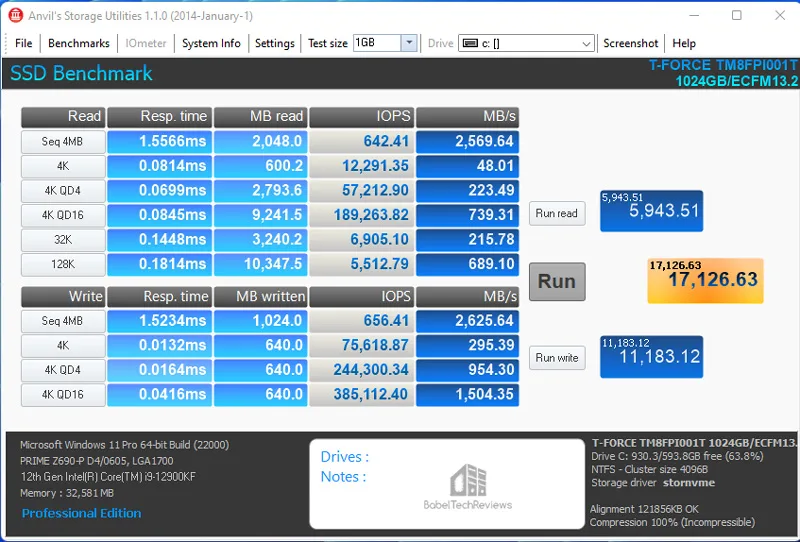
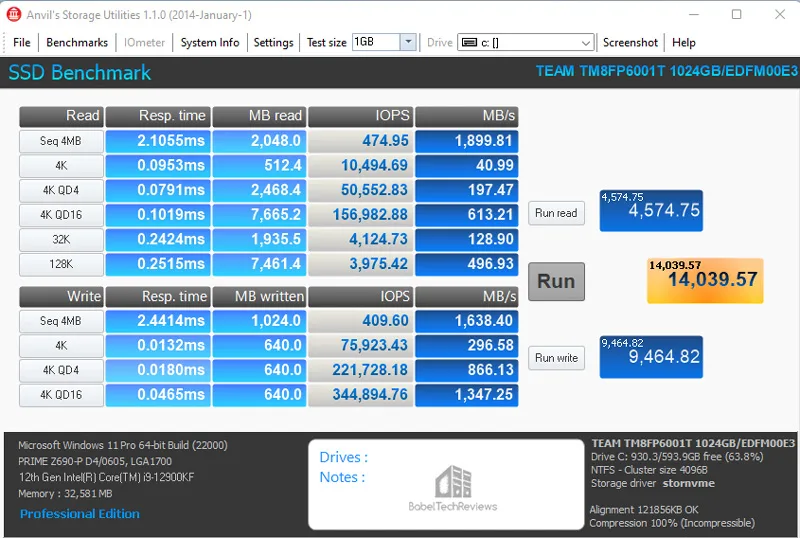
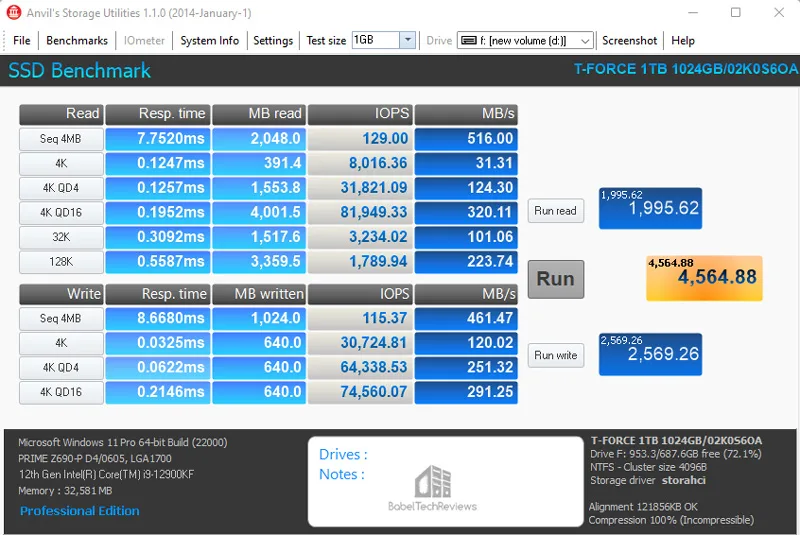

CrystalDiskMark 8.0.4
CrystalDiskMark is a HDD benchmark utility for your drives that measure sequential and random read/write speeds. Here are some key features of “CrystalDiskMark”:
- Measure sequential reads/writes speed
- Measure random 512KB, 4KB, 4KB (Queue Depth=32) reads/writes speed
- Results given in IOPS or MB/s
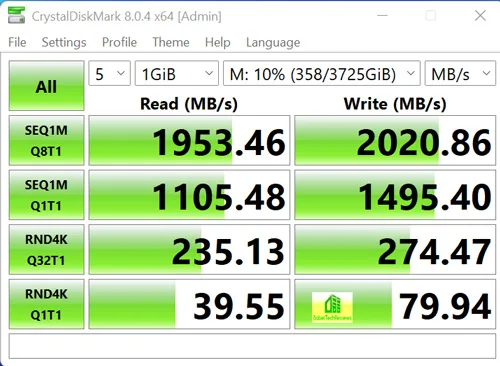

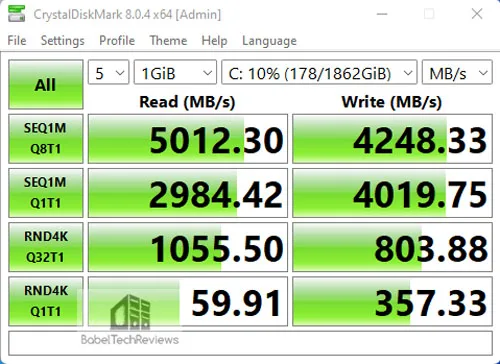
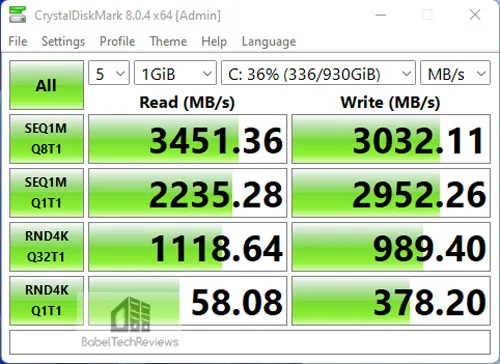
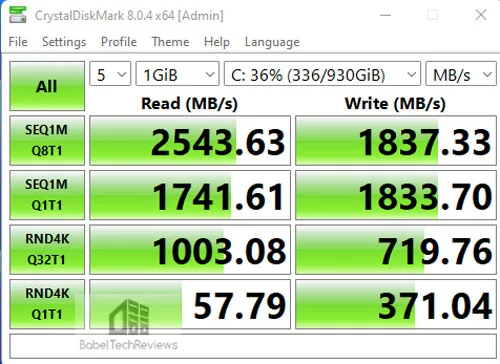

TxBENCH
TxBENCH is similar to CrystalDiskMark but with additional features including secure erase. According to the website, “It not only measures the performance of storage easily but also performs detailed speed measurements based on specified access patterns and long-period speed measurements. It also allows you to see each drive’s supported features, enabled features, and S.M.A.R.T. information.”
First we test the M200 Portable.
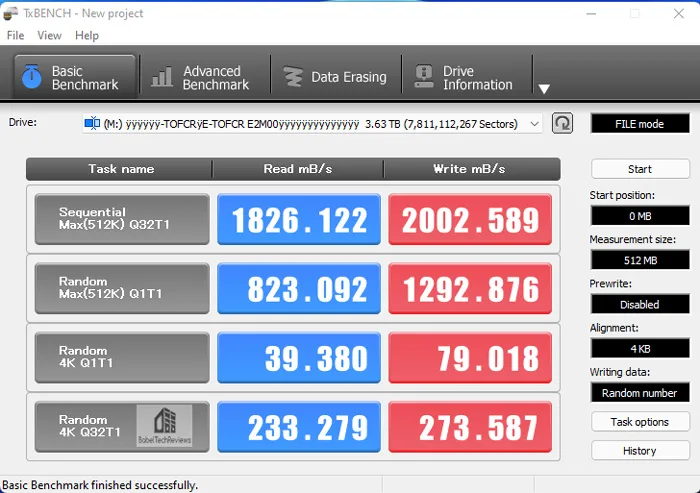
Next we test the A440.  Next the CARDEA Ceramic C440 results.
Next the CARDEA Ceramic C440 results. 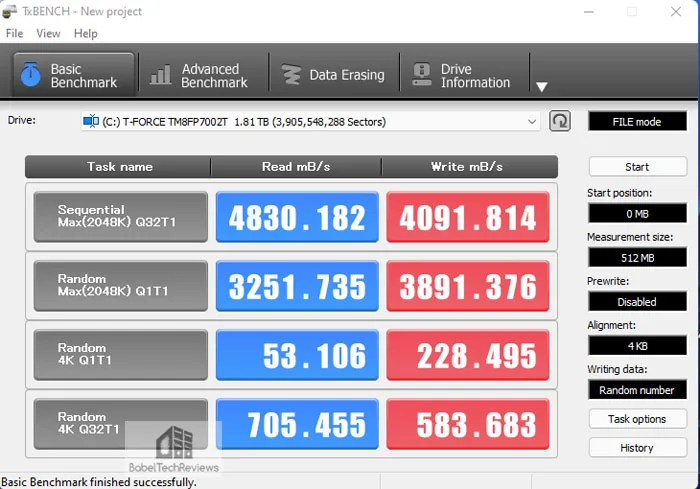 The T-FORCE CARDEA IOPS SSD results are shown below.
The T-FORCE CARDEA IOPS SSD results are shown below. 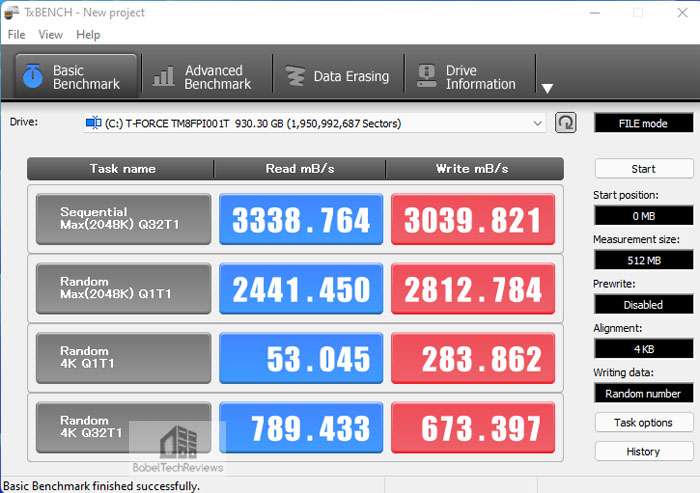

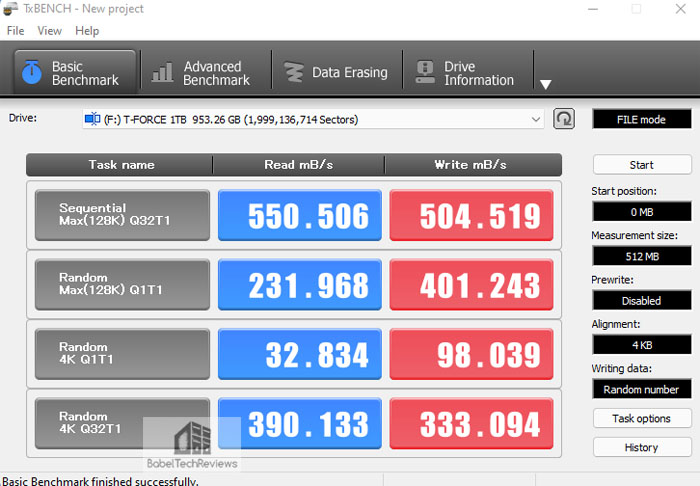

HD Tune
This free standalone synthetic test is old and it doesn’t represent real world performance but it does test some important drive metrics. There is also a pay-for HD Tune Pro which is up-to-date and offers more functionality. We tried the Pro trial recently just to make sure the free version is still relevant. HD Tune has the following functions, and it measures the performance of:
- Transfer Rate
- Access Time
- CPU Usage
- Burst Rate
- Random Access test
- Write benchmark
Hard Disk information includes partition information, supported features, firmware version, serial number, disk capacity, buffer size, transfer mode.
- Hard Disk Health
- S.M.A.R.T. Information (Self-Monitoring Analysis and Reporting Technology)
- Power On Time
- Error scan
- Temperature display

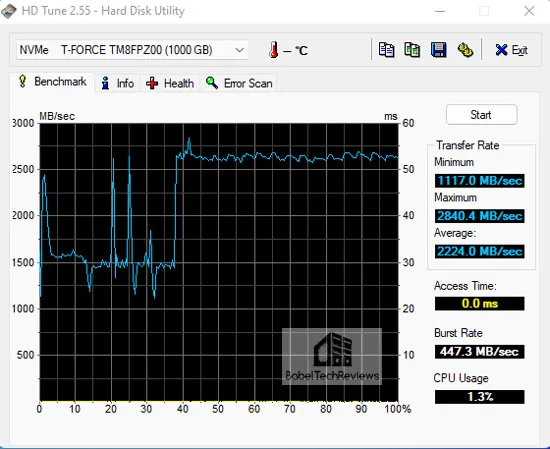

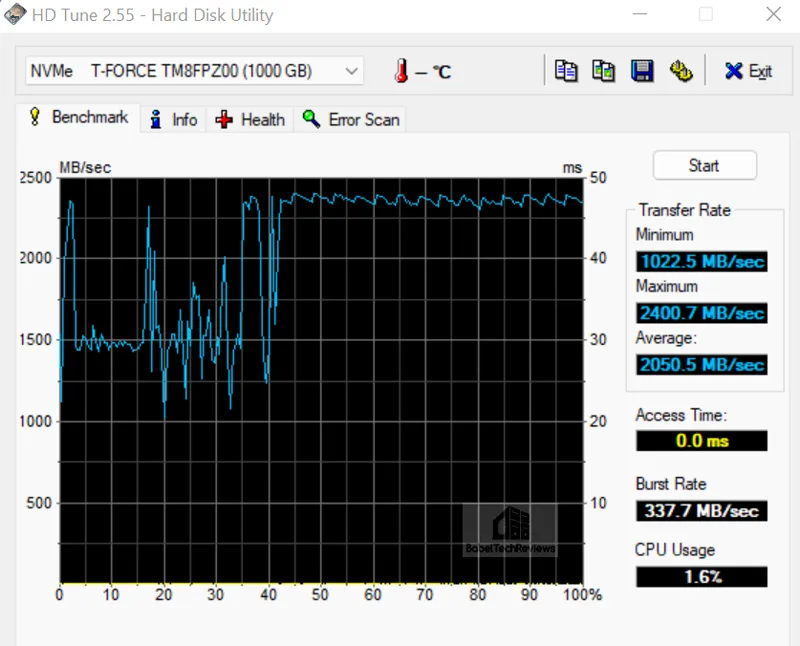
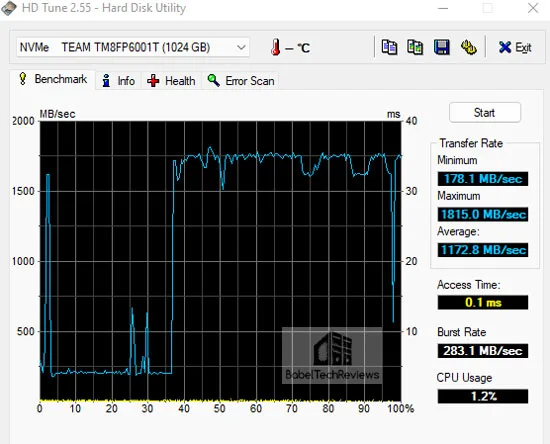
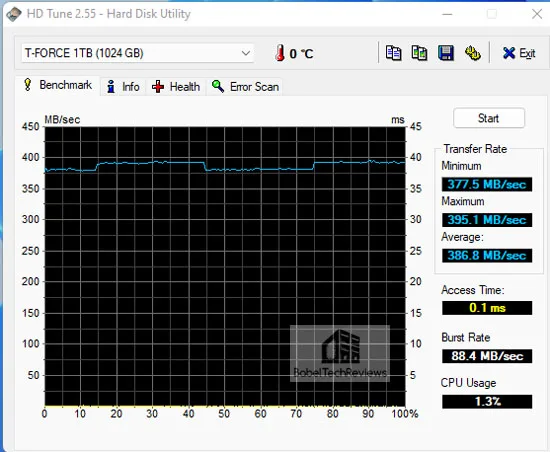
Here are the HD Tune benches summarized by the chart below.

Next, we benchmark using AS SSD.
AS SSD
AS SSD is designed for Solid State Drives (SSD). This tool contains synthetic and practice tests. The synthetic tests determine the sequential and random read and write performance of the SSD without using operating system caches. In Seq-test the program measures how long it takes to read and write a 1GB file.
In the 4K test, read and write performance for random 4K blocks are determined. The 4K-64-thrd test are similar to the 4K procedure except that the read and write operations on 64 threads are distributed as in the usual start of a program. For the copy test, two large ISO file folders are created, programs with many small files, and a games folder with small and large files. These three folders are copied by the OS copy command with the cache turned on. AS SSD gives an overall score after it runs the benchmarks.
Below are the T-FORCE M200 Portable SSD results showing the results in MB/s next to IOPS, and below them, the copy speeds.
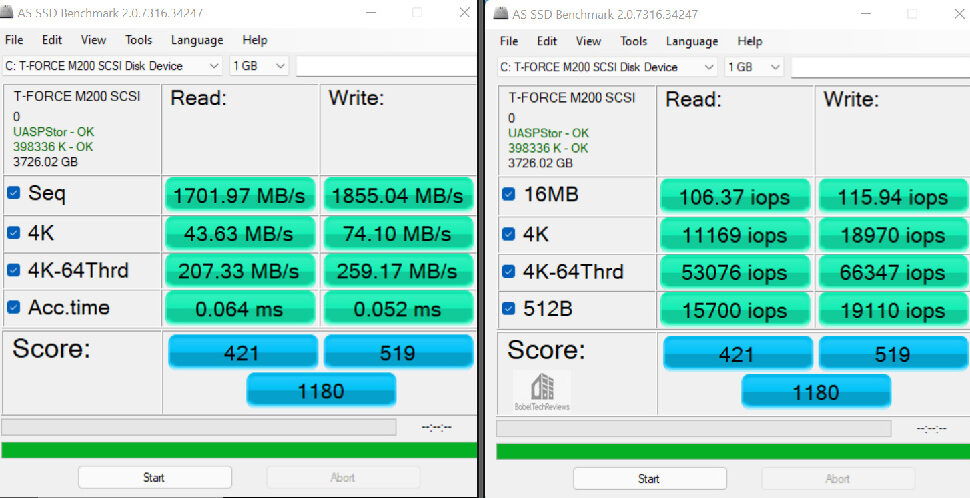
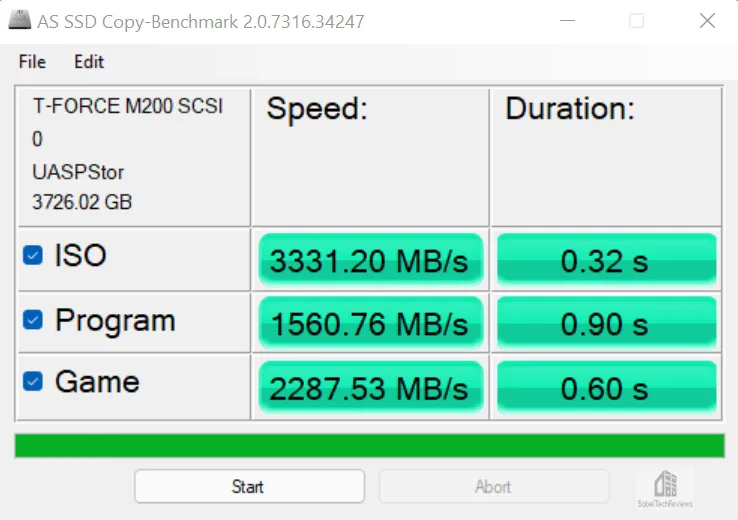
Next are the T-FORCE CARDEA A440 AS SSD results showing the results in MB/s next to IOPS, and below them, the copy speeds. 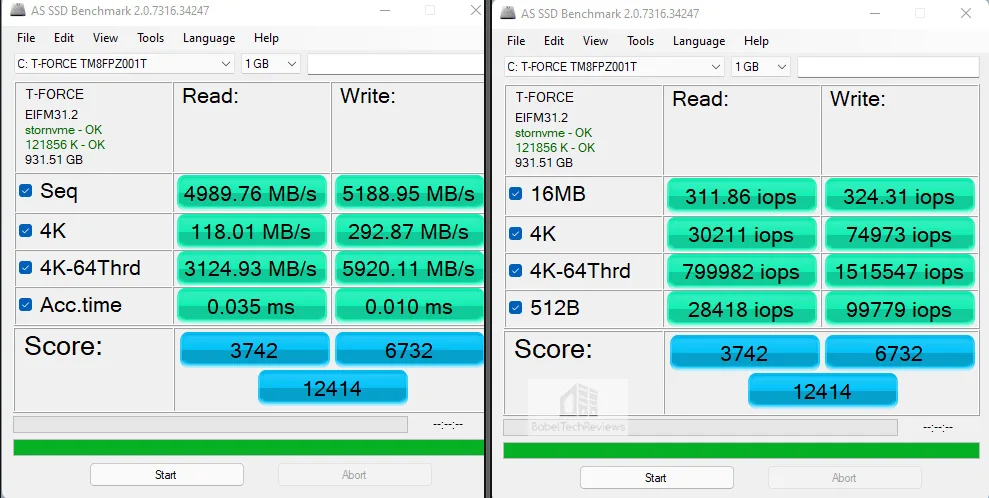
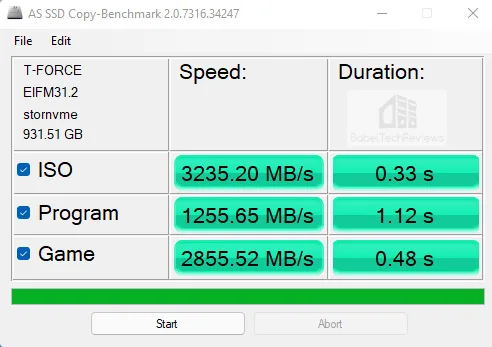 Below are the T-FORCE CARDEA Ceramic C440AS SSD results.
Below are the T-FORCE CARDEA Ceramic C440AS SSD results. 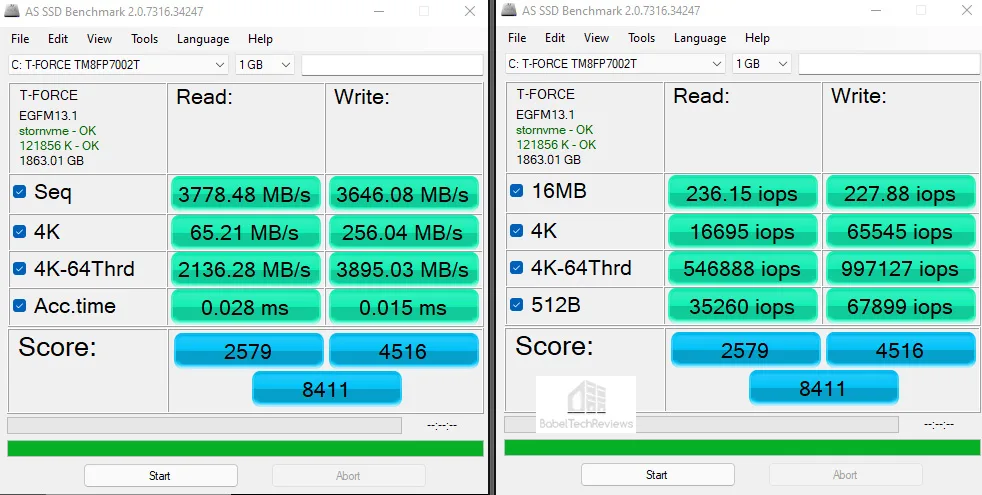
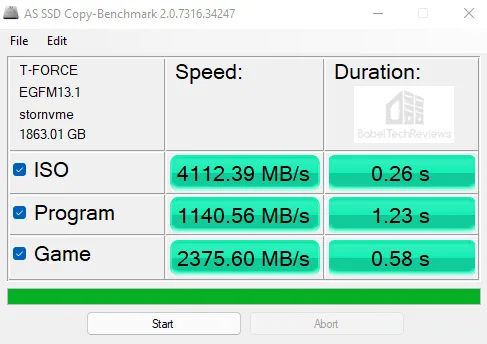 Here are the T-FORCE CARDEA IOPS AS SSD benchmark results.
Here are the T-FORCE CARDEA IOPS AS SSD benchmark results.

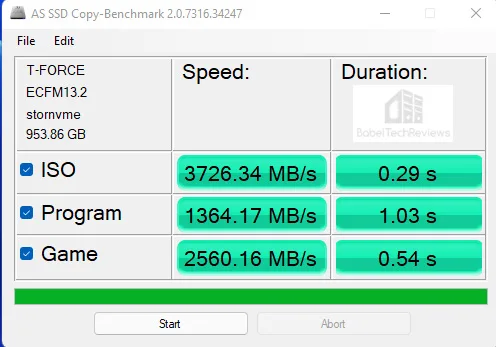

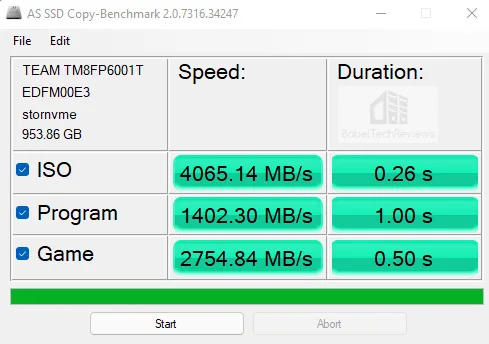
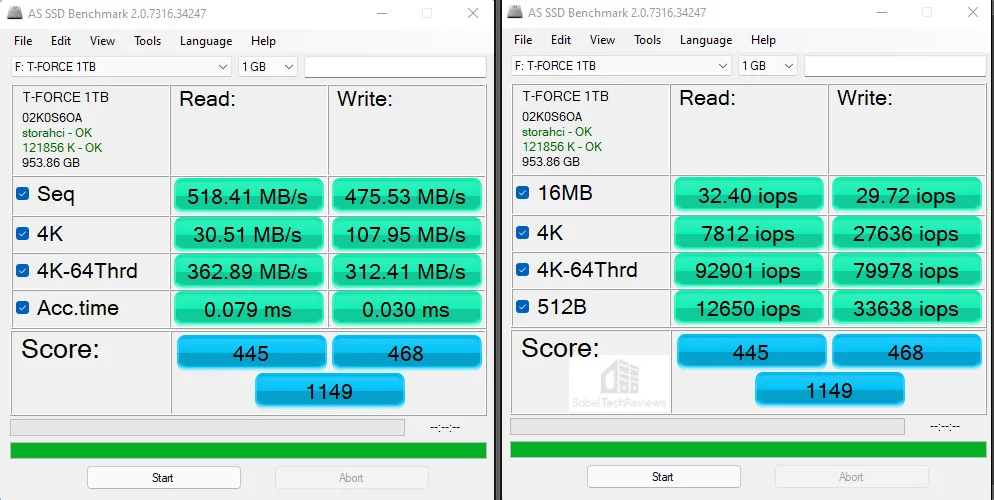


Again, the M200 scores higher than the SATA III drive and its Read speeds are better than the MP33 NVMe PCIe drive.
Next up, ATTO.
ATTO
ATTO is a low level hardware benchmark for random access read/write storage devices including for SSDs and HDDs. HD Tach uses custom device drivers and low level Windows interfaces to determine the physical performance of the device.
The T-FORCE M200 Portable results are first.
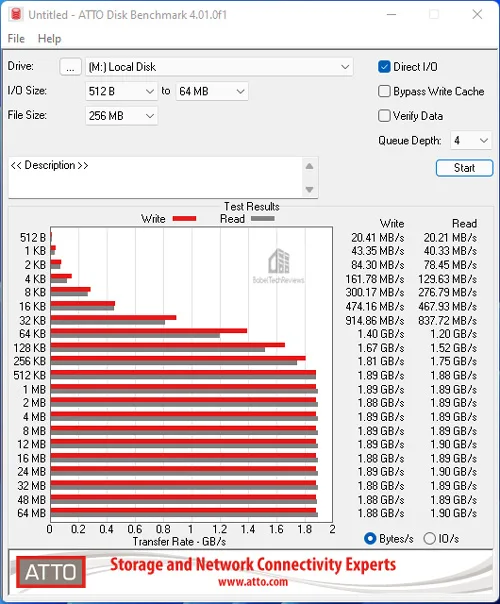
The T-FORCE CARDEA A440 ATTO results are next. 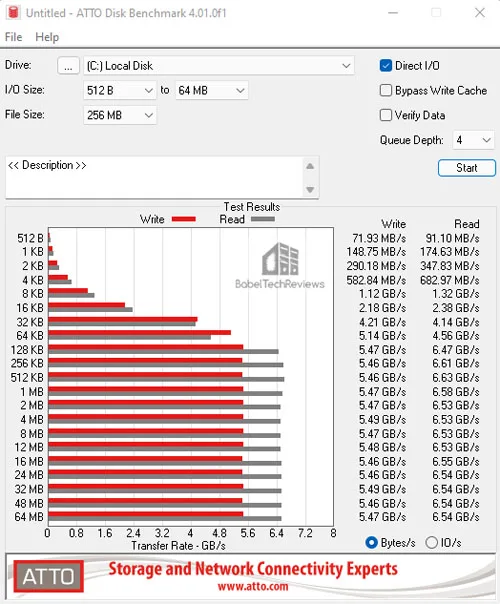
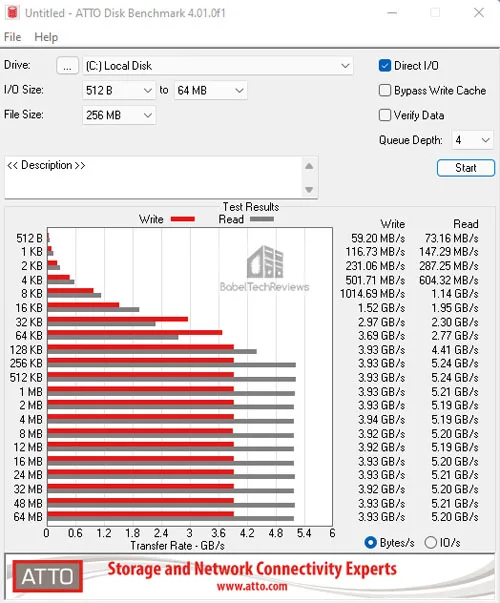
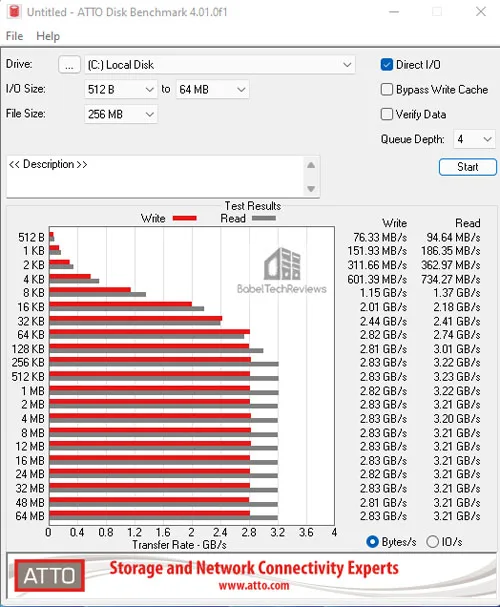
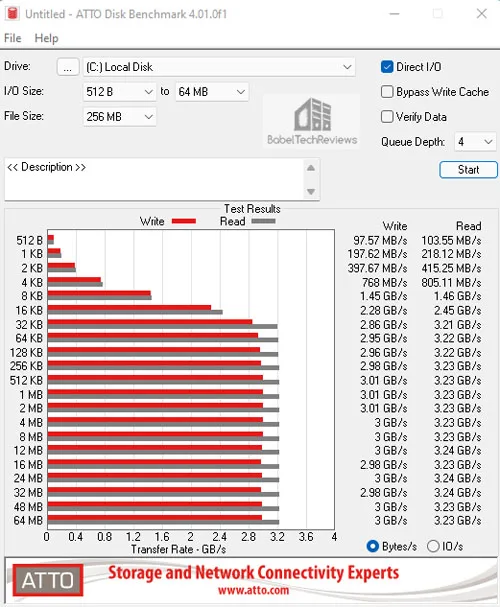

HD Tach is up next.
HD Tach
HD Tach is a low level hardware benchmark for random access read/write storage devices that was developed by Simpli Software. HD Tach uses custom device drivers and low level Windows interfaces to determine the physical performance of the device. It is no longer supported and needs to be run in compatibility mode for Windows 10.
We present the benchmarks first with the Quick benchmark (8MB zones) on the left and the Long benchmark (32MB zones) on the Right.
Here are the M200 HD Tach results with an average read of 646.7MB/s for the Quick bench and 637.4MB/s for the Long bench.
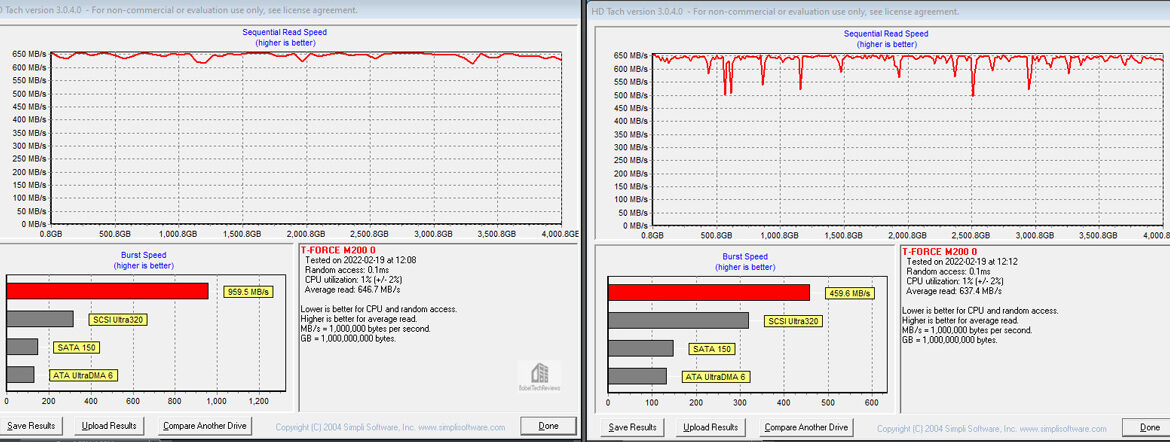
Here are the A440 HD Tach results with an average read of 2212.5MB/s for the Quick bench and 2308.1MB/s for the Long bench. 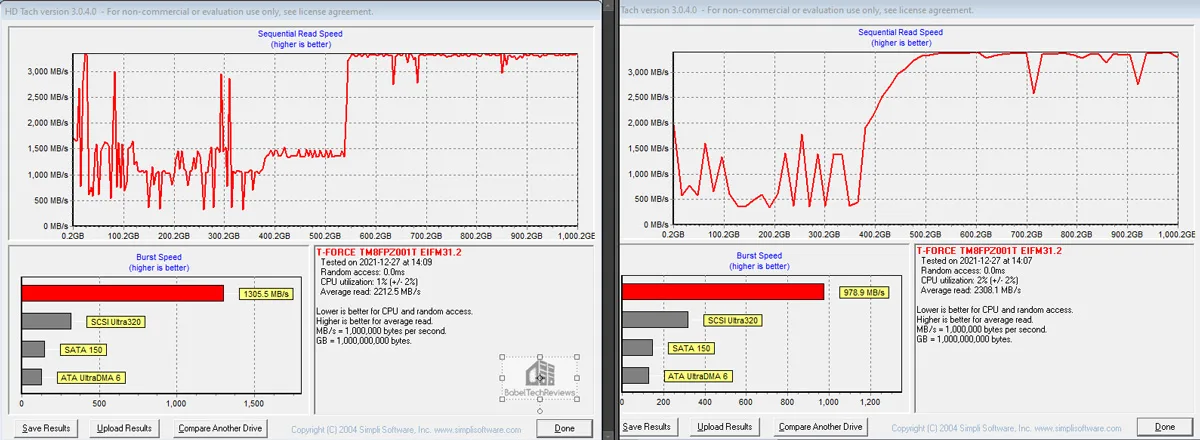 The T-FORCE CARDEA Ceramic C440 HD Tach results give an average read of 2321.0MB/s for the Quick bench and 2150.7MB/s for the Long bench.
The T-FORCE CARDEA Ceramic C440 HD Tach results give an average read of 2321.0MB/s for the Quick bench and 2150.7MB/s for the Long bench.  Below are the T-FORCE CARDEA IOPS HD Tach results with an average read of 2079.7MB/s for the Quick bench and 1822.5MB/s for the Long bench.
Below are the T-FORCE CARDEA IOPS HD Tach results with an average read of 2079.7MB/s for the Quick bench and 1822.5MB/s for the Long bench. 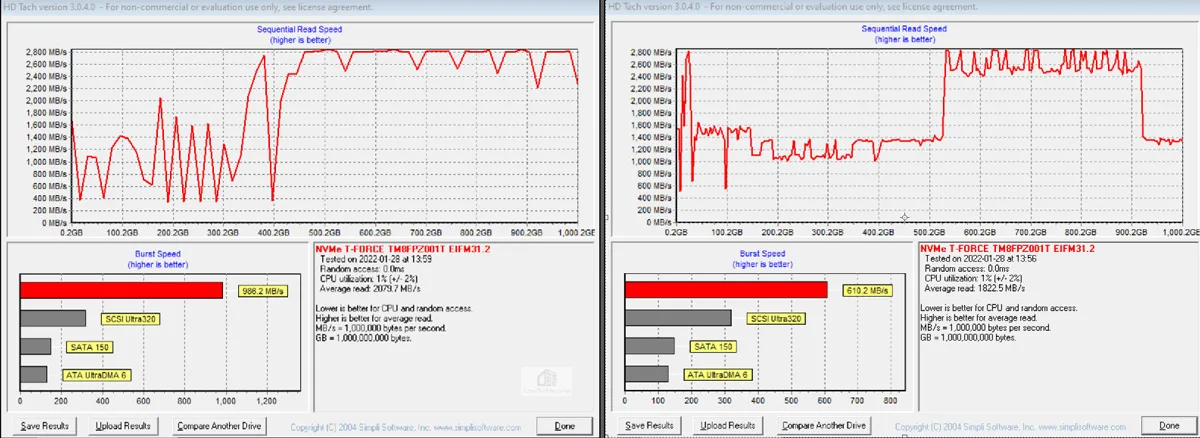 Next, the TeamGroup MP33 HD Tach results show an average read of 1265.8MB/s for the Quick bench and 1198.2MB/s for the Long bench.
Next, the TeamGroup MP33 HD Tach results show an average read of 1265.8MB/s for the Quick bench and 1198.2MB/s for the Long bench. 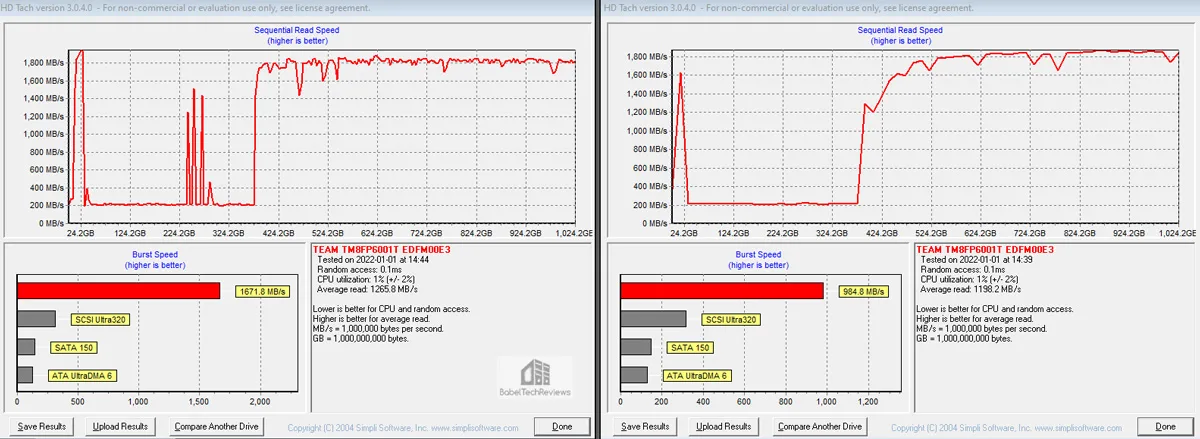 Here are the Delta MAX SATA III HD Tach results with an average read of 409.8MB/s for the Quick bench and 405.8MB/s for the Long bench.
Here are the Delta MAX SATA III HD Tach results with an average read of 409.8MB/s for the Quick bench and 405.8MB/s for the Long bench. 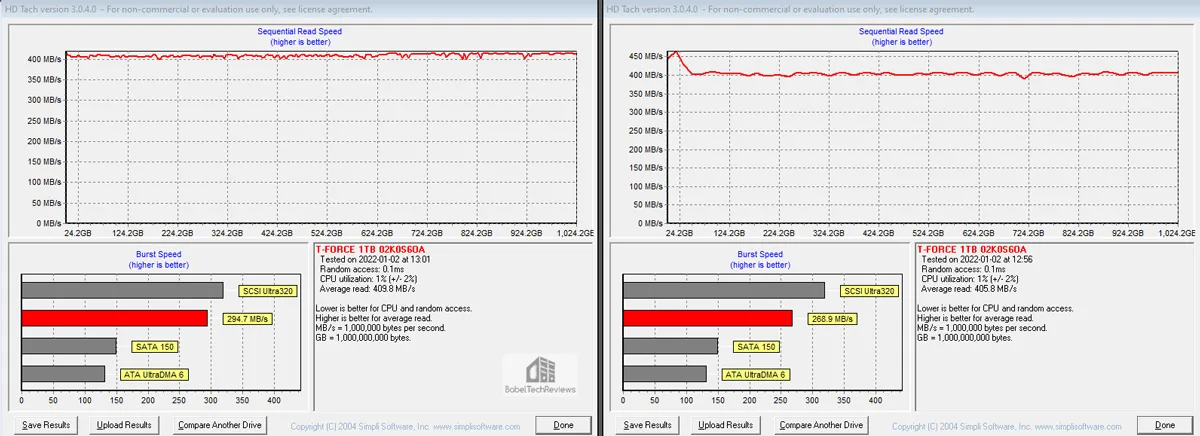 Here are the HD Tach Disk benches summarized in a chart comparing our five drives. For read speeds, higher is better but for access times, lower is better.
Here are the HD Tach Disk benches summarized in a chart comparing our five drives. For read speeds, higher is better but for access times, lower is better.

The CARDEA A440 again generally scores the fastest in HD Tach although the CARDEA C440 trades blows followed by the IOPS, then by the MP33 SSD, followed by the M200 Portable while the SATA III Delta MAX takes last place as usual.
Next we look at game/level loading speeds.
The Game/Level Loading Timed Results – FFXIV
Game and game level loading time results are difficult to measure precisely but generally SSDs perform similarly with regard to game loading times and they all load significantly faster than any HDD. Even SSHDs require loading the same level or program over-and-over to get quicker. We tested 5 levels and overall loading times accurately by using the Final Fantasy XIV: Stormbringer & Endwalker benchmarks.
Shadowbringers Benchmark
The Shadowbringers Benchmark will not only give you accurate framerates averages, it precisely times how long it takes to load each of 5 different levels and the total loading time. We used maximum settings. Let’s start with the Shadowbringer benchmark using the M200.

Total Loading times are 12.204 seconds. We also use the newer Endwalker benchmark and then summarize the results of our six tested SSDs.
Endwalker Benchmark
The Endwalker benchmark is also just as detailed as Shadowbringers and is a very accurate test of loading game and level times.
Here is the Endwalker benchmark using the M200.
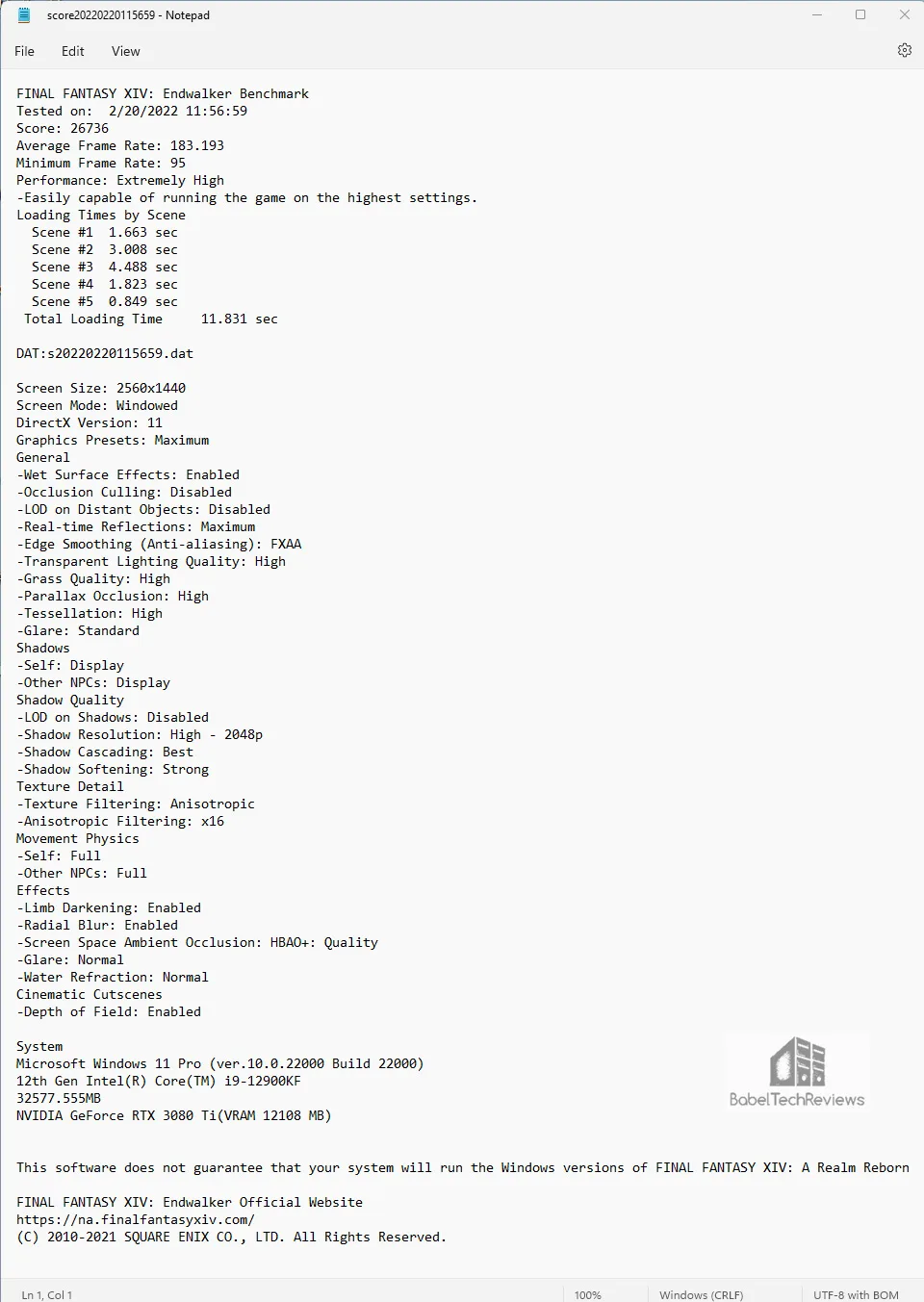
Total Loading times are 11.831 seconds.
Here is the summary chart of Shadowbringers and Endwalker giving all of the level loading and overall loading time comparisons. In addition, the game benches are repeated from PCMark 8.

For all 4 games and multiple levels tested, the CARDEA A440 stands out, followed generally by the C440, the IOPS, the MP33, and then the M200 Portable trade blows with Delta MAX. We only see a 2-3 second difference between our fastest SSD and our slowest SSD making the M200 a suitable external drive for gamers – either as C:drive with Windows installed, or for storage. Any of these SSDs are suitable for loading games quickly and far faster than any hard drive or solid state hard drive can hope to achieve.
However, until developers start to target SSDs for PC game storage, then we may see SSDs fully achieve the game loading performance they are capable of on Windows.
Lets look at file copy speeds next.
File Copy 102GB
File copy speeds are important to gamers especially when they want to quickly transfer their game files from one location to another. We copy a 102GB folder containing Horizon 5 from its Steam folder to a desktop folder which is something we do regularly when setting up Steam games on multiple PCs. Pay careful attention to the charts (in green) that show the consistency and speed of file copies. They tend to show the ups and downs where each SSD runs out of cache and how long it takes to empty and refill it.
102GB File Copy
The M200 Portable took 4 minutes and 5.0 seconds. to copy 102GB.

The A440 took 1 minutes and 44.0 seconds. to copy 102GB.  The Ceramic C440 took 1 minutes and 59 seconds for the same copy.
The Ceramic C440 took 1 minutes and 59 seconds for the same copy.
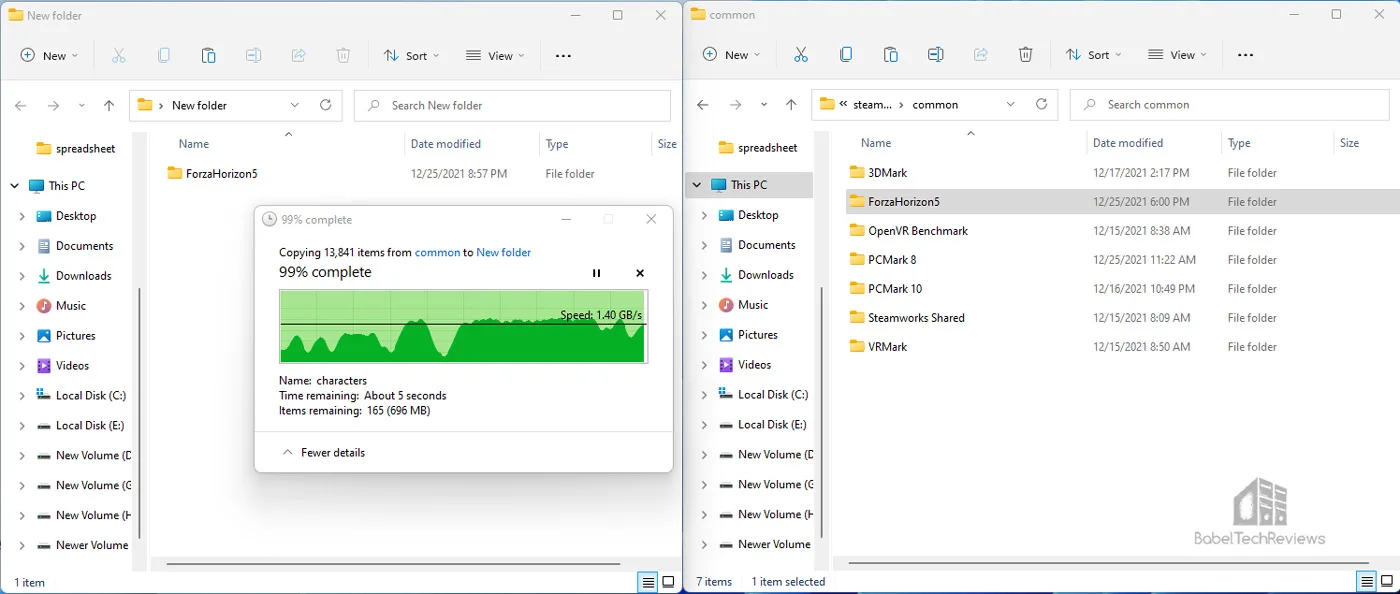
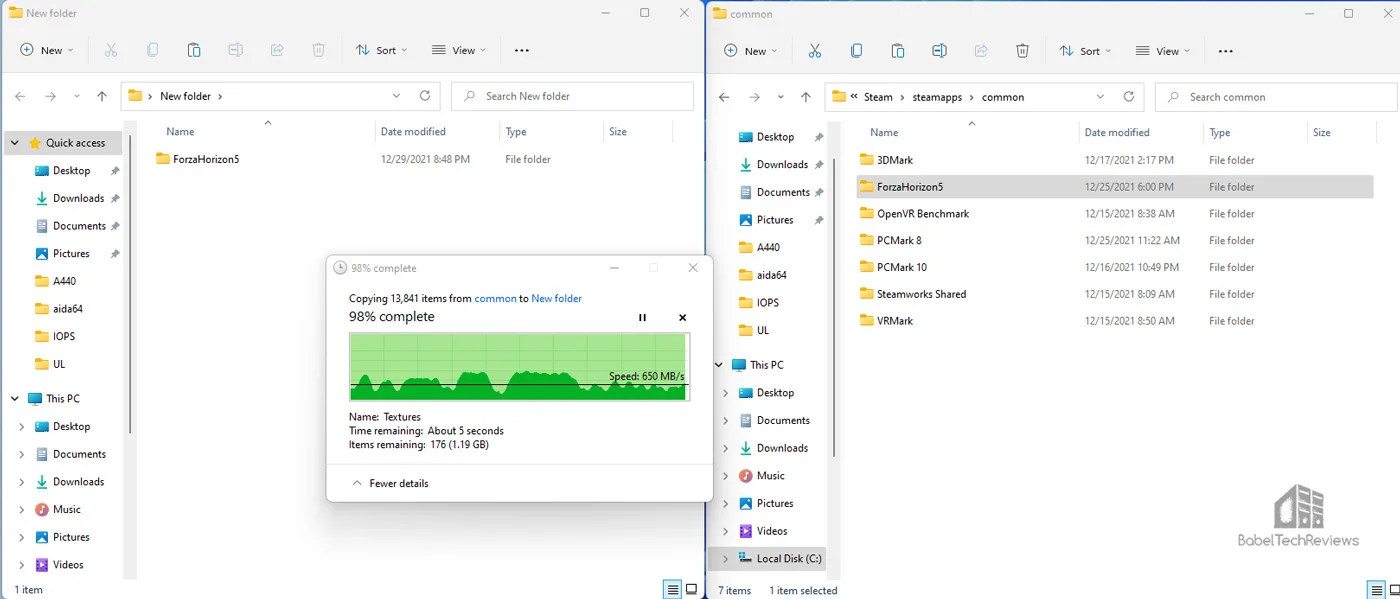
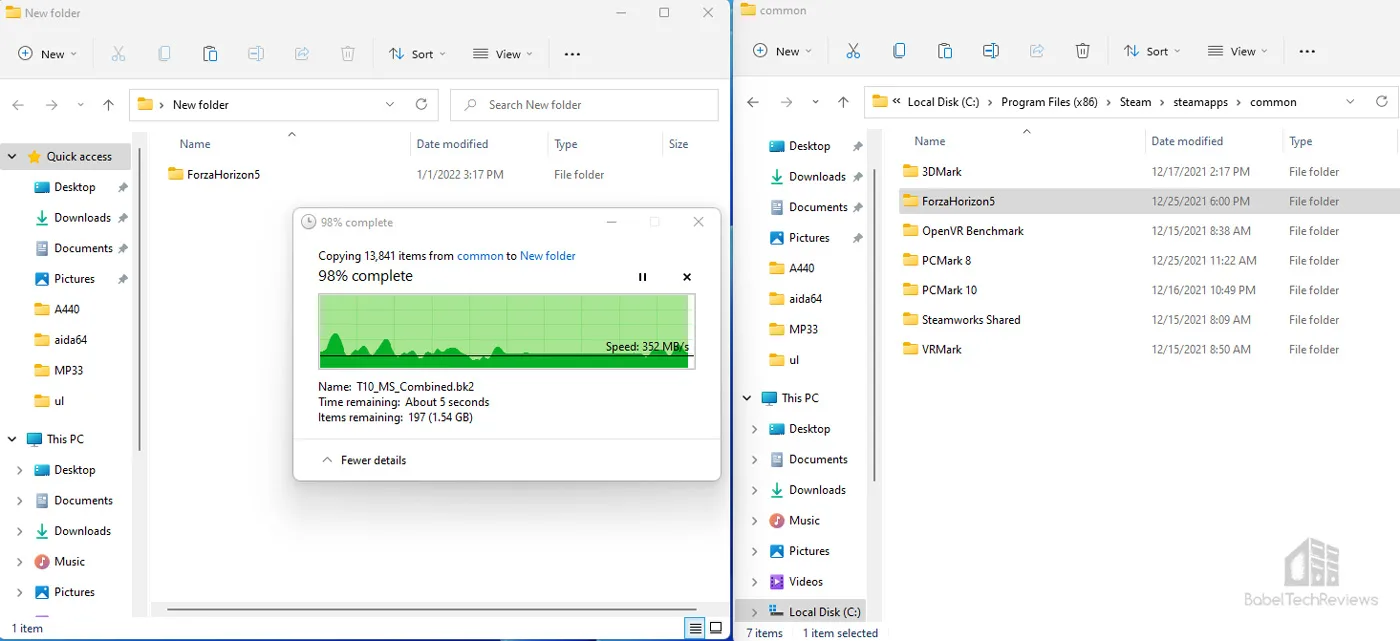


The CARDEA A440 SSD excels at copying along with the other Gen 4 x4 SSD, the C440, compared to any of our other tested SSDs. The IOPS comes in third place ahead of the M200 Portable SSD in fourth which is faster than the MP33 SSD which is in turn faster than the Delta MAX SATA III SSD.
Even a SATA III SSD is much faster than any HDD or SSHD for copying large files and the M200 is almost two-and one-half times faster than a fast SATA drive making this external drive quite suitable for large file copying. Consider taking a nap if you are going to copy 102GB using a hard drive.
Finally, let’s revisit game/level loading times plus all of our Summary charts and then reach our conclusion.
Summary Charts and Conclusion
Here are all of the gaming and summary charts again for easy reference followed by our conclusion.
The Game/Level Loading Time Results
Game and game level loading time results are difficult to measure precisely (such as by using a stopwatch) but our tests are far more consistent. Here are the World of Warcraft and Battlefield 3 loading times again as measured precisely by PCMark 8’s storage test and accurately by Final Fantasy XIV: Stormbringer/Endwalker’s benchmarks. Lower (quicker/faster) loading times (measured in seconds) are better. PCMark’s Storage Benchmark also provides precise SSD bandwidth, loading times, game record, install, and save time comparisons.


All six SSDs load games quickly and the external M200 drive is generally faster than a fast SATA III SSD making it very suitable for an operating system drive or as a storage drive. After PC game developers start to target SSDs for game storage, only then may we see SSDs achieve the super-fast game loading performance they are capable of. Until then, console gamers can take advantage of the M200’s fast loading speeds.
Non-Gaming Summary Charts
Here are all of the summary charts presented again in one place.













A gamer who wishes to have the very fastest PC will choose an internal PCIe 4.0 Gen 4 x4 NVMe SSD. The CARDEA IOPS slots into third place ahead of the TeamGroup MP33 SSD, then the M200 Portable SSD, and finally the Delta MAX SATA III SSD is always in last place.
For gaming and for regular tasks on current PC platforms, any SSD will provide decent game and level loading performance well above that of mechanical hard drives or even hybrid (SSHD) drives and we now see that a portable USB 3.2 Gen 2×2 drive can easily beat internal SATA drives and even compete with some PCIe Gen3 NVMe drives.
Let’s head for our conclusion.
The Conclusion & Verdict
We would suggest that 1TB has become the minimum storage capacity for a gamer that includes the operating system since PC games have grown so large. It still is not mandatory to have a SSD if you only use your PC for gaming and have a lot of patience. Games do not perform significantly better on SSDs since most PC developers still target HDDs for game performance optimization. However, games usually take significantly longer to load from a HDD or SSHD than they do from any internal SATA III drive or even from an external USB 3.0 SSD.
If a gamer wants to get right back into the game, any SSD will improve immersion and decrease frustration compared with using a HDD or SSHD. Windows 10/11 have become positively painful to use when installed on a mechanical or even on a hybrid solid state/hard disk drive. Indexing, Search, or Anti-malware Windows programs often saturate the bandwidth of a mechanical drive, and even downloading or updating Steam games will slow your PC to an irritating crawl. This will not happen using a SATA III SSD or a fast external SSD like the M200 Portable.
As SSD pricing decreases there may no longer be a need for using HDDs for storage or for back-up especially if time matters. At just under $600, the 4TB M200 is expensive but it offers portability and very fast read/write speeds that greatly exceed the fastest SATA III drives, and it is flexible so as to be used as either a C:drive or for quickly loading games as storage drive.
Based on performance and price, we recommend the 4TB T-FORCE M200 portable SSD as a competitively-priced, fast, cool-running, and good-looking SSD for any use. A five year warranty backed by TeamGroup insures that a player will enjoy fast performance for years to come. The M200 is ruggedly built and also likely to survive a 6 foot drop onto a carpeted floor with its data intact unlike most hard drives or SATA SSDs.
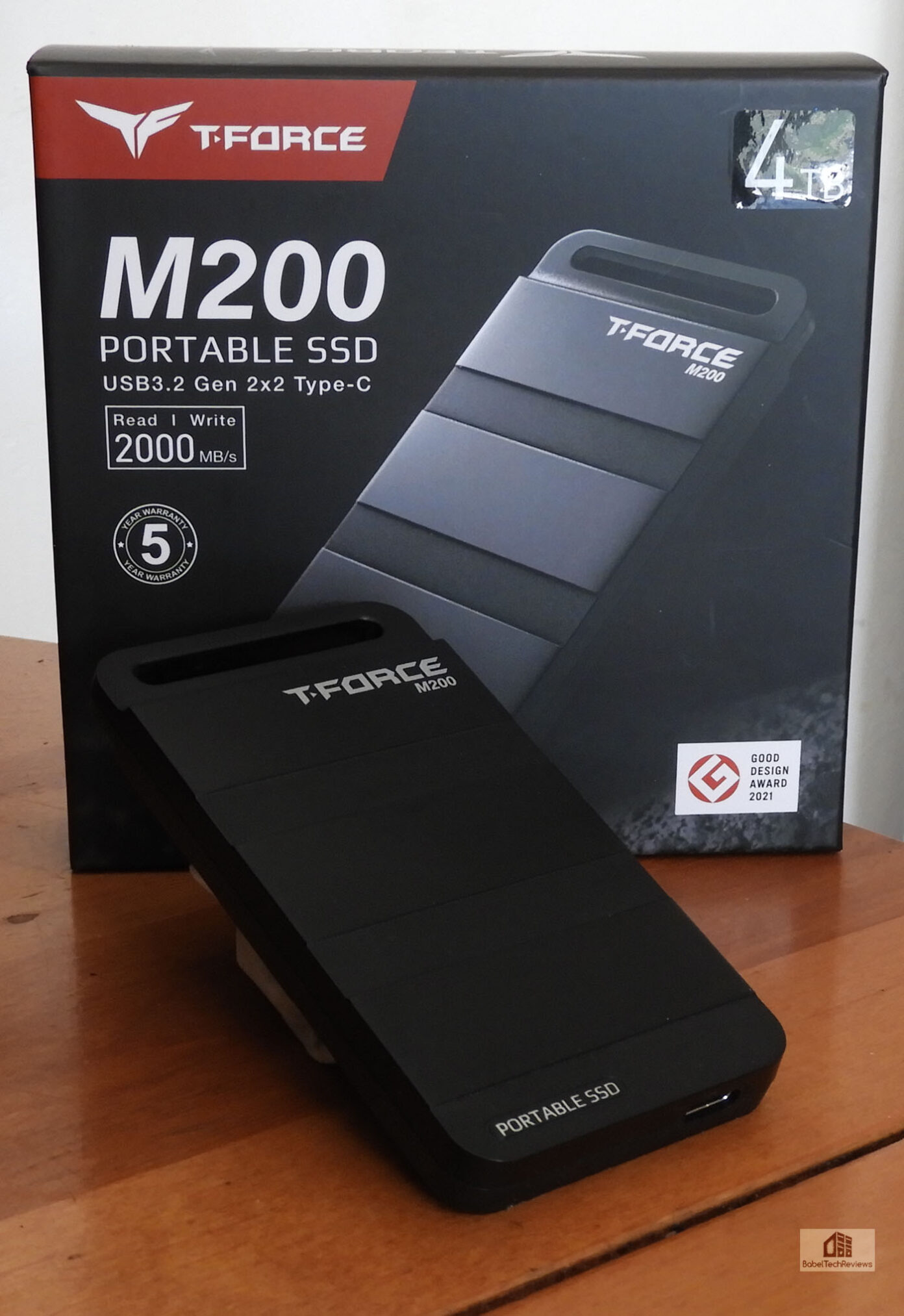
Pros
- 5-year warranty backed by TeamGroup support
- Fast game/level loading speeds and very fast large file copy speeds
- Well-made and durable for portability together with style that increases its cooling capability
- The M200 is priced competitively with other USB 3.2 Type C Gen 2×2 SSDs
Cons
- Price, but then 4TB SSDs are expensive
- No IP-rating; not water resistant
The Verdict
 The T-FORCE M200 portable SSD deserves BTR’s Editor’s Choice Award.
The T-FORCE M200 portable SSD deserves BTR’s Editor’s Choice Award.
Stay tuned as Rodrigo is currently working a DDR4 review followed by a GeForce driver performance analysis. We will follow it next-week by continuing our DDR5 series focusing on latency using a 2x16GB G.Skill Trident Z5 6000 CL36 kit versus an identical kit at CL40 using our 31-game benchmark suite and extensive suite of applications.
Happy Gaming!
